Published with permission from Mike Movius, President, CWRT Congress, www.cwrtcongress.org.
This survey was conceived as more of an informational instrument than one with serious overtones for CWRTs to heed. And yet, there are some interesting patterns that should be examined.
Overall, there were 195 total respondents. We did not seek to differentiate between members and their leaders. The completion rate was 77% and on average, it took respondents 4 minutes to complete.
Summary
This survey illustrates the kind of CWRT member who subscribes to Civil War publications. I will attempt to describe him/her in broad terms:
1. A true reader—One who reads a majority of publications to which a subscription is paid, reads and enjoys other reading materials that are described in the publication.
Civil War Publication Survey Survey Analysis
2. Most interested in leaders, strategy and tactics, campaigns, battles and skirmishes.
3. Shares the reading material with others including for the betterment of the CWRT.
On the other hand, in a time when most CWRT members decry the lack of American history education in our public schools, most do not avail themselves of
sharing their publications with schools, teachers, or libraries. It is up to us to take a stand for public history education. Although the school district where we live will not allow Civil War material in their midst, there are other environments where students are supported in their curiosity about the making of America by adults who understand the value of history.
Q1: Do you subscribe to one or more Civil War publications?
• Downsizing
• I find I have so much to read, and sometimes they are so detailed that I lose interest
• Subscribed to many CW mags from 1965 to 2005. Stopped all subscriptions at that time
• Topics have usually been covered many times before
Q3: To which publications(s) do you subscribe?
Our initial assumption was that many, if not most, CWRT members subscribe to a Civil War publication. The results from the first question confirms that assumption. Sixty-six percent subscribe to one or more such publications.
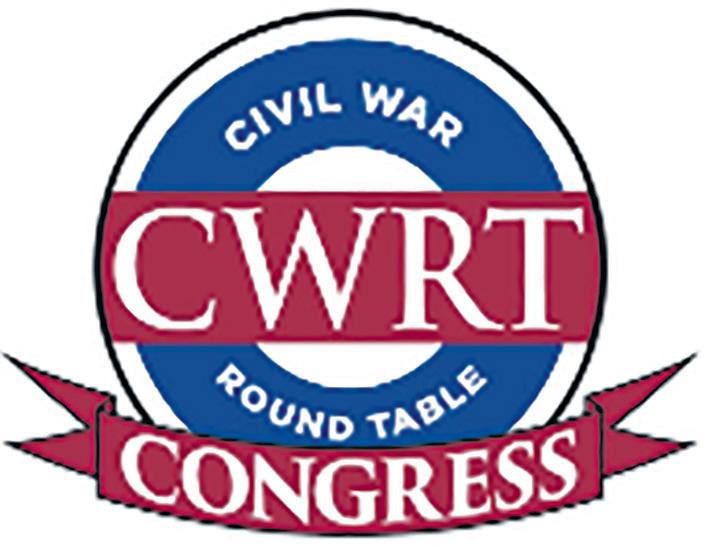
Q2: Why don’t you subscribe to a Civil War publication?
64 Other Responses:
• I may be re-subscribing to North and South soon. It and Blue & Gray are/were the gold standards for ACW magazines.
• Too many of the same type of articles in mags. I choose on topics that I have an interest in.
• Some lean way too far to one side of the war
• Shared by other subscribers
• Previously subscribed to CW Times and Camp Chase
• Most seem to rehash old stories
• Get at store
• Buy them off the rack
• Topics too politically correct
• Changes in editorial policies
• Not enough value
• Would rather read a Civil War book instead
• Too many other interests
• Have not seen Civil War magazines recently
• Have not found one that consistently piques my interest
• Have many books and online sources to read
• Blue & Gray ceased publication recently
• I have hundreds already. Now I go to the American Battlefield Trust or Emerging Civil War.
CW N Vol. 46, No. 8 48 Pages, August 2020 $3.50 America’s Monthly Newspaper For Enthusiasts Inside this issue: 25 – American Battlefield Trust 47 – Advertiser Index 14 – Black Powder White Smoke 40 – Book Reviews 17 – Central Virginia BT 34 – Emerging Civil War 26 – The Graphic War 28 – Inspection, ARMS! 2 – Letters to the Editor 20 – The Source 18 – The Unfinished Fight 32 – This And That 22 – Through The Lens 13 – Trivia
Answer Choices: Responses: Respondents: Yes 66.15% 129 No 33.85% 66 Total Respondents: 195
Choices: Responses: Respondents: Too expensive 25.00% 16 Not enough time to read 48.44% 31 Rather search my own topics 20.31% 13 Too many errors to take seriously 0.00% 0 Not familiar with CW magazines 15.63% 10 Other (please specify) 34.38% 22 Total Respondents:
Answer
Answered:
Skipped: 73 Answer Choices: Responses: Respondents: America’s Civil War 39.34% 48 American Digger 0.00% 0 American History 4.92% 6 The Artilleryman 4.92% 6 The Avalon Hill General 0.00% 0 Blue & Gray 22.13% 27 Cavalry Times 0.00% 0 Charge! 0.00% 0 Civil War Courier 3.28% 4 Civil War from A to Z 0.82% 1 Civil War Monitor 48.36 59 Civil War Navy 9.84% 12 Civil War News 36.89% 45 Civil War Quarterly 1.64% 2 Civil War Times 55.74% 68 Confederate Veteran 4.92% 6 De Bow’s Review 0.00% 0 Frank Leslie’s Illustrated News 0.82% 1 The Gettysburg 18.85% 23 Harper’s Weekly 0.82% 1 History 0.00% 0 Leatherneck 0.00% 0 Military Heritage 2.46% 3 Military History 4.10% 5 Muzzleloading Artilleryman 0.00% 0 Naval History 2.46% 3 North & South 24.59% 30 North South Trader’s Civil War 4.10% 5 On Point: Journal of Army History 0.82% 1 Shipmate 0.82% 1 Smithsonian 15.57% 19 Southern Bivouac 0.00% 0 Southern Historical Society Papers 0.82% 1 Southern Partisan 0.82% 1 Taps 0.00% 0 United States Service 0.00% 0 Western & Eastern Treasures 0.00% 0 West Point .082% 1 Other (please specify) 20.49% 25 Total Respondents: 122 H Survey . . . . . . . . . . . see page 30
122
CWN
Published by Historical Publications LLC
520 Folly Road, Suite 25 PMB 379, Charleston, SC 29412
800-777-1862 • Facebook.com/CivilWarNews
mail@civilwarnews.com • www.civilwarnews.com
Advertising: 800-777-1862
• ads@civilwarnews.com
Jack W. Melton Jr. C. Peter & Kathryn Jorgensen
Publisher Founding Publishers
Editor: Lawrence E. Babits, Ph.D.
Advertising, Marketing & Assistant Editor: Peggy Melton
Columnists: Craig Barry, Joseph Bilby, Matthew Borowick, Salvatore Cilella, Stephanie Hagiwara, Gould Hagler, Tim Prince, John Sexton, and Michael K. Shaffer
Editorial & Photography Staff: Greg Biggs, Sandy Goss, Michael Kent, Bob Ruegsegger, Gregory L. Wade, Joan Wenner, J.D.
Civil War News (ISSN: 1053-1181) Copyright © 2020 by Historical Publications LLC is published 12 times per year by Historical Publications LLC, 520 Folly Road, Suite 25 PMB 379, Charleston, SC 29412. Monthly. Business and Editorial Offices: 520 Folly Road, Suite 25 PMB 379, Charleston, SC 29412, Accounting and Circulation
Offices: Historical Publications LLC, 520 Folly Road, Suite 25 PMB 379, Charleston, SC 29412. Call 800-777-1862 to subscribe.
Periodicals postage paid at U.S.P.S. 131 W. High St., Jefferson City, MO 65101.
POSTMASTER: Send address changes to: Historical Publications LLC 520 Folly Road Suite 25 PMB 379 Charleston, SC 29412
Display advertising rates and media kit on request.
The Civil War News is for your reading enjoyment. The views and opinions expressed herein are those of its authors, readers and advertisers and they do not necessarily reflect the official policy or position of Historical Publications, LLC, its owners and/or employees.
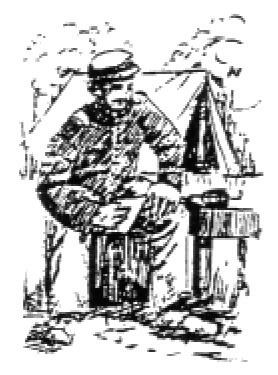
P
UBLISHERS
:
Please send your book(s) for review to: Civil War News
520 Folly Road, Suite 25 PMB 379 Charleston, SC 29412
Email cover image to bookreviews@civilwarnews.com. Civil War News cannot assure that unsolicited books will be assigned for review. Email bookreviews@civilwarnews.com for eligibility before mailing.

ADVERTISING INFO:
Email us at ads@civilwarnews.com Call 800-777-1862
MOVING?
Contact us to change your address so you don’t miss a single issue. mail@civilwarnews.com • 800-777-1862
SUBSCRIPTION RATES
U.S. Subscription rates are $38.50/year, $66/2
From The Editor:
On Monuments and the Silent Majority
On June 22, in the dead of night, the Confederate soldier monument in Greenville, N.C., came down. It offended people. The next day, one of the leaders for getting the city to take it down, said it was just the start.
In cities across the country, monuments are being removed for “storage in a safe place” as one official put it. Others are being vandalized and damaged with police standing by doing nothing despite laws saying the activity is illegal because they have been told to “stand down.” Many statues have nothing to do with the Civil War, slavery, or the Confederacy. Even a U.S. Grant statue was toppled and the 54th Massachusetts Infantry (the “Glory Regiment”) was vandalized.
CWN is not covering the destruction, vandalism, and sudden removal of multiple Confederate monuments as individual stories.
The topic is so extremely controversial,and there are so many examples, that coverage would not only take up the entire monthly CWN issue, it is a no-win topic. Our coverage would anger and raise the blood pressure of
both sides because we would try to present a balanced view. We recognize that this destruction of symbols is occurring and that it represents a dangerous shift in attitudes and official complicity, but to continually beat the horse would not be in anyone’s interest to rail against anonymity and would serve to keep the issue alive and that seems to be what one faction wants.
For many of us, this is destruction of history, not my history, or our history, but just simply history. When these monuments are gone, as the one in Greenville, where do the rallying points and teaching moments appear? A lesson can be seen in more recent German history. Many extermination and forced labor camps are still there, albeit in reduced form, precisely because they serve as reminders of something truly evil. They are visited every year by student classes who are told, in precise language, exactly what happened there, and made to confront their past, a past within living memory, a past that must be repeated.
The narrow minded, rush to judgment, do it now, demonstrators fail to see how important these monuments are to them and their crusade for justice. They are so off the mark! They seem to fear the past; but the monuments should serve to remind them, “never again!” in the words of the Jewish Defense League comment about the Holocaust. What if, instead of tearing down a monument to a county’s dead Confederates, they moved to erect a monument to the U.S. Colored Troops, some of whom came from the same
county, or to the county residents who fought in Union regiments. The teaching moment is here but they are missing the point. There’s another aspect to this; Americans tend to joke about the crook, rustler, or ancestor hung for piracy because it stands out. A hundred years ago, people used to joke about having an Irish, Italian, Hungarian, Yankee, or adopted ancestor. Note that I’ve deliberately not said Native American or African ancestor, even though they might well have influenced a family’s lineage, and vice versa, because political correctness and personal sensibilities might be affronted. That omission is telling, but it really is a teaching moment for both sides of the political correctness prism. More importantly, once it is recognized, confronted, and dealt with, it becomes another thread that helps hold our nation together.
At the same time, the silent majority does little or nothing, just sitting by, knowing that school curricula are no longer talking about slavery and America’s past. One letter writer said Black Confederates are irrelevant, but they really are relevant; they show that a national people have a great many variations and that nothing is either black nor white; they form a crazy quilt of emotional highs and lows. For the future, it is time to stop tearing things down and start building things again and teaching about our national failures just so we don’t repeat them. If there is no rallying point to call attention to some part of our past that was wrong, or really bad, how can focus be brought to bear on the problem?
Larry Babits CWN Editor
TO THE EDITOR:
I was struck by the lead article in your June issue: Fact or Fiction? Black Confederates. I’ve seen this matter discussed in a wide variety of venues and with an almost equal number of flat denials and fervid assertions. Frankly, the subject is simply irrelevant!
Now we know that there were black soldiers in gray whatever their status, slave or free. We have the testimony of Frederick Douglass—hardly an advocate of the Confederacy—who commented upon seeing them as he gazed across the lines. And there is other equally credible testimony on the subject to put the matter to rest if permitted! But, as noted, if the whole subject is irrelevant, why the need to pursue it by both sides? Simple: there is an understanding, especially by advocates of the South, that the
existence of blacks fighting for the Confederacy legitimizes their cause. Nonsense! It no more validates the cause of the South than do blacks fighting in blue validate the cause of the North. A cause is not vindicated by the people who fight for it.
It is the same regarding secession. The States of the South had every right to secede from a
“union” that had become a burden to them and their citizens just as the New England States had the right to secede during the war of 1812. That they chose not to do so in no way nullifies the fact that they met in convention and voted on the issue. It is said that the Constitution is silent on secession. Not so! When three of the States—Virginia, New York,
2 CWN August 2020
years, digital only $29.95, add digital to paper subscription for only $10/year more. Subscribe at www.CivilWarNews.com CIVIL WAR AUTOGRAPHS LETTERS • DIARIES • STAMPS • CURRENCY Price List Online • Top Price Paid for Quality Material BRIAN & MARIA GREEN P.O. Box 1816N Kernersville, NC 27285-1816 (336)993-5100 • (336)993-1801 www.shop.bmgcivilwar.net bmgcivilwar@triad.rr.com Letters Editor
to the


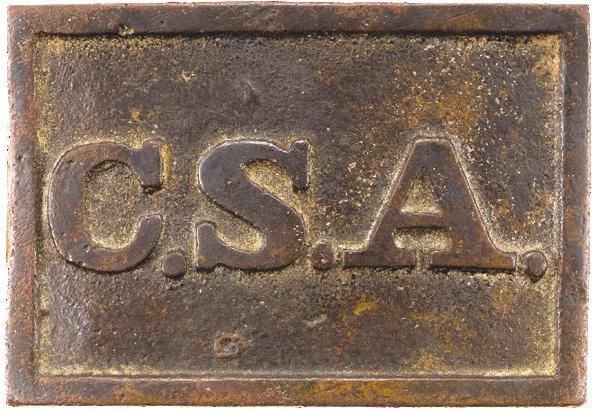






Mike Kent & Associates, LLC • PO Box 685 • Monroe, GA 30655 770-630-7296 • Mike@MKShows.com • www.MKShows.com Military Collectible & Gun & Knife Shows Presents The Finest Williamson County Ag Expo Park 4215 Long Lane Franklin, TN 37064 Dec. 5 & 6, 2020 Middle TN (Franklin) Civil War Show Richmond International Raceway 600 East Laburnum Avenue Richmond, VA 23222 Nov. 14 & 15, 2020 Capital of the Confederacy (Richmond) Civil War Show Promoters of Quality Shows for Shooters, Collectors, Civil War and Militaria Enthusiasts Bring this page with you and receive $1 off admission Exchange Park Fairgrounds 9850 Highway 78 Ladson, SC 29456 Sept. 12 & 13, 2020 Charleston Gun & Knife Show WNC Ag Center 1301 Fanning Bridge Road Fletcher, NC Oct. 3 & 4, 2020 Asheville Gun & Knife Show
Beach Convention Center 2101 North Oak Street
Beach, SC
31 & Nov. 1, 2020 Myrtle Beach Gun & Knife Show
Myrtle
Myrtle
29579 Oct.
and Rhode Island—put that option into their ratification documents, the rest of the signatories accepted secession per se. In any contract—and the Constitution is a contract!—no signatory has fewer or more “rights” than any other signatory. With the acceptance of the ratification documents of those three states, both the Constitution itself and its signatories accepted the existence of secession, period.
The argument is also made that the South seceded to protect slavery and somehow that delegitimizes the act. As Jefferson Davis pointed out, slavery was an “occasion” of all that followed, but not the cause. But even if the Cotton States had seceded for that reason, that did not invalidate their action. Those States met in convention and voted to secede. Having done so, like the New England states years earlier, they had fulfilled the constitutional demands on the matter. Any action taken against them by the federal (and supposedly limited) government in Washington was in fact treason according to that same Constitution under Article III, Section 3: “Treason against the United States, shall consist only in levying War against them [the Sovereign States], or in adhering to their Enemies, giving them Aid and Comfort.”
Parenthetically, neither can the so-called “firing of the first shot” scenario be used to make legal the federal government’s declaration of war. A war is attributed
to whoever causes the first shot to be fired and a review of the Sumter matter clearly reveals that it was not the Confederacy. Ergo, treason was committed not by states constitutionally seceding, but by the federal government—supported by the rest of the states—declaring and waging war while claiming to be fighting the very treason they themselves were committing.
And this is why the existence or nonexistence of “black Confederates” is a spurious issue being used to “validate” or “invalidate” that which is valid on its face.
V. P. Hughes
Response by Civil War News Editor Larry Babits:
Mr. Hughes raises a great many issues that deal with the Civil War; the legality of secession; treason as a constitutional issue; blaming, or crediting, the persons who started the war, and prior attempts at leaving the union. These are certainly major issues, but they are the purview of “Big Men,” the movers and shakers. This is a top down approach to the War. Along with the big issues, our approach has been to try and also present the bottom up view of the common people who participated in the fighting after these major issues evolved into actual combat. We would welcome anyone wishing to address the Hughes’s commentaries as an article.
If a person considers a topic
irrelevant does not make it so. There has been a wide variety of commentary; American Battlefield Trust and John Coski are two examples, on whether or not people of color served as Confederate combatants. Civil War News tried to offer a balanced view of that one single issue because there are people out there who do consider it relevant.
Along with the main issue of service by people of color, there were several ancillary topics covered in the article, including combat participation, and whether cooks, musicians, and others might not be considered “soldiers”; we tried to present information on these aspects as well because there have been attempts to denigrate a military person’s service because they “only” served as a musician or cook. We also tried to clarify; using contemporary laws, what constituted a person of color, because it was definitely not the same as today’s rather flexible interpretations. Claiming something is irrelevant is one way to hide it, and maybe, make it disappear. By saying something is irrelevant, it is condemned to be ignored, set aside, and then forgotten. Just declaring something irrelevant will not make it go away; there are some African Americans who argue for the recognition of their ancestors’ service and their voices should be given a hearing, whether they fought for the Blue or the Gray. The soldiers of the 1860s have earned that right because
their “past services have endeared them to their countrymen.”
TO THE EDITOR:
My thanks to Civil War News and reviewer Joseph Truglio for a well thought out and balanced review of my book Generals killed at Gettysburg. (Civil War News July 2020)
Of 120 generals present at Gettysburg, nine were killed or mortally wounded during the battle. No other battle claimed as many general officers.
Mr. Truglio correctly points out that this book is valuable for those new to the study of the war’s biggest battle. But the book is also about the devastating loss of leadership and the human beings whose deaths would impact the war’s ultimate outcome, information that even those familiar with the battle will profit from. The very minor criticisms were valid and I appreciated the suggestion to give a copy to a younger student and send him/her on a “journey of learning.”
Joe Mieczkowski
TO THE EDITOR:
I thoroughly enjoyed your June 2020 issue, especially Dr. Lawrence E. Babits’ article Fact or Fiction? Black Confederates. It was perhaps the best treatment of the controversial subject that I’ve seen yet.
Most will agree that officially the Confederacy did not permit Americans of African descent into its armed forces until the last
weeks of the war, far too late to make a difference. There is endless documentation of Blacks serving in various capacities, primarily in important support roles.
Unofficially, there are documented cases of Blacks bearing arms for the Confederacy and involved in combat. The Official Records contain several accounts by Union officers reporting encounters with armed and accoutered Blacks in the Confederate forces, all throughout the war.

John Wilson Buckner of Sumter County, S.C., is worthy of examination. Private J.W. Buckner briefly appears on the January 14, 1862, muster roll of Company E, 7th Battalion (Enfield Rifles) South Carolina Infantry (Nelson’s Battalion), and reportedly served under Captain B.E. Boykin and Captain P.P. Gaillard. The length of his service or why he departed that command is unknown.
The following year Buckner enlisted as a private, March 27, 1863 with Company I, 1st Regiment, South Carolina Artillery. Buckner was wounded at Fort Wagner, July 10, 1863.
The July 1, 1863, Charleston Mercury lists a “T.H.Buckner, 1st Regiment, S.C. Artillery, Company I”, among those admitted to Roper Hospital in Charleston. It must be presumed that “T.H.” was John W. Buckner, as there was no one else in that command with the Buckner surname. Private Buckner is listed as “present” on every company muster roll through JulyAugust 1864. He evidently went on furlough afterward and never returned, and was listed as “AWOL” or as a “deserter” effective October 14, 1864. His could be a case where he returned to duty, but records were lost or not kept by the command late in the war.
In none of Buckner’s service records is his race documented. The 1850 and 1860 Sumter County, S.C., census lists show John Buckner as a free mulatto; the census records of 1870 and 1880 subsequently record him as a mulatto as well. All four enumerations record his occupation or trade as a gin maker. His father was Black and his mother a mulatto.
4 CWN August 2020 Letters to the Editor: Please email: mail@civilwarnews.com Civil War News 520 Folly Road, Suite 25 PMB 379 Charleston, SC 29412
According to the 1994 book Black Southerners in Gray, edited by Richard Rollins, pp.1718, Buckner was a grandson of William Ellison, who was born 1791 into slavery, and received his freedom in 1816. Ellison developed a successful cotton gin manufacturing and repair business, and eventually owned 100 slaves. During the war the Ellison family supplied both neighbors and the Confederacy with provisions and hired out their skilled slaves for the war effort.
John Buckner died August 17, 1895, and according to the August 28, 1895 Sumter Watchman and Southron newspaper, page 5, “he was always a free man and at the breaking out of the war enlisted as a regular soldier in Capt. P.P. Gaillard’s company. He served subsequently in Capt. Boykin’s company and later as a scout. He was a faithful soldier.”
Some online Civil War “bloggers” are quick to dismiss mulattoes as not being “Black,”


and therefore cannot be Black Confederates. I wonder if the blogger would apply that same racial litmus test to Barack Obama, himself a man of mixed race with a Black father from Kenya, and White mother of European descent, who is universally acknowledged as our first Black president?

Whether judged by mid-19th century standards or those of the early 21st century, John Wilson Buckner was a well-documented person of color who enlisted in the Confederate forces with the rank of Private, received pay for his services, was wounded in battle, medically treated in a hospital with his white comrades; and was acknowledged in his published death notice as a “faithful” Confederate soldier.
Greg C. White
Civil War Catalog


Featuring a large assortment of Civil War and Indian War autographs, accoutrements, memorabilia, medals, insignia, buttons, GAR, documents, photos, & books.
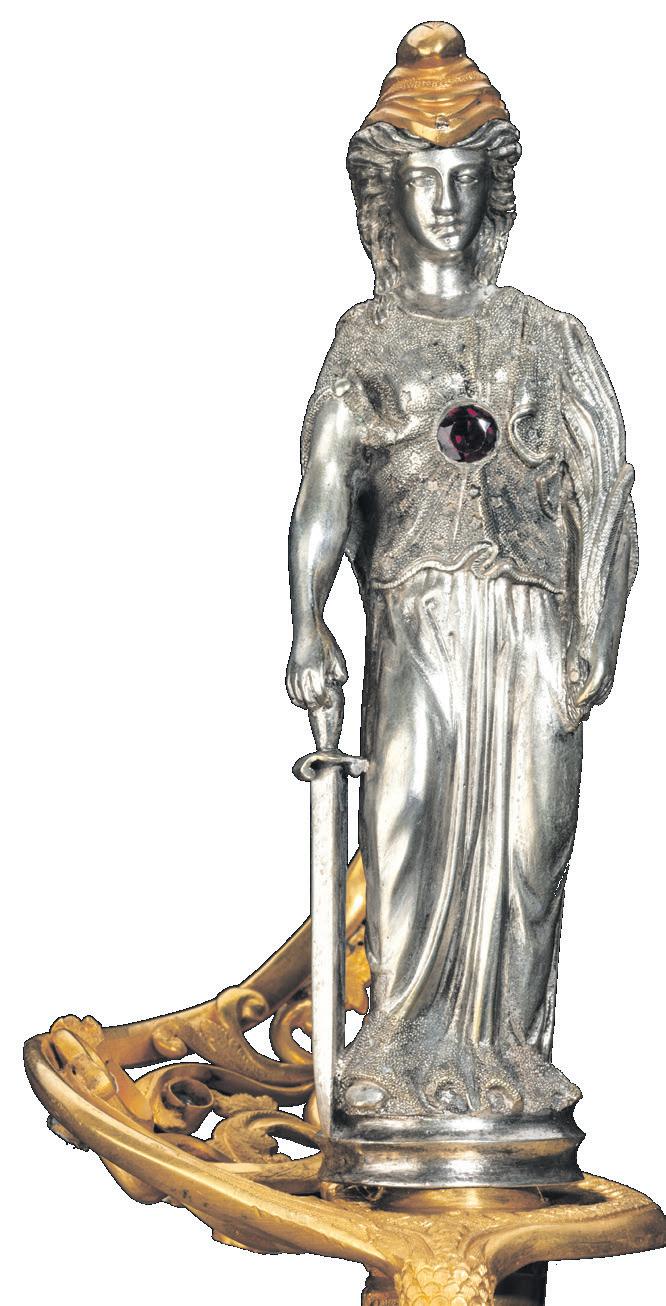
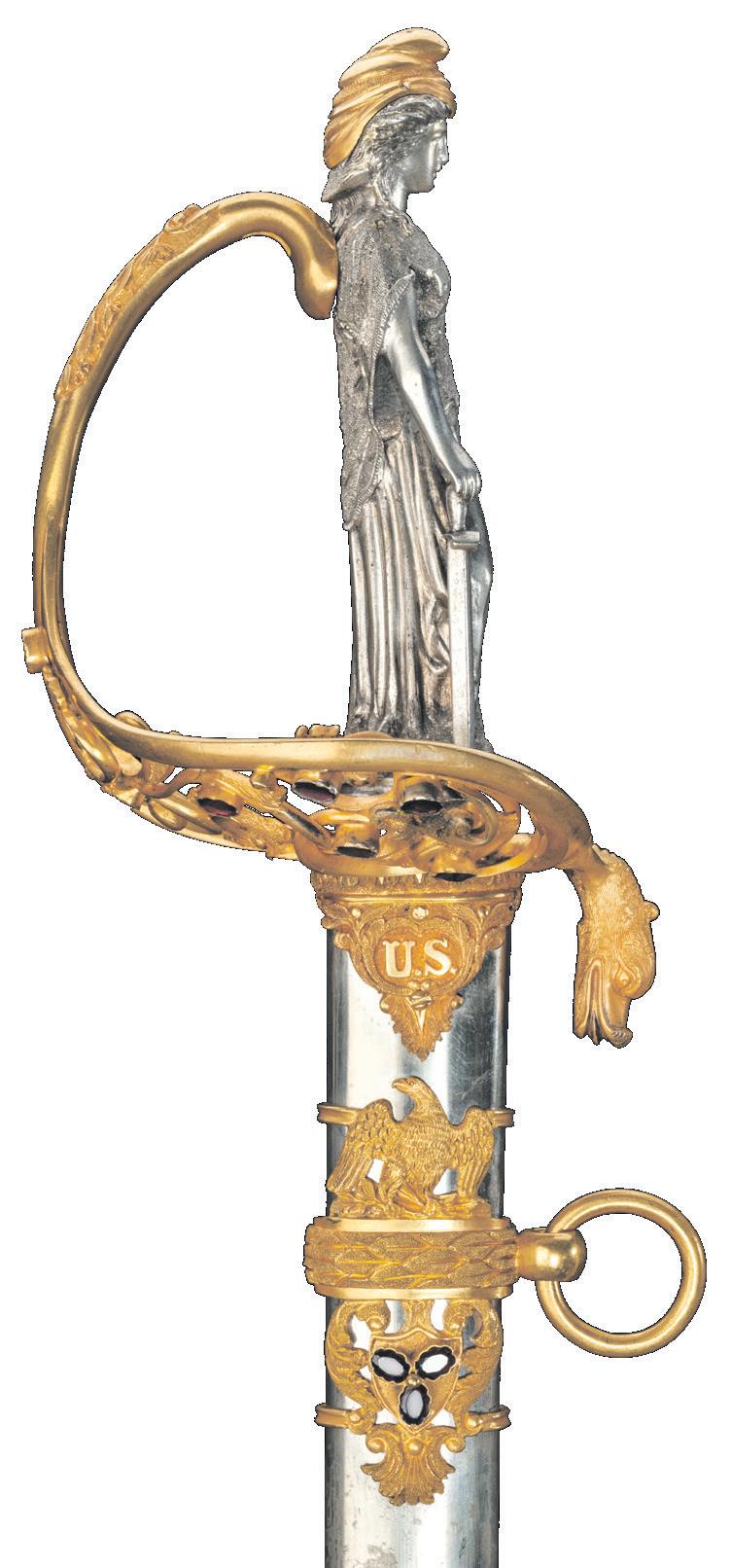





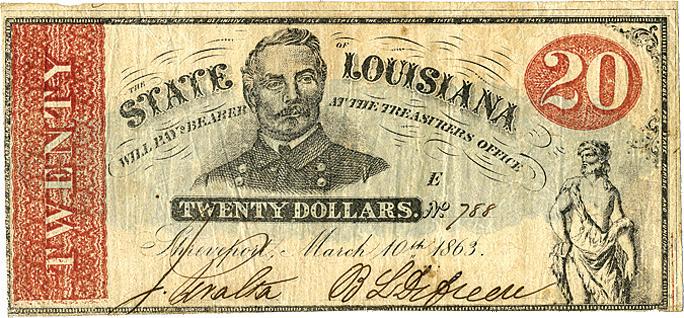
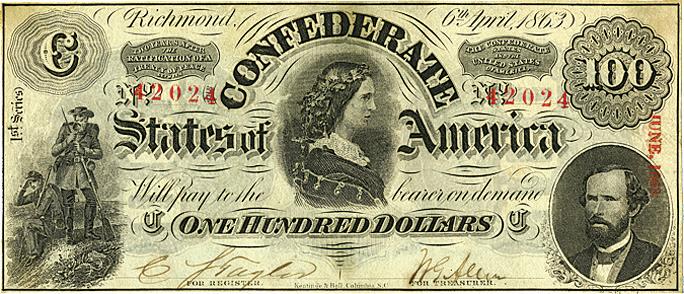
Please visit our fully illustrated online catalog at www.mikebrackin.com


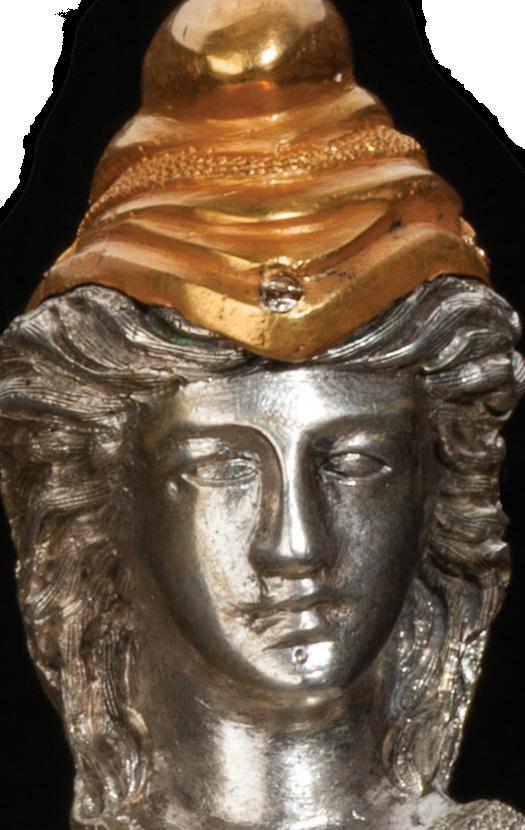


Free copy mail catalog





 Mike Brackin
Mike Brackin
PO Box 652, Winterville, NC 28590 • 252-565-8810

5 August 2020 CWN Subscribe online at CivilWarNews.com Greg Ton • P.O. Box 9 • Franklin, TN 37065 901-487-5944 • GTon1@aol.com Greg Ton Buying and Selling the Finest Confederate, Obsolete and Southern States Currency Since 1978 GregTonCurrency.com
Buying and Selling The Finest in Americana 11311 S. Indian River Dr. • Fort Pierce, Florida 34982 770-329-4985 • gwjuno@aol.com George Weller Juno
A Candid Interview with Garry Adelman, American Battlefield Trust’s Chief Historian
by Chris Mackowski, Ph.D.
If anyone in the Civil War community sets the bar for excitement and enthusiasm, it’s Garry Adelman. Garry is the chief historian for the American Battlefield Trust, and during his time with ABT, he has made himself into a household name through his embrace of social media and his explosive energy. As Garry often says, he’s excited about sharing Civil War history, and he wants to do everything he can to help his audiences be excited about it, too.
I had the chance to sit down with Garry for an extended conversation about how he got into Civil War history, how his career evolved, and the impact social media has had on the field. During the course of our conversation, we also got to talk about his passion for battlefield preservation, his fascination with Civil War photography, and his work as a historian.
Chris Mackowski: I think the place I’d like to start is last summer, when we were on the roof of the Fahnestock Building in Gettysburg doing a Facebook LIVE for the American Battlefield Trust, and from where we were standing, we could look down onto Baltimore Street and see the former restaurant you used to own.
Garry Adelman: Yes.
Chris: And, to me, that’s a fascinating journey of you going from street level to roof level.
Garry: Oh, interesting metaphor.
Chris: Can you trace that journey a little bit for me?
Garry: I became obsessed with the Civil War in high school by picking up William Frassanito’s books.
Chris: That’s a two-for-one, because it’s Civil War and it’s photography—your two big things. How did that steer you?
Garry: I was always that kid—I don’t know why; but when I was seven, I’d see a picture from when I was three and wonder where it was taken, and I’d want to go back and take another picture of it. For whatever reason, this was burned into me. In high school, my freshman year, I would take pictures of buildings before they were demolished with the intent of going back and taking a picture of it later after it was demolished. So, I don’t know why, but this idea of time passing over a certain place has been of interest to me since I was a little boy.
Chris: That’s fascinating.
Garry: I have no idea why. So, in my last day of sophomore year of high school, when I was not a good history student at all because I didn’t read for pleasure, and didn’t read most of what was assigned me, I finished my exam early and went to the Evanston Township High School Library, a massive library, and I have no idea why, but I walked over to the 973’s and pulled this book with bright red letters saying “Antietam” on the side. I didn’t know what Antietam was.
I guess I knew the North fought the South, but not much more than that. When I stress that I was 16 years old and didn’t know what the Civil War was, I mean it. I pulled that book off the shelf and opened to a page that showed dead bodies lying in front of the Dunker Church with a pair of shoes lying there, and then a picture of the same place today, it immediately hit me. I couldn’t wait to get back in the fall and check that book out. (chuckles)
I didn’t think to go to another library and get it, I guess.
But, that was it. I became obsessed with it. I got The American Heritage book after that, and then suddenly, for birthdays and Hanukkah, people were giving me Civil War books, and I was suddenly reading for pleasure. That’s what changed. That changed everything that very moment.
So, suddenly, there was an author who was doing what I’m naturally born to do, study time and place together, and here it was in a book. He was the first one I’d ever seen do it, and he pioneered this. My kids know this: they would not exist were it not for William A. Frassanito. There is no doubt about it. I’d have never moved to Gettysburg or met my wife were it not for getting obsessed with his books.
Tim Smith and I, we are officially his students and he is our mentor, and he sends us out to do his work to some extent, and I’m very proud to be in that position.
If I see somebody on the field with a Frassanito book struggling to find a modern location, because his moderns were taken in the ’70s and ’80s, I always help them because, on my first trip to Gettysburg, a man did that for me. He saw me with my Fraz book—F-R-A-Z—and he helped me and I’ll never forget it.
So, literally because of Frassanito’s Antietam book, I was instantly obsessed. I started reading for pleasure for the first time in my life and obsessed about it for the coming years really. I still went to school to get a business degree in hotel and restaurant management, but I was more obsessed with history at the time, I just didn’t think I could make money at it. Chris: Yeah.
Garry: During college, a couple of times I visited Gettysburg, Antietam, and Fredericksburg. Then I was really hooked. I didn’t know what “obsessed” was until those first few trips.
Chris: What was your first experience on a battlefield like?
Garry: Though the Antietam book was my real entry, when I read the Gettysburg book, I was obsessed. Then I got his Grant and Lee book, and I just knew I had to visit a battlefield. I couldn’t make that happen until July 1988, the 125th anniversary of Gettysburg. That’s not why I went, but that’s when I was able to work it out.



I was in college at the time, and during the summer I was doing restaurant stuff, running a busy booth at the Taste of Chicago. After that experience,
after working ten straight twelve-, thirteen-hour days, I flew to Gettysburg and visited a girlfriend of mine who was living in Baltimore at the time. All I wanted to do was drive to Gettysburg and Antietam, which I did, twice I drove out to Gettysburg during that trip; and because I was so obsessed I thought something almost supernatural would happen. You know, I would touch the rocks and I’d close my eyes….
It ended up being a little anti-climactic, with a distinct exception of walking around the woods at Devil’s Den on the road, and I kind of had a feel, spatially, for where I was because of the then-and-now photos. I knew what was where, but I didn’t exactly know any detail. Things never quite sit the way you think they are until you go.
When I turned the corner on Sickles Avenue, and I was writing “somewhere in Devil’s Den,” and then looked up and saw the dead sharpshooter’s position, with which I was particularly obsessed, and I stopped right there, stopped walking and wrote:
“WOH, I just saw the dead sharpshooter’s position; I’m trembling + I can’t breath (sic.) right – my heart is pounding quickly + my mouth is dry; this is Amazing.
I wrote that in my journal upon glimpsing the site, before I even walked up to it.
Within two minutes, I’d set up

6 CWN August 2020
Garry Adelman, William Frassanito and Tim Smith at Frasanito’s Family grave site in Evergreen Cemetery, Gettysburg, 1996.
One of hundreds of times Garry has posed in the same spot as did sketch artist Alfred Waud at Gettysburg, 1989.
Signing Devil’s Den books at Gettysburg’s old Cyclorama building, 1999.
Section of Garry’s July 1988 journal where he wrote his impression upon seeing the Dead Sharpshooter Position.
my camera on a tripod and laid down in the same spot, because to me I was getting closer with my subject. That’s not for everyone. You know, people interact with battlefields in different ways. A lot of people wonder what the code of conduct is on a battlefield. What are you supposed to do at this place? Can you have fun? Does it have to be all heavy reverence? Can there be some irreverence? I’ve seen people be happy, I’ve seen them be sad, I’ve seen them be confused, I’ve seen them be angry, I’ve seen them lash out at the tour guide, I’ve seen them pass out, I’ve seen them cry, and whatnot.
I look to the veterans: they had fun. They used a battlefield for various things while they also paid honor to their comrades’ sacrifices and their own deeds.
So, I think there’s a pretty wide boundary of what’s okay on a battlefield. You don’t have to lay down in the spot of the dead, that’s a little bit morbid to many. To me, it brings me closer to the subject.
Chris: While you’re discovering this connection to the battlefield, though, you’re still carrying on life as usual, too, right?
Garry: Yeah, I’d been working for a prominent restaurant corporation in Chicago. I had a great job. When I got out of college, I started managing a restaurant and did that for about two and a half years. Restaurant people work a lot, and you don’t get a lot of vacation time, especially when you’re first starting out, so I would close up the restaurant on Saturday night, once in a while at 2 a.m., start driving, and get there, it’s about a 12-hour drive from Chicago, and with the time change, I’d get there at about, you know, 3 p.m. the next day, and I’d spend a couple of hours ’til it got dark, then I’d spend the whole next day, then I’d drive back. It was just nuts. I did this 11 times.
One day my car broke down on the side of the road, it was in rural Michigan, and everybody was so nice, they helped me out, and right then and there I decided, “I have to get out of the city.” I was 25; I had gray hair, some gray hair, I had more hair than I do now but some of it was already gray at the time. I was stressed out, and I just then and there pretty much decided “I’m going to move to Gettysburg” without a job. Which is what I did!
I tried to find work as a restaurant manager because everybody needs that, right, except bad idea to move to a tourist town in September when they’re not hiring. So, unable to find a job, my then-girlfriend and I opened a restaurant there on the corner of
Baltimore and Middle Street. It was called The Food for Thought Café and Coffee House, and it was a little ahead of its time because it was a health food restaurant and coffee house. This was 1992/93. We were the only espresso machine within 30 miles.
Chris Mackowski: So once you got to Gettysburg, what got you into the history field there?
Garry Adelman: At first I worked 120 hours a week, then it was 100, then it was 80. Eventually, we got supervisors to help us and business was good, and I was down to 60 and then even 50 hours a week over the years, and the more that happened, the more time I had to do other things. In 1994, I took and passed the Licensed Battlefield Guide Exam, became a guide in 1995. By then, I’d written my first article for Gettysburg Magazine, and by 1997, I wrote Devil’s Den: A History and Guide. I co-wrote that with Tim Smith.
So when I was running the restaurant, I was kind of getting into my Civil War career. In 1992, I joined the Gettysburg Battlefield Preservation Association as a board member, started advocating for battlefields, which, by the way, is pretty funny because my goal in moving to Gettysburg was to pursue my passion, become a battlefield advocate, and write, which is pretty funny considering what I do now. (laughter)
Chris: You seem to have planned it out pretty well!
Garry: Yeah, this 25-year-old kid kind of laid out, “Okay this is what I’m going to do,” and I had no reason to think I could do it. I had never written anything of note before. In the meantime, my girlfriend at the time; Gettysburg wasn’t for her, but I had everything I wanted there. I wasn’t ready to leave. So we wanted to sell the restaurant, and we found a buyer in Gettysburg College, who wanted to set up a new operation called Starbucks. Well, I was the only trained barista in some distance, so they asked me if I would consult, and I said “No, hire me to run it.” So, they bought my restaurant, and I ended up working for Gettysburg College and running their Starbucks operation, their snack bar called The Bullet Hole, and all their concessions, all their food services outside their cafeteria.
Chris: Did working for the college free you up in the summer time?
Garry: Exactly. It was perfect. I had this great situation going there. I was at Gettysburg. I worked on the battlefield. It’s on the college campus which is battlefield. And by that time, that’s from ’95 to ’99, I solidified being
a battlefield guide. I already had a book out, I was speaking to round tables and, I was working on another book.
My next one came out in 2000, Little Round Top: A Detailed Tour Guide. I wrote more articles for Gettysburg Magazine and I appeared in Civil War News. It kind of started happening. It was just a very gratifying and shocking experience that once this sort of trifecta of giving tours, speaking to groups, and having something written came together, that’s when everything changed. Even before the days of social media, people started knowing who I was, and I didn’t know who they were. It was a very interesting phenomenon. They would see you at a round table; they would see you on a tour, they’d see you on Pennsylvania Cable Network or something like that.
Chris: And then suddenly you wake up one day, and you’re like “Holy shit, it happened!” Almost like it crept up on you, and then suddenly there it was.
Garry: Yeah, yeah, and this is while I was still running restaurants. Another change happened, though: I realized I wanted to go back and study history officially. Remember, I wasn’t a history undergrad.
So, in 1999, I did two things. I started working for Thomas Publications, then known as “The leader in Civil War books… and more.” I was their marketing guy. They had a lot of great titles, and I had a great job there as well, so that was my exit from restaurants. I officially got out of restaurants in 1999. I also started pursuing my master’s in Applied History at Shippensburg University of Pennsylvania where I had a great experience, by the way. During that time, I was exposed to even more stuff.
In any case, while I was at Thomas Publications, I had written in my journal, “Mark my words: before long I shall crack the ceiling of getting on a Civil
War documentary.”
Chris: So that was your next goal?
Garry: Oh yeah, and finally it happened. I got on one that was about William Frassanito. It was about Civil War photography, and there was one episode that was just about Frassanito, and he was somebody I knew. I was wellversed on him.
Of course, it was like two and a half years until it aired. Oh my God, that was a painful wait. But in the meantime, historian Tom Desjardin couldn’t do an appearance on Civil War Combat, and he recommended me, so I was on Little Round Top on a Civil War Combat thing, and that’s right around 2000.
At that same time, Tim Smith and I started giving battle walks for the Gettysburg National Military Park. Those are usually reserved for rangers, but we felt we had something to offer that other people don’t do, sort of a lot of post-battle and battlefield focus, a lot of photography focus. A lot of people didn’t really focus on that, especially back then. So for the better part of twenty years, we gave tours at the anniversary with these battle walks, and they were always filmed by Pennsylvania Cable Network. You do one of those, and suddenly people know who you are. They invite you to their round table. They want you to write for their publication. Things spiraled.
Chris: Did that open some doors for you?
Garry: Yeah, I stayed at Thomas Publications until 2002. Armed with my master’s, I went out looking for another job and found one at History Associates, Inc., in Rockville, Md. I found my dream job. This is a place that just hires historians and archivists to do things for them for hire; it’s a consulting firm, a consulting firm that made a lot of its money doing research to support litigation on either side. It was great because we were just fact
finders, usually for environmental research, and either way the place would get cleaned up, it’s just a matter of who’s paying for it. It was very gratifying research and detailed detective work. We also wrote books for corporations. That was fun and gratifying. We also did work for a lot of museums and whatnot.
While I was there, I started kind of carving out a Civil War niche. I was, like, “Hey, wouldn’t it be great to just be able to do Civil War stuff here?” So I would look for requests for proposals to respond to. On the second one, by an outfit known as the Civil War Preservation Trust, I did an RFP for their Third Winchester Battlefield, and we submitted for that, applied for it, and got it.
Chris: So your first interaction with the Trust!
Garry: And my first battlefield layout. I had helped writing a few signs before; and by the way, anyone who’s done that feels the weight of responsibility, especially when you first start doing it: “Oh my God, this is it; it’s in the ground.” Semi-permanent or permanent, it has a real impact.
So along with my buddy Tim Smith, whom I brought on as a contractor, and Amber Moulten Wiseman, who’s a professor, we laid out that battlefield and wrote 22 signs, later learning that 22 is way too many for a battlefield trail and way too expensive. We learned about a lot and started experiencing the push and pull between access and preservation. Is it better to get people out to a battlefield? What if they want to go on a bike? What if they have mobility issues? Does it have to be a flat surface? What about just grass? What about when the trail goes down a hill, do you want to have liability for people slipping down a hill or something like that?
This was, in parts, a controversial project because, for some parts of it, we wanted bikes to be able to pass each other and secured a grant from a foundation that wanted the paths to be bike accessible. Money makes the world go round, and we couldn’t have possibly done this interpretation without it, but there was also some public backlash and outcry. We learned some things as a result.
But now, I mean, it’s a great thing for the community; it’s very gratifying.
Chris Mackowski: How did you follow that up?
Garry Adelman: We followed that up with work at the First Day Chancellorsville; we laid out and interpreted that. The Slaughter Pen Farm at Fredericksburg; we laid out and interpreted that, then

7 August 2020 CWN
Before he even worked at the Trust, Garry was giving tours for the organization, such as here in the Bloody Lane at Antietam at a Teacher Institute, ca. 2009. Photo by Steven Stanley.
we laid out and interpreted Mine Run, Payne’s Farm, which we laid out and interpreted. Those were my first four battlefields and I did them before I was with the Trust.

In the meantime, at History Associates, while doing other work there, I was spending about a quarter of my time doing Trust projects, preparing for Civil War 150. Remember the Sesquicentennial? I was doing research for donors and influential politicians who might be more likely to support particular efforts if they knew about their Civil War ancestry. I was helping out with Trust events. I was giving tours. I was helping with research. So, before long I was working most with Civil War Trust departments, or what was then called the Civil War Preservation Trust.
When my time at History Associates had sort of run its course, which, by the way, I’d still be working there because I loved that job. The only job I could conceive of that would be better would be working for the Civil War Preservation Trust, and since I knew everybody there, I teased the idea with them of working there. They were into it. Long story short: they created a new position called Director of History and Education. That was April of 2010.
The Trust had never truly focused on education before then although they had an education person or two. My sort-of predecessor, Nicole Osier, was taking the department in a good direction, energized by the Trust’s digital director at the time, Rob Shenk. But the Trust never talked much about education, never appealed for money to support education, didn’t have a video program, nothing like that. So things changed around then.
Chris: So you got the job and really start to transform things. How much of that, certainly, has
to do with you coming in brand new, and how much has to do with a lot of the technology that the Trust hadn’t taken advantage of before? It seems like that must have been kind of a neat convergence—and a convenient one.
Garry: It was. When I got there, there was a teacher institute; there were some traveling trunks going around the country; there was a free downloadable curriculum, by our own admission, a pretty below-average curriculum, and I can’t think there was much else going on.
But under Rob Shenk and Nicole Osier, they started building content. Instead of linking to other people’s websites, they thought, “Hey, maybe we should have these assets on our own website.” They built “This Day in the Civil War;” they started building out the biographies of some major people in the Civil War; they started really started covering some bases and building out what was, until 2010-ish, a pretty crappy website. Now I’m pretty sure the Trust has the best website, at least for the Civil War, in terms of its breadth. It’d be hard to say otherwise, I think. But that was kind of the scene at the time.
In 2010, I think the education department’s record for a year of fundraising was $20,000. Five years later, we were raising $500,000 for education because we had more programs we needed to support. So, it was an interesting time. Social media is there and apparently there to stay. Anybody could take their phone or their SLR camera out and shoot video and propagate that video via email or social media. And all of us started recognizing that.
Chris: I think you have been, in particular, on the leading edge of that. You’ve really embraced that in a way that a lot of the field hadn’t.
Garry: Yeah, let me weigh
in on social media for a quick second. The Trust had a pretty lackluster Facebook page at the time, no Linked-In presence, no Twitter presence. I mean, this was 2010, so it was pretty early for some of that. Instagram; the first time I’d heard about it was 2011. That doesn’t mean it wasn’t around in 2010, but there was this sea change sort of happening. Our digital director, Rob Shenk, he started pushing this, saying, “Hey, we can send out an email and ask for money, and if we’re going to send out an email and ask for money to support a land deal, maybe we need an article about that. Maybe we need ten facts about that battlefield. Maybe we need to shoot a video about that battlefield. Oh, wow, if we’re going to shoot that video and put it on our website, maybe we can put that video on social media as well.” So all these things started coming together. In the meantime, I had already come to the Trust. I was using Facebook a lot, and it didn’t take long before the dark side of social media affected me. I only had one page at the time; it was my personal page, which meant that my Civil War friends were subjected to my personal stuff and my personal friends were subjected to my Civil War stuff. People who might not be crazy about something I did had access to personal things. So it didn’t take long before that got too murky and, for a particular reason or two I won’t say, I eventually established my own “Garry Adelman’s Civil War Page.” I can’t remember what it was called originally, but I had to change the name for some reason. Oh, it was called “Garry Adelman, Author.” Then people didn’t know which page was which. It was a disaster, and I had to use a friend of mine who had a friend who worked at Facebook to change that.
So, I started this page, in 2011,
right in time for the 150th, perfectly, and just started making two posts a day. I didn’t know any rules, but I did pay attention to whether a photo did better, a single photo, a group of photos, a video, or a question. I liked every comment if I liked it, if I, in fact, thought it was a good comment. I liked every one. I used to like every share when somebody shared one of my posts, so I interacted.
Nobody else ever did my page but me, and I just started doing it two a day, and I slogged away for two years, doing two posts a day about my work, Trust work, Civil War photos mostly, until I got to 1,000 likes. It took a long time, and I remember it was right before Gettysburg 150, the greatest Civil War week of my life, that I finally reached 1,000. It’s at 24,500 as we meet right now. For somebody who used to harass his friends, “Listen to me about the Civil War, it’s really interesting, let me show you this picture!”; then to be able to have the same conversation with thousands or tens of thousands of people is just not only mind blowing, but wildly gratifying.
Because of Facebook, because of social media and, of course, because of my position at the Trust, when I give a talk now, there’s usually more people there, so instead of talking to two friends of mine who don’t care about it, I
can talk to 10, 100, 500 people, and then it can be preserved and shown on video later. So it’s this great world that we live in, and social media is an important part of it.
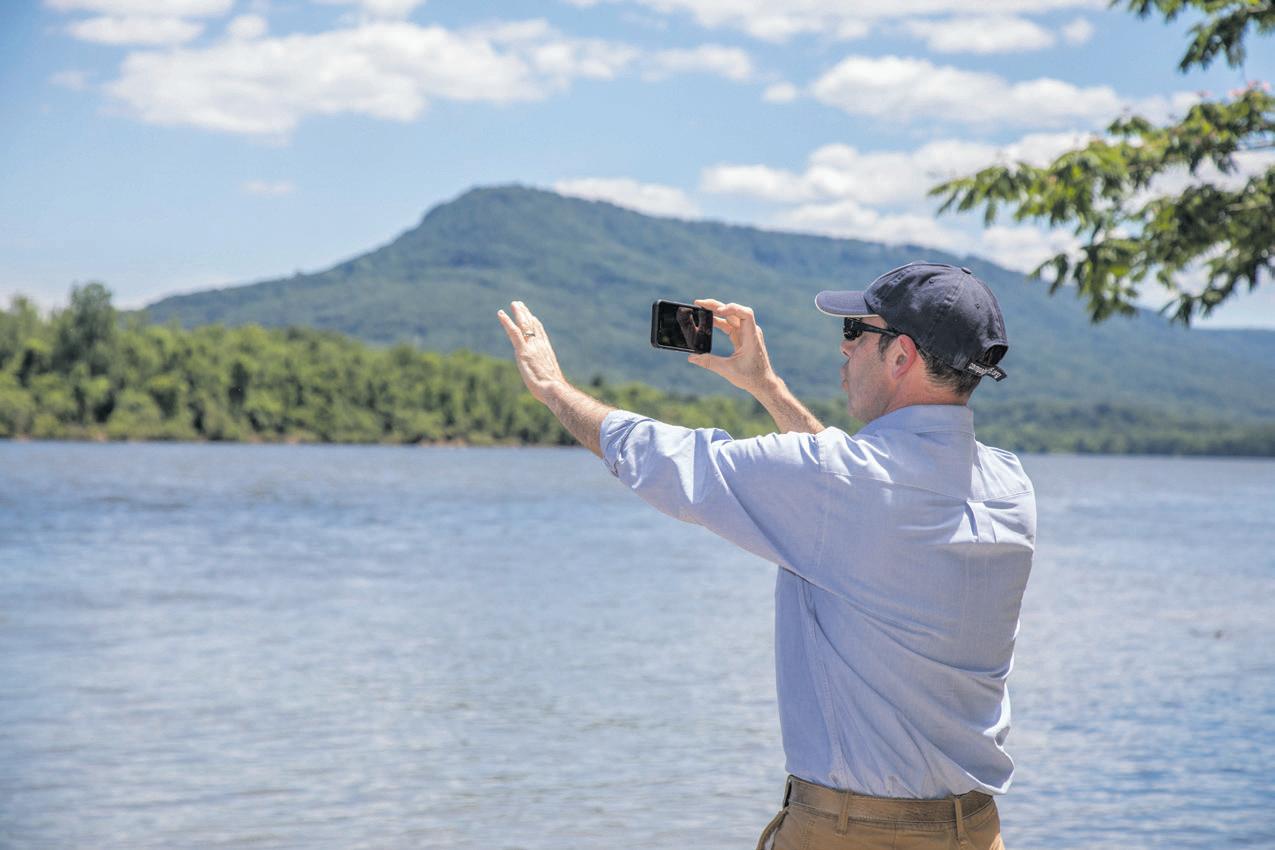
Chris: Yeah, yeah. People feel like they’re your pal. Because they interact with you, they read about you on a daily basis. It’s like the old news anchors where they come into your living room every night, and so you felt like you were friends with Walter Cronkite.
Garry: You feel like you knew him, yeah.
Chris: He didn’t know who the heck you were, but it’s an interesting rapport to have.
Garry: You’re right. They’re on a first-name basis with me, which is interesting, and sometimes first and second name. It’s interesting, you know. “That’s Garry Adelman!” No, I’m just “Garry.” That’s who I am. So that’s been a very interesting thing, as well.
Chris: Were there other aspects of celebrity that took some getting used to?
Garry: Honestly, people write me a lot and basically say, “I want to take your job from you.” They don’t say it in those words, but that’s really what they want. They want to know what it took to get where I’m at. And it’s good. Reading back into my journal

8 CWN August 2020
On the Rose Farm at Gettysburg 150th. Photo by Garret Radke.
Rushing for reinforcements on the field of Pickett’s Charge, 2015. Photo by Bruce Guthrie.
Garry shooting one of his signature social media videos in Chattanooga, Tenn. Photo by Buddy Secor.
where I tried to predict the future, because of that, I remember what it’s like, and I hope to answer other people’s questions who might be in the same circumstance I was in twenty some years ago.
I actually shot a video for In4, I did it myself with a tripod, called “Becoming a Historian In4.” Now I can just send people who ask a link.
I guess the other thing that I’ve learned is that you have to be patient. I mean, a history thing doesn’t just happen. It takes a lot of careful work over the years, so I stress patience. I stress being careful. I stress carving out something that you can be the best at. What are you going to be the best at; and don’t say “the Civil War.” Nobody’s the best at the Civil War. Don’t even say “the Battle of Stone’s River.” Maybe it’s one part of that battle, or maybe it’s one part of social history or something like that.
Another important thing: don’t compromise. I mean, I know so many people who’ve endorsed other people’s crappy books and projects, and they knew they were crap, but they were their friends so they did that sort of thing. I think you have to be uncompromising. Once you compromise yourself, those things can come back to bite you professionally.
So, perseverance and passion and patience and, at first, volunteering, I mean, I still do a lot of volunteer work but I used to do a lot of volunteer work because, in the end, this is about people. Relationships aren’t quite everything, but they’re very close to everything, and you may have to develop positive relationships with 50 people before one helps you get on that documentary, or one helps you get that book published, or one helps you get the job you truly want.
Chris: And if you do it in an explicit “I want to get something out of you” kind of way, that undermines the whole thing.
Garry: Correct.
Chris: You have to do it for the right reasons.
Garry: Yes, you’re right. I mean, you can be cognizant of “Hey, you know what, these people could help me someday.” I thought it when I gave my first tour to Jim Lighthizer and some other board of trustee members. I didn’t kowtow to them, but I thought “Here’s a guy I’m glad I’m giving a tour to.” I’m sure he didn’t remember that tour, when I came and interviewed with him years later. Um, you never know. I could have had no idea that I’d ever be working at the Trust at that point. I don’t even know if I wanted to work at the Trust at the time I gave him that tour. But I
did good work, I gave him a good tour, and I didn’t say like “What can I get out of you later?” I did my work well. That stuff really pays off.
In my case, it took me forever, it feels like, you know? I moved to Gettysburg in 1992 and didn’t get my dream job until 2010. That’s the better part of two decades. And so that took a lot of patience and a lot of free work over the years.
Chris: There’s that whole idea that you really have to bust your ass and be willing to put in the time, pay your dues and just work it. That’s part of the process.
Garry: Oh my word, it takes a lot of hard work. I mean, do you think during the Civil War Institute at Gettysburg College that I wanted to be at that event running a snack bar and taking out trash in front of all the other historians? No—but I did. That was my job, and I was in Gettysburg, I was moving along well. And eventually, I would speak at the Civil War Institute, and they invite me to speak there every year or two.
So, yes it was not easy. I worked very hard, and I spoke to a lot of groups, the smallest of which was three. In the old days, I would drive several hours just to speak to forty people. That doesn’t make sense for me anymore, but I did it and you should, too, whoever’s reading this. If you want to have a job in history, you have to stand out among all those other thousands of people who have the same idea you do and are probably equally passionate. So you need something to stand out.
Chris: Passion is not enough.
Garry: It’s not close to enough
Chris: If you say, “Well, I’m really passionate about this,” that’s your starting point. That’s not your selling point.
Garry: Right. And it’s the same way with the Trust. I mean, we have passionate people working there, but one of the reasons we’re successful is because we don’t have 50 Garry Adelmans there. We have professional lobbyists and professional real estate people and professional development people, because none of that land gets saved without a lot of money and a lot of professional work with the government and on the real estate side and on the event side. I mean, no land gets saved without that. So, passion definitely is not enough.
When it comes to getting a history job, if you can get a parttime history job, you’re doing well. I still have three part-time history jobs outside my full-time job, as I know you do, too, Chris. (laughter)
Chris: True! (laughs) So let me go back, because you talked a second ago about being the best at something. How would you describe what you are the best at?
Garry: Well, mine’s not topical. What I’m the best at, or so people tell me, is getting people excited about our subjects, about especially the Civil War and history in general. I love the idea that I’m serving people a positive experience. My particular brand is that every day is a great day to learn about history. That is something that people call out about me the most. It’s my enthusiasm.
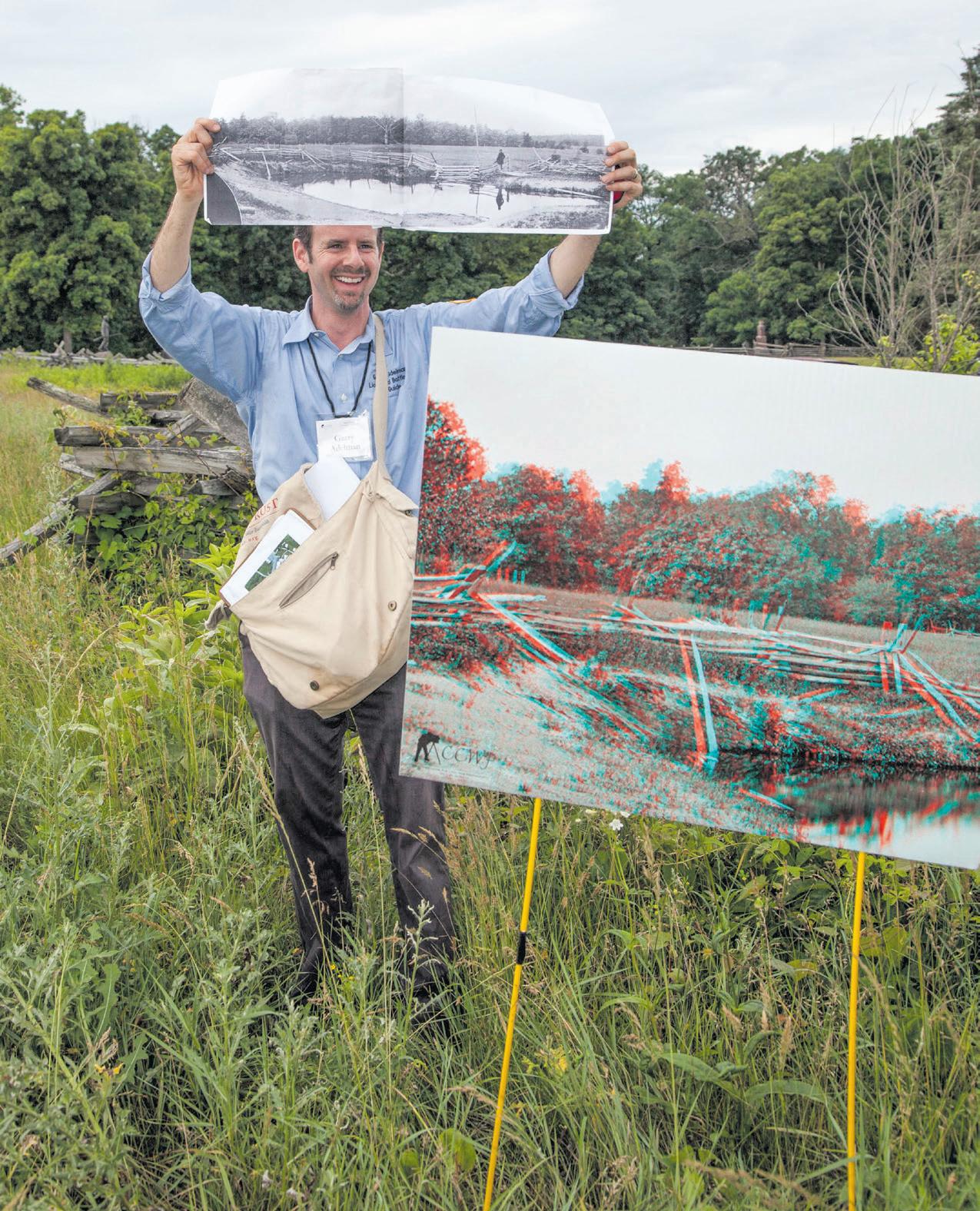
Chris: I would agree that you are the benchmark for that.
Garry: Cool. Thank you. Anybody who knows me, and the social media world has only solidified this, knows that this is just how I am. Period. I’ve had many people in the last three years, because they see me on my videos, who think it’s some sort of contrivance, and then they meet me, and I’m like “Wow, check it out! You just got a new Toyota! Wow, that’s awesome!” And they’re like, “You’re actually like this.” It’s surprising….
Chris: I’d heard that about you before I first met you: “What you see with Garry is what you get. That’s the real Garry.” One of the things that’s made an impression on me is that you maintain a very high-profile presence, but you make a real effort to protect your family’s privacy. How do you compartmentalize that when you are so face-forward with everything else?
Garry: Well, first of all, my wife Jennifer helps with that because “Bachelder-Coddington Award-winner Garry Adelman” still takes out the garbage and picks up the dog crap in the back yard. So, she definitely keeps me grounded on that front.
We met on the Gettysburg Town Square. She went to Gettysburg College, although I didn’t meet her until years later; she used to come in to my restaurant. So, she has some exposure to this Civil War stuff.
But one key about all this is something I learned from friends and ex-girlfriends, all of whom I made hate the Civil War because I just didn’t know when to stop. I had learned before I met Jen and before my kids were born, to not push it. So I really don’t. I love this subject, I’m obsessed with it, but I don’t like much talking about it when I’m out and about doing things.
Sometimes, I’ll get recognized. It happens here and there. But I don’t like much talking about it when I’m with my family because that’s not what they’re there for. So, first of all, it’s that.
Secondly, my kids don’t give a crap about my public presence. They’ve grown up with it, they’ve watched it grow, but they do not give a crap. They give a crap about playing soccer in the basement with me or riding bikes around the neighborhood or playing tennis or playing Risk or whatever we’re doing. That’s what they care about, so it’s easy in a way. My family polices it for me.
Happily, it is our main breadwinner thing, so, happily, they’re very tolerant of my many travels and everything like that. I will say, because of my Facebook page, I want to make people think that I’m everywhere all the time having the greatest day in the world, and many days are like that, let me just say for the record, but I don’t travel nearly as much as people think. People always think I’m everywhere, but the way the posts are timed it makes it seem like I’m never home. That’s not the case.
Chris Mackowski: That was one thing for me, growing up: I always wanted to be a writer, and it would be so cool to have my own books—and today I’m still scratching my head, like, “Oh my gosh, it happened!” But for my kids, it’s like, “Eh, big deal,” you know? They grew up around it, so it just didn’t have the excitement for them that it had for me, and I’m sure that’s kind of the same experience for you with your kids: “Well, of course dad’s on TV. Of course dad’s here or there. Of course dad’s doing this.”
Garry: Yeah. Jen hasn’t come to one of my talks or presentations in a long, long time. I used to ask her to come to about one a year. Now, it’s not even that often. It’s been years since she’s come to one, but she’s seen quite enough of it.
She was at a doctor’s appointment recently and it came up; I don’t know, small talk during the appointment, and somebody was into the Civil War, and Jen said something like “Oh, my husband works in that stuff,” and all of a sudden the woman was like, “Oh, I know him!” And what did my wife say? She said, “Yeah, if you see him on TV, he’s usually waving his arms around a lot,” which, when my kids make fun of me, that’s exactly the thing they do.
Chris: Do you mind talking about your kids at all?
Garry: Not at all. They are in fourth and sixth grade. We live in Maryland, away from the city. Jen and I are both city people, but raising kids in a smaller town was for us. It’s interesting: There were 4,000 kids at my high school, and that was my bag. I went to Michigan State for my undergrad. I only liked big schools, and I loved my experience. But that’s not always what you want for your kids. So, we’re happy to be out in the country, so to speak.
Much to the shock of everyone who meets them, my boys are rather shy. A lot of kids are, I know, but they’re particularly shy, which seems strange around me. But at least one if not both of them have my level of energy,
9 August 2020 CWN
Holding up photos, (a 3D Gettysburg Battlefield photo is resting on the easel), while smiling or talking are among Garry’s hallmarks. Photo by Buddy Secor.
and I can’t explain that either. But we do chill out at night, there is such a thing. People find that hard to believe. But, we all love watching movies together and other things like that.
Chris: So you’ve talked about your family in the work-family balance. I want to come back to the “work” component in a moment. But first, I want to ask you about another of your passions; something you’ve become really well-known for, and that’s your interest in Civil War photography. It eventually led to your involvement with the creation of the Center for Civil War Photography. We’ve been talking a lot about the Trust, but I know the CCWP is really important to you. Tell me a little about that.
Garry Adelman: The CCWP has been critical in my journey in the field and among the most enjoyable parts! Given that Civil War photography was my spark, I suppose that’s not surprising.

It started coming together when I was delivering a photo program in 2000 at the Capital District Civil War Round Table in Albany at the behest of the late Sue Knost, who brought together some people who knew the subject. Among the participants were wet plate photographer Rob Gibson, whom I already knew from living in the Burg, and Bob Zeller whom I met there for the first time. It was stunning; we were three people who all knew the subject but with different areas of expertise. One knew how to make Civil War photos, another knew how to view and understand them, and another how to use them. We decided soon after to host a seminar of our own in Gettysburg which we called the Image of War.
Meanwhile, Bob and Rob had founded the Center in concept, along with the late Al Benson. I and another came on as founders. I was vice president and seminar coordinator. Bob Zeller was president—roles we both hold two decades later.
The Center stared publishing a newsletter, which is now a journal, with great content. We started advocating and raising money in
support of digitization and trying to be out front in scholarship. We have held an Image of War seminar every year since 2001; for the coming 20th seminar, we will be back in Gettysburg this October. Being in the Center and planning the seminars has resulted in my having great relationships with people who are excellent at what they do including Will Greene, Mike Gorman, Ron Coddington, Wendell Decker, and many, many others. I’m extremely proud to be a part of the CCWP.
Chris: Looking at the photography, the preservation, and the social media, looking at the whole package, it really seems like you’re living the dream.
Garry: It’s not only a dream job, it’s beyond any dream job I could’ve conceived if somebody would’ve asked me “What’s your dream job,” you know? I keep saying this, but I marvel at where I find myself.
I thought this obsession would taper off eventually, but I can honestly say I am more into this stuff now than I’ve ever been. I have a job that not only helps to educate people about this, but that everything I do goes toward permanently preserving those places. It just never ends, and it’s great to have a life’s work that you’ll never complete.
Chris: What a great life.
Garry: I’m like a lot of older people who’ve had a satisfying life, and I marvel at what I’ve seen and what I’ve done and what I’ve been able to be part of. I’m living it right now, and it’s just great and it keeps getting better.
Chris: You’ve been at the American Battlefield Trust since 2010, so you’re going on ten years. That’s a pretty good run so far.
Garry: These words might seem trite later, but, man, I have an incredible team. ECW folks know Kris White, who helped found ECW, and is the Trust’s education manager. Kris is not only a workhorse but knows more about history than I do. He’s very organized, and we’re able to do a lot more because I have him.
More recently, we’ve also had Dan Davis, who ECW people
also know and who is doing great work for us. So I have this core team of history nerds supported by a great video guy, Andy Poulton, and our longtime land steward, Matt George. Between them and the rotating interns we have, and some great contractors we use, the impact of what we see educationally is just mind blowing. We can, on battlefields, in books, in print, through the media, at events and on social media, provide this education to a broader group of people and better than we’ve ever done it before. Our videos and programs are better than they’ve ever been.
In any given week, people will watch more than a million minutes of our videos on YouTube alone. That’s to say nothing of the hundreds of thousands of people who engage with us on Facebook and the tens of thousands on our other social media platforms. That we’ve become the leader in Civil War video in a program that didn’t even exist until six or seven years ago at the Trust is very gratifying.
We have the best animated maps, I think, of anybody out there. Our short four-minute videos, intended for adults but great in the classroom, have exceeded my expectation. We have our interactive war department, which has taken off in the YouTube era, and we have this new series called “Battlefield U” to answer people’s most basic questions; I’ll say a lot of our rise started with that. When I got there, we weren’t answering people’s most basic questions. What was the
that our members support things like this. We have a fieldtrip fund that wasn’t even around five years ago, and now more than 25,000 students have been on battlefields because of this fund, or at least with the help of this fund. I’m sure I’m leaving out a whole bunch of things.
Chris: Wow. So, let me start to wind things down by asking about an article that appeared a little while ago in Civil War Monitor, written by Jenny Johnston. It called you “the unintended expert.” I think that sort of brings us back to where you and I started this conversation.
Garry: That was a beautifully written story by Jenny.
Chris: I thought it was an interesting way to characterize you. Garry: It’s true, though. I mean, I was a 16-year-old kid from Illinois who was a C and D history student, who had some things that he loved about the past but was not a serious student about it and hardly knew anything about history, even Illinois history. I didn’t read for pleasure. So it actually was unintended.
Civil War? Who fought in the Civil War? How many casualties were there? What happened to the prisoners? What happened to the dead? Things people ask you on a battlefield tour. So one of the first things I did was implement a Civil War facts page, and within a month it was our most popular page, and it has remained that ever since, for something like eight years with a few exceptions. When there’s a big controversy in Civil War land, our Confederate flag videos do well, our monuments assets might do particularly well. But, overall, it’s the basic facts that people crave, that the masses crave.
So, we’re trying to be out there for students and for strollers who might be interested, and we find that as many as half of our website visitors; we had about ten million unique visitors last year, were students, which is just great because that’s who’s going to perpetuate our democracy. We have to teach history to each other, and that includes young people who might not support the Trust financially for decades. This is why we do a teacher institute.
Our education program has also gone beyond the videos, beyond our website, and beyond the teacher institute to where we do these generation programs where they’re free to parents who bring kids out on battlefields. We found
My obsession with Gettysburg initially was to go through all this photographically. Only later did it morph into this idea that “Ahh, Frassanito taught me that photos are primary sources. What is a primary source?” Ah ha! Something that actually documents something at the time at which it happened. Only later did it become a general history obsession. What’s interesting is that I had little interest in other areas of history. Right now, I’m reading a book called On Grand Strategy and I’m learning a lot about the Peloponnesian Wars and other things like that—things I’d had no idea about it. I’m spending a lot of time learning about the Rev War now because the Trust is in those areas, and I need to be good at it. And, you know what? I’m fascinated with them. One day, maybe I’ll finally get interested in the Civil War navies or about cavalry or something like that. But you can’t do it all.
It’s just great to know that you’ll never ever finish what you’re interested in. Not everybody has that, and I wish they could.
10 CWN August 2020 Subscribe online at CivilWarNews.com Publishers/Authors Updated Information Send your book(s) for review to: Civil War News 520 Folly Road, Suite 25 PMB 379 Charleston, SC 29412 bookreviews@civilwarnews.com
Adapted from an interview conducted by Chris Mackowski for Emerging Civil War; our conversation has been lightly edited for length and clarity.
At the CCWP’s 2014 Dream Day in Gettysburg, Garry points a historic camera at Grant portrayer Ken Serfass. Photo by Buddy Secor.
MILITARIA EDGED WEAPONS, ARMOR & AUGUST
GENERAL ULYSSES S GRANT’S LIEUTENANT GENERAL SHOULDER STRAPS, CIRCA 1864 - 1865
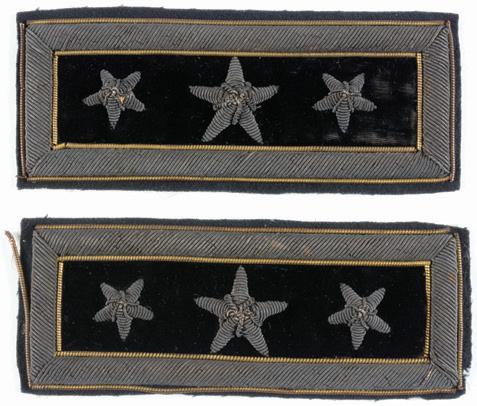
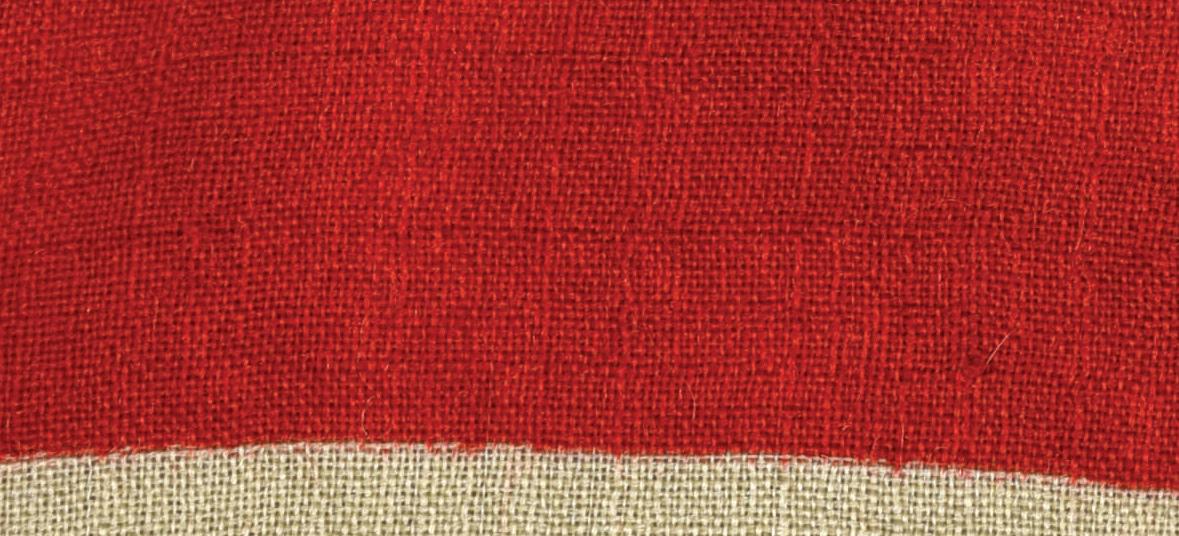

WASHINGTON LIGHT
IDENTIFIED THIRD MAINE OFFICER’S SWORD: DIED OF WOUNDS AT SPOTTSYLVANIA
FRAMED GROUP OF CIVIL WAR FLAG FRAGMENTS FROM THE 1ST MASSACHUSETTS INFANTRY AND GRANT’S HEADQUARTERS
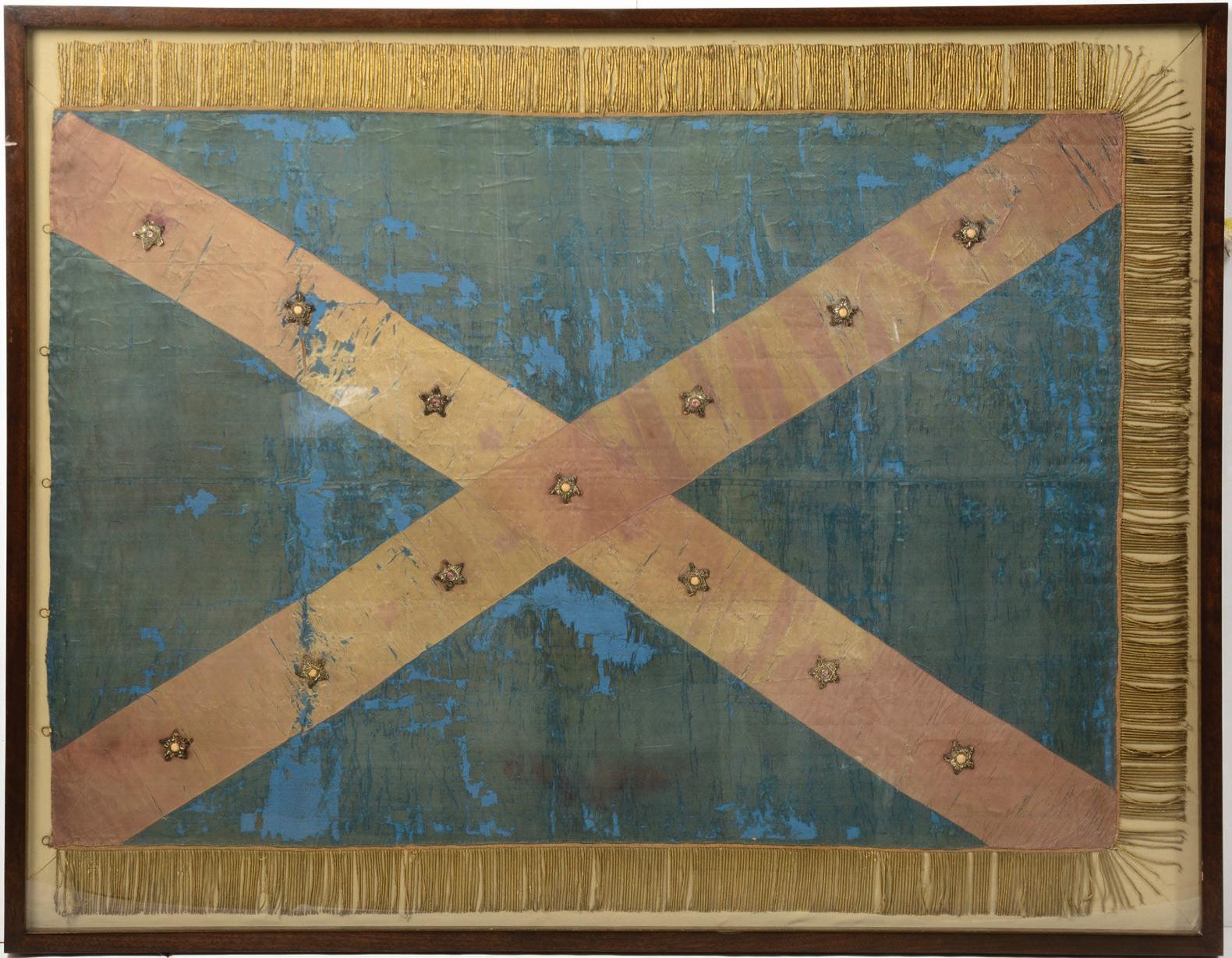

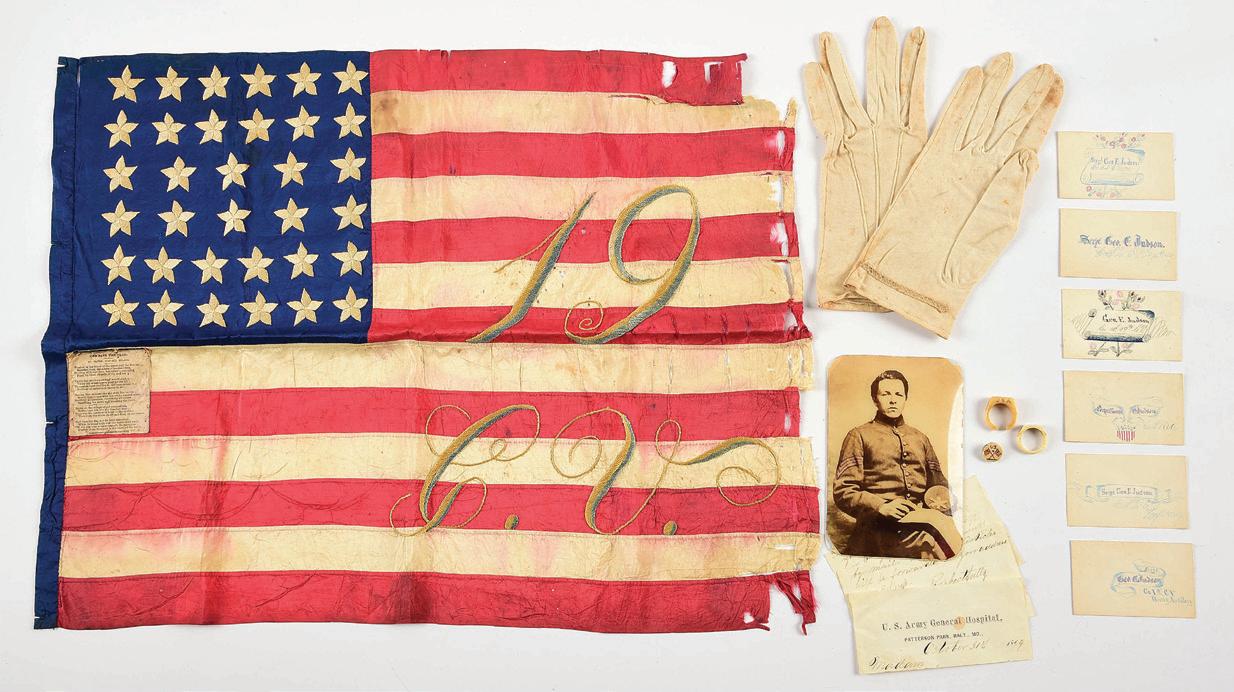
CIVIL WAR BULLET-STRUCK NEW YORK BELT PLATE

RARE DOUGLAS ENLISTED CONFEDERATE CAVALRY SABER WITH LEATHER SCABBARD


ANTIETAM COLLIDED BULLETS FROM BLOODY LANE

RARE THOMAS, GRISWOLD & CO., NEW ORLEANS MARKED CONFEDERATE CAVALRY OFFICERS SABER
RARE AMES CORPS OF ENGINEERS SWORD
GENERAL WILLIAM TECUMSEH SHERMAN’S 1869 FROCK COAT

CIVIL WAR CARVED PIPE OF JOHN CRAWFORD CO. F 18TH NEW YORK VOLUNTEERS

GETTYSBURG BULLET STRUCK TREE FRAGMENT FROM CULP’S HILL

2000 N. READING ROAD | DENVER, PA 17517 877-968-8880 | INFO@MORPHYAUCTIONS.COM MORPHYAUCTIONS.COM
18
19, 2020
&
A RARE TIFFANY GUIDE FLAG OF THE 19TH CONNECTICUT & OTHER CIVIL WAR EFFECTS OF SERGEANT GEORGE E. JUDSON
ARTILLERY
BATTLE
PRESENTATION CONFEDERATE
FLAG
“The Troops Are All in Very High Spirits”
by Bruce S. Allardice and Wayne L. Wolf
Civil War soldiers’ letters are still being discovered, 150 years after the conflict ended. Letters from Florida soldiers are especially rare, given the state’s small population and relatively frontier status. Lately, one such letter came up for sale, from a scion of one of the state’s leading families.
George Washington Wright (1839–1918) was the son of Pennsylvania-born Benjamin Drake Wright (1799–1874), judge and onetime mayor of Pensacola, Florida, and his wife Josefa de la Rua. The younger Wright was managing a lumber mill near Pensacola when the war broke out. He enlisted in the 1st Florida Cavalry in 1861, was taken prisoner in 1862, and after exchange, re-entered service in the 6th Alabama Cavalry of Clanton’s Brigade. He was promoted to lieutenant and later to captain. He survived the
war, returned to Pensacola and his lumber mill, and became one of Pensacola’s most prominent citizens.
This letter to his father is written amidst the fighting near New Hope Church and Kennesaw Mountain during the Atlanta Campaign. In it he expresses the hope, all-to-common in soldier letters, that the “hard fighting” was about to end. He also mentions that Confederate confidence and morale is high, casting doubt on claims of some historians that morale in the Army of Tennessee was low due to Joe Johnston’s constant withdrawals. Wright’s difficulties obtaining a uniform, and getting paid, illustrate the grinding circumstances that even well-off officers faced.
Powder Springs, GA
May 31, 1864
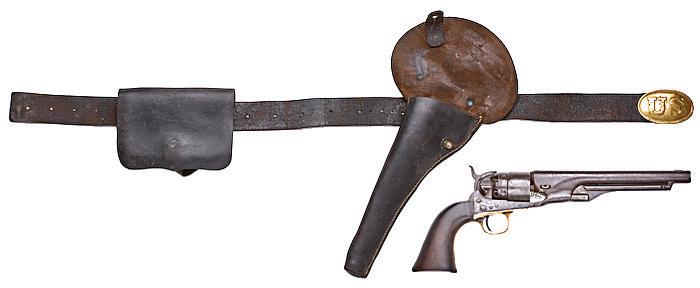
Dear Father: In or about the 1st March I left

CHARLESTON IN THE WAR
100 Signi cant Civil War Photographs: Charleston in the War features newly restored images of scenes in the famed city, taken 1860–1865.

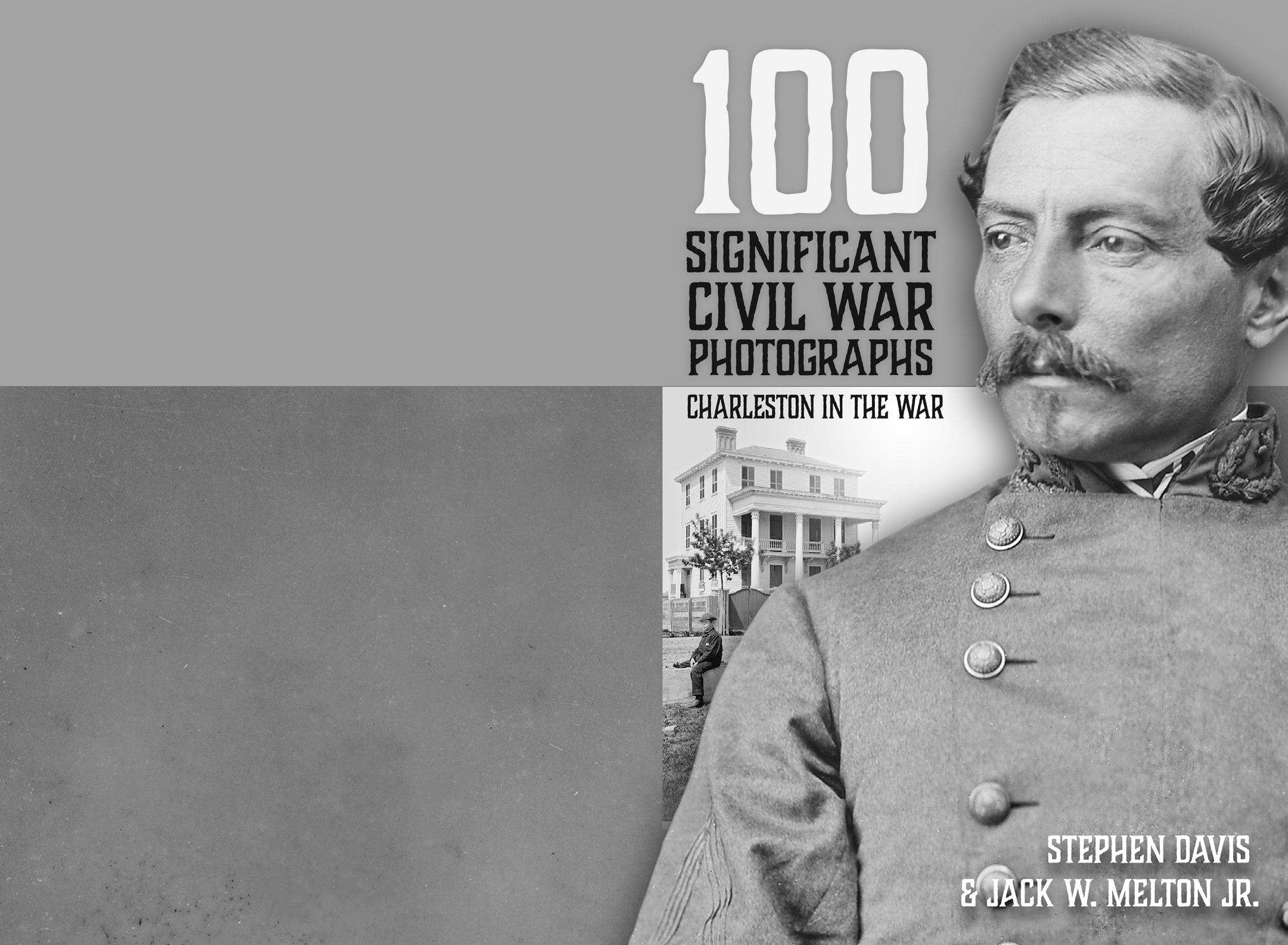
CHARLESTON IN THE WAR



eight yards of cloth with Mr. Byrnes1 —the tailor—in Selma which was to be completed in two weeks and for which cloth I paid One Hundred and
Twenty ($120) dollars.
We were ordered immediately to North Alabama, and I have not been able to hear from it since. The price of making is One Hundred and Eighty Five ($185) dollars.
If you can arrange with Bruno or Moses [servants] to get them [the suit] for me (I understand they are in Selma) I will refund the money in the course of a month or two or as soon as paid. I will have plenty of money when paid and I will refund promptly.
repulsed with great loss. Everything is quiet this morning. The troops are all in very high spirits and they generally consider this the last hard fighting that we will have with this army. I have just seen Louis Hyer.2 I am very much in need of the suit of clothes and hope you will take some steps to secure them. I would not trouble you if I could attend to it myself.
Love to all, In all duty, Geo. W. Wright
cameramen
The cameramen include the better-known, such as George N. Barnard and George S. Cook, as well as some lesser-known ones: Samuel Cooley, Charles Quinby, the partners Haas & Peale, Osborn & Durbec.
Barnard and Cook, as well as some lesser-known ones: Samuel Cooley, Charles the partners Haas & Peale, Osborn & Durbec.
Stephen Davis and Jack Melton accompanies each featured photograph, the pictured scenes and the history surrounding them. e selected depict a variety of settings: that portion of Charleston known as e the “Burnt District” (the area of the city destroyed by the Great Fire December 1861), the Charleston Arsenal, and the many churches that allow Charlestonians to call theirs “the Holy City.” Special sections of this book are the huge Blakely guns imported from England by the Confederates close-ups of Barnard’s views.
of Civil War Charleston goes back to e Defense of Charleston Harbor

Text by Stephen Davis and Jack Melton accompanies each featured photograph, describing the pictured scenes and the history surrounding them. The selected images depict a variety of settings: that portion of Charleston known as The Battery, the “Burnt District” (the area of the city destroyed by the Great Fire of December 1861), the Charleston Arsenal, and the many churches that allow Charlestonians to call theirs “the Holy City.” Special sections of this book are devoted to the huge Blakely guns imported from England by the Confederates and close-ups of Barnard’s views.
John Johnson, Confederate major of engineers, and to Reminiscences of Sumter and Moultrie in 1860-’61 (1876) by Capt. Abner Doubleday, Federal second-in-command. Since then Charlestonians have contributed to the history city, notably Robert N. Rosen and Richard W. Hatcher III. e historical surrounding 100 Signi cant Photographs draws on these and other works. feature is its reliance upon the writings of actual participants, such as T. Smythe (1842–1914) and Emma Edwards Holmes (1838–1910). contribution to this literature, 100 Signi cant Civil War
Photographs: Charleston in the War o ers rewards for all readers, casual novice to the serious student.
The history of Civil War Charleston goes back to The Defense of Charleston Harbor (1890) by John Johnson, Confederate major of engineers, and to Reminiscences of Forts Sumter and Moultrie in 1860-’61 (1876) by Capt. Abner Doubleday, Federal second-in-command. Since then Charlestonians have contributed to the history of their city, notably Robert N. Rosen and Richard W. Hatcher III. The historical text surrounding 100 Signi cant Photographs draws on these and other works. A unique feature is its reliance upon the writings of actual participants, such as Augustine T. Smythe (1842–1914) and Emma Edwards Holmes (1838–1910).
As a contribution to this literature, 100 Signi cant Civil War Photographs: Charleston in the War o ers rewards for all readers, from the casual novice to the serious student.
160 pages, Over 100 Photos, Maps, Index, Bibliography, Softcover.
ISBN: 978-1-61850-167-7
$19.95 + 3.50 S&H
Stephen Davis JACK W. MELTON JR.
Order online at www.HistoricalPubs.com or call 800-777-1862
The government is owing me six months wages. Henry [Henry Thomas Wright (1842-99) George’s younger brother] is at the front as aide to Genl. Finley [Jessie J. Finley, commander of the Florida Brigade in the Army of Tennessee]. I have just heard from him and he is safe— though his command has suffered severely. He is only acting aide for the occasion. I suppose he thought this would be the closing fight, and it would not do for the war to end without his having been in a fight. Fighting and skirmishing has been going on continuously for five or six days. And the enemy has made many night assaults, but have always been
Endnotes:



1. Edward G. Byrnes (1813–79), a tailor in Selma.

2. Louis Hyer (1830–67) of Pensacola, Quartermaster on Finley’s staff and postwar state representative.


Bruce S. Allardice is Professor of History at South Suburban College in Illinois. He is a past president of the Civil War Round Table of Chicago.

Wayne L. Wolf is past president of the Lincoln-Davis Civil War Roundtable.
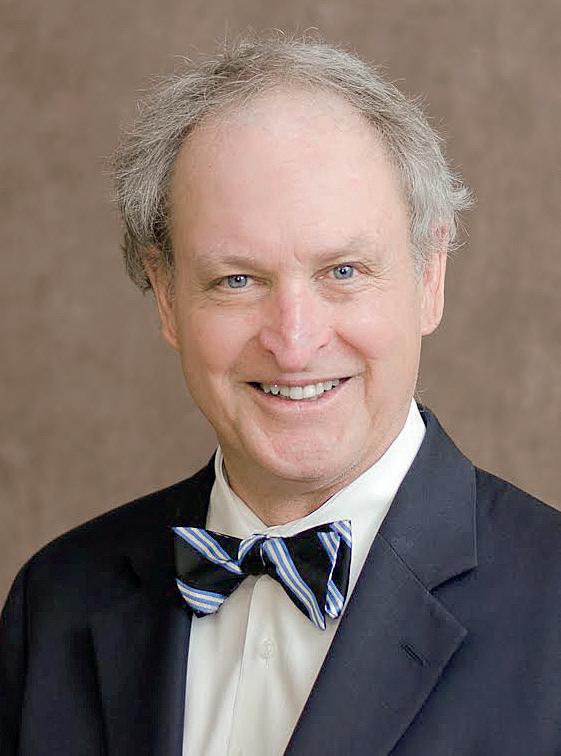
12 CWN August 2020
George W. Wright
Charleston in the War features
scenes in the famed city, taken 1860–1865.
Benjamin D. Wright
cant Civil War Photographs:
newly images of
include the better-known, such as George N.
DAVIS & MELTON 100 SIGNIFICANT CIVIL WAR PHOTOGRAPHS CHARLESTON
THE WAR
IN
Carolina Antique Arms Civil War Period Arms & Equipment Michael Dyches www.CarolinaAntiqueArms.com Phone: 864-871-5325 Email: mdyches.ogma@gmail.com
By Lawrence E. Babits
Civil War
Alphabet Quiz - F
1. Fort that kept Wilmington, N.C., open for blockade runners
2. “That Devil” who said “get there first with the most men”

3. Battle where Cleburn fell

4. He led a cavalry charge against the Texas Brigade on 3 July 1863

5. He said, “Damn the Torpedoes!”

6. Class of Confederate ironclads
7. T. J. Jackson’s infantry nickname


8. Colonel Elmer Ellsworth’s New York regiment
9. Battle that forced evacuation of Richmond and Petersburg
10. Blockade runner converted to CSS Atlanta
The deadline for submissions/advertising is the 20th of each month. Publishers: Send



Answers found on page 47.

13 August 2020 CWN
your book(s) for review to: Civil War News 520 Folly Road,
25 PMB 379 Charleston, SC 29412
Suite
The Gatling Gun
When I was a little kid, walking up Broadway in New York City with my father and best friend Ron, I saw something in a store window on lower Broadway that made me stop immediately. What attracted me was a small Gatling gun, probably a police model. It was $150 if I recall, a price far beyond my range in 1954. I went into the store, Bannerman’s, and found a venue of dusty glory. Between then and the few years the company maintained a retail store presence in the city, I bought a lot of stuff: original percussion cap boxes for fifty cents, McKeever .45-70 cartridge boxes for forty cents. Ah, those were the days!
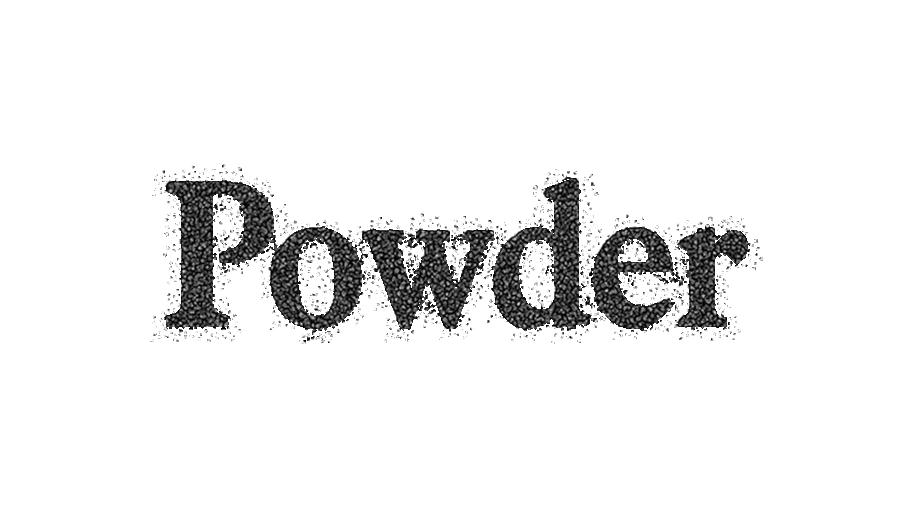
The first Gatling gun, a handcranked machine gun prototype, was invented by Dr. Richard J. Gatling during the American Civil War. The gun was patented November 4, 1862, No. 36,836. The weapon consisted of multiple barrels revolving around a central axis and capable of being fired at a rapid rate. Gatling, interviewed late in life at the turn of the last century, commented on his creation to a reporter. The inventor said he was moved to invent the gun by the idea that while “it might kill more men with bullets, it would preserve many more from death by disease,” apparently because it would shorten the war.

Gatling went on to detail his
by Joe Bilby
experience in convincing the government to purchase his weapon, a difficult task when the man you had to convince was Ordnance Chief Brigadier General James W. Ripley.
According to Gatling, things did not start well for his “ten guns in one.” He had five guns made at a factory in Indianapolis and then “spent much time and money” inventing a cartridge that could be used in his invention. Unfortunately, by the time he had developed a cartridge, the factory where his five guns were made and stored burned down, destroying the weapons.
Subsequently, Gatling had twelve guns made in Cincinnati and transported them to

Washington, where the inventor presented them to General Ripley for testing and possible acquisition. Gatling recalled that his guns “did not shoot lead but simply poured it into a target.” Ripley, more interested in getting the latest model rifle musket in the hands of Union infantrymen, was not impressed. According to Gatling, the general called the guns “mechanical freaks” and advised Gatling that “This was the time for the employment of practical things, experiments would have to wait until the war was over.”
Fortunately for Gatling, Ripley was removed as Chief of Ordnance in late 1863. General Benjamin Butler was in Washington at the time, looked the guns over, saw one shoot, and asked the inventor: “What do you want for them guns?” Gatling answered: Twelve thousand dollars’ and the portly general answered with “They’re bought.”
Butler, a political general not known for his military prowess, was a creative thinker but did not have a good sense of tactical employment. Although Gatling gave a vague account of his guns being used in battle by Butler, he deployed them in artillery positions during the siege of Petersburg.
Gatling provided his turn of the century interviewer with a vague description of the guns in action, adding that an unnamed Confederate prisoner asked: “What in the ---- kind of guns are those Butler is using that he loads all night and shoots all day.”



A differing account comes from soldiers of the 4th New Jersey Artillery (aka Battery D). Assigned to Ben Butler’s Army of the James in 1864, the battery was assigned to defend a position along the line where the Army of the James was bottled up in Bermuda Hundred. One day General Butler brought one of his privately purchased Gatling guns to the 4th’s position in Battery Marshall, a place of honor in the Union lines. The Gatling’s muzzle was pushed through an embrasure, and Butler himself turned the crank and fired about 200 bullets towards the Confederate lines. The only visible effect, according to the Jersey gunners, was the blizzard of musket balls the Rebels fired in response, which wounded several Jerseymen.
Soldiers began to get a grasp on the tactical use of the Gatling gun in the years ahead. Many ended up being issued to the American militia, including that of New Jersey, which replaced its artillery with Gatling batteries. Although George Armstrong Custer thought, perhaps to his final regret, the Gatlings were too bulky to be useful in his final campaign. Whether they would have been a critical factor in saving the 7th Cavalry is something we will never know.
In 1898, Lieutenant John Parker, a Gatling battery commander in Cuba, used the guns for what appeared to be their best role on the offensive. Firing supporting suppressive fire on Spanish positions on San Juan Hill enabled Teddy Roosevelt and his Rough Riders and the 10th US Cavalry to close with the enemy. Although replaced by actual machine guns by World War I, the multi-barrel concept survives in today’s “rotary cannons.”
As if being commanded by one of the most colorful figures in all of America wasn’t enough for Theodore Roosevelt’s Rough Riders, they also had the distinction of carrying into battle four .30-40 caliber Model 1895 Gating guns as well as the first two belt fed, full automatic machine guns ever used by the United States Army in battle. This gun, serial number 1040 was one of Roosevelt’s original four Gatlings used to provide covering fire at the Battle of San Juan Hill, July 1, 1898.
Joseph G. Bilby received his BA and MA degrees in history from Seton Hall University and served as a lieutenant in the 1st Infantry Division in 1966–1967. He is Assistant Curator of the New Jersey National Guard and Militia Museum, a freelance writer and historical consultant and author or editor of 21 books and over 400 articles on N.J. and military history and firearms. He is also publications editor for the N.J. Civil War 150 Committee and edited the award winning New Jersey Goes to War. His latest book, New Jersey:
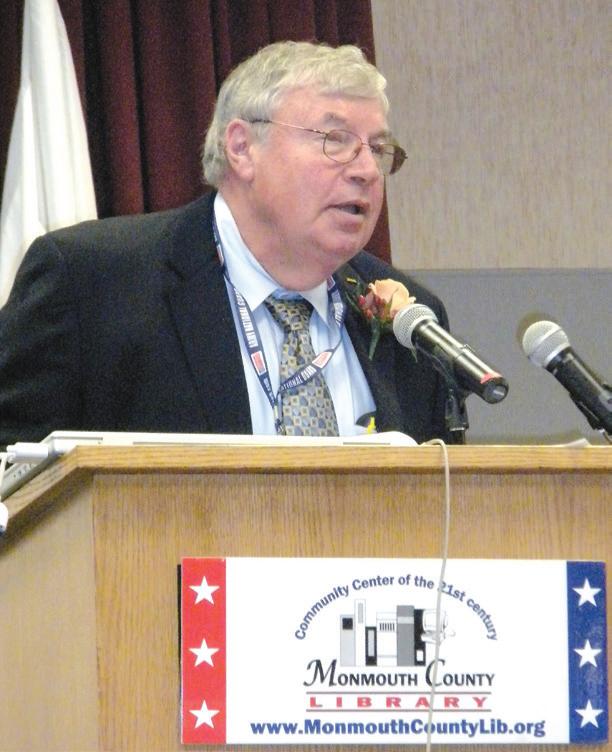
14 CWN August 2020
A Military History, was published by Westholme Publishing in 2017. He has received an award for contributions to Monmouth County (N.J.) history and an Award of
Merit from the N.J. Historical Commission for contributions to the state’s military history. He can be contacted by email at jgbilby44@aol.com.
The Gatling Model 1866,.50-70. Although the Gatling gun was never purchased by the Federal Government for use during the Civil War, some individual officers purchased them for their own use, and they saw action at Petersburg near the close of the war. This post war Model 1866 was similar to its predecessor in the fact that it fired black powder cartridges in sleeved sabots with percussion caps externally mounted to the sleeve. Later models benefited tremendously from the use of self-contained metallic cartridges. Gatling gun photos courtesy the NRA Museum. Photographed by Terry Popkin for the NRA Museum.
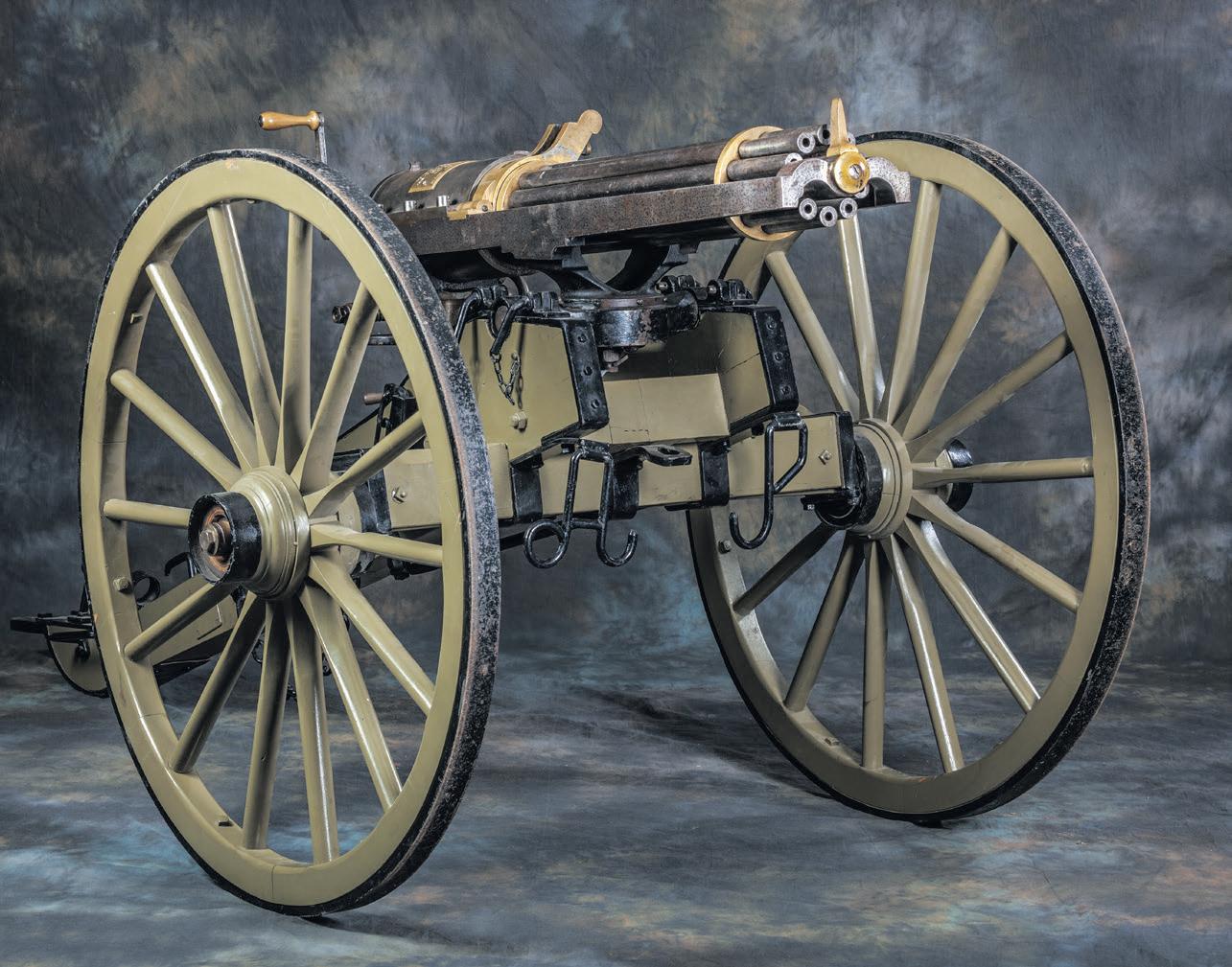
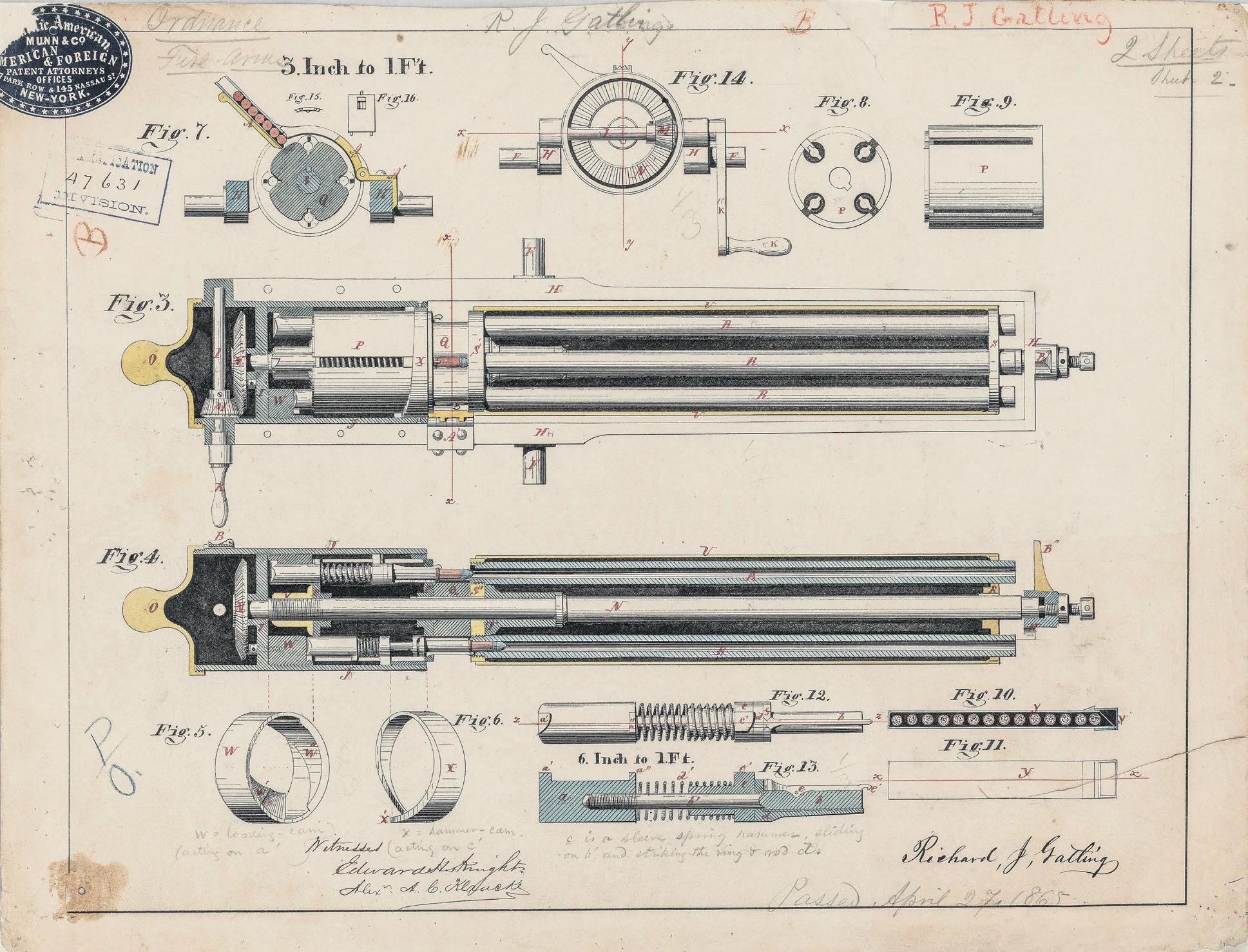

Publishers:
Please send your book(s) for review to: Civil War News
520 Folly Road, Suite 25 PMB 379 Charleston, SC 29412

15 August 2020 CWN
Richard Jordan Gatling. (Sept. 12, 1818 – Feb. 26, 1903). Brady-Handy Collection, Library of Congress.
Original patent drawings for “R.J. Gatling Battery Gun,” patented May 9, 1865, No. 47, 631. NARA 102278484.
Civil War Artillery Book

392 page, full-color book, Civil War Artillery Projectiles –The Half Shell Book. For more information and how to order visit the website www.ArtillerymanMagazine. com or call 800-777-1862. $89.95 + $8 media mail for the standard edition.

The 2020 Civil War Dealers Directory is out. To view or download a free copy: www.civilwardealers.com/dealers.htm



100 Significant Civil War Photographs: Atlanta Campaign collection of George Barnard’s camera work. Most of the photographs are from Barnard’s time in Atlanta, mid-September to mid-November 1864, during the Federal occupation of the city. With this volume, Stephen Davis advances the scholarly literature of Barnardiana.
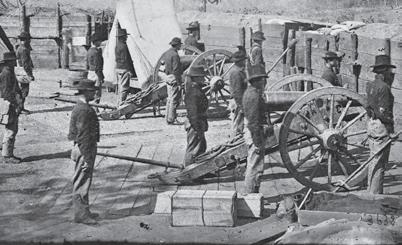
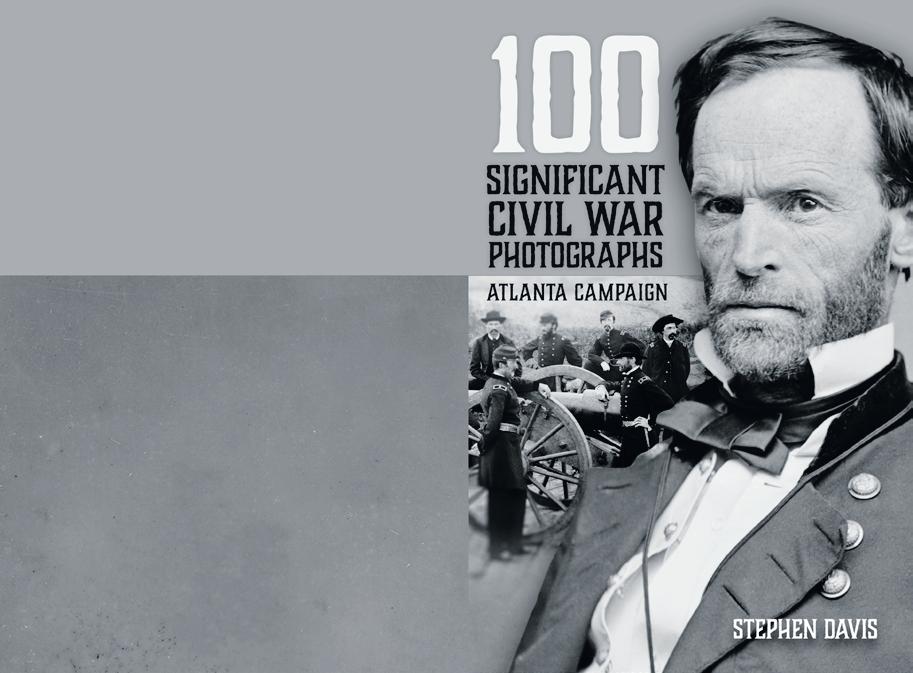
$19.95 + $3.50 shipping
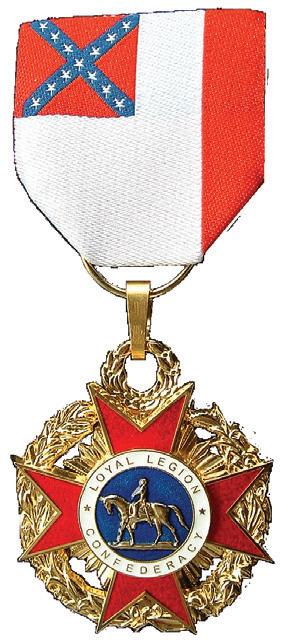

128 pages, photographs, maps, bibliography. $19.95 + $3.50 shipping. Softbound. ISBN: 978-1-61850-151-6. www.HistoricalPubs.com. Order online at www.HistoricalPubs.com or call 800-777-1862


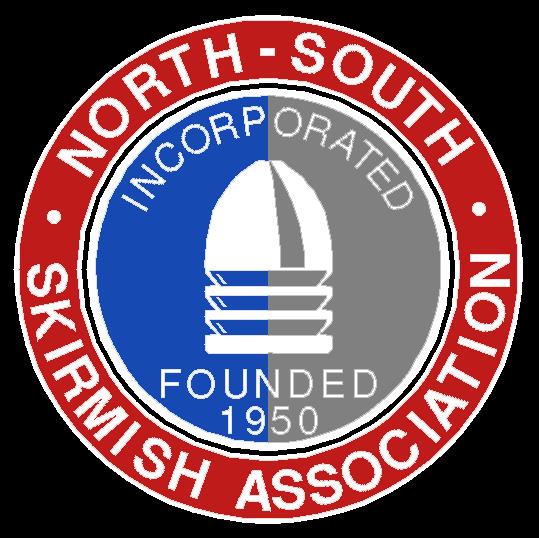
16 CWN August 2020 Digital subscriptions available online at CivilWarNews.com The N-SSA is America’s oldest and largest Civil War shooting sports organization. Competitors shoot original or approved reproduction muskets, carbines and revolvers at breakable targets in a timed match. Some units even compete with cannons and mortars. Each team represents a specific Civil War regiment or unit and wears the uniform they wore over 150 years ago. Dedicated to preserving our history, period firearms competition and the camaraderie of team sports with friends and family, the N -SSA may be just right for you. For more information visit us online at www.n-ssa.org. — MAKER — LEATHER WORKS Museum Quality “Raising The Standard” Made In The USA Visit us at www.DellsLeatherWorks.com • (845) 339-4916 Dedicated to the Common Soldiers Who Fought in The War Between The States AUTHENTIC QUALITY REPRODUCTIONS 31st Edition Since 1999 Accepting Discover, Visa, MasterCard and American Express Loyal Legion of the Confederacy CSA National Defense Medals & other banned internet items Civil War Recreations WWW.CWMEDALS.COM cwmedals@yahoo.com 1 Smithbridge Rd., Unit 61, Chester Heights, PA 19017
The American Civil War was the first war in which both sides widely used entrenchments, repeating rifles, ironclad warships, and telegraphed communications. It was also the first American War to be extensively photographed. Mathew Brady, Alexander Gardner and Timothy O’Sullivan are famous for having made iconic photographs in the Civil War’s eastern theater. George N. Barnard deserves to be ranked in this top tier for his photographic A civilian photographer hired by Gen. William T. Sherman’s chief engineer to take pictures of fortifications around Atlanta, Barnard took several hundred of them in and around the city in the fall of 1864. His most famous is the site of Union Maj. Gen. James B. McPherson’s death in the battle of Atlanta, July 22, 1864. Thus far, no comprehensive, definitive listing has been made of the photographer’s work. The Library of Congress has 130 images; the U. S. Military Academy at West Point, New York, has at least 98 photographs, donated by Captain Poe’s widow. Other repositories, such as the Gilder Lehrman Institute of American History in New York City, have smaller collections. For this book we have chosen a hundred images we deem “significant,” though other students may wonder at some of our selections. We hope that this work will stimulate further interest in Barnardiana, and that other scholarly volumes are yet to come. The Atlanta Campaign STEPHEN DAVIS 100 SIGNIFICANT CIVIL WAR PHOTOGRAPHS ATLANTA CAMPAIGN
A Passion for Civil War History, Artifacts and Preservation
by Paul T. Scott
Growing up in the town of Fredericksburg, Va., having forebears with military service, and my own and varied experiences led me to take the challenge of service on the Board of Directors of the Central Virginia Battlefields Trust (CVBT). What possesses one to serve a cause where there is hallowed ground to save with few funds available before the blade of the bulldozer obliterates it? Experiences and understanding.
In 1946, my dad, D. William Scott Jr., moved back to Fredericksburg with his wife, Margaret, and his sons, David, age 5, and Paul, age 3, and settled into the old family home with my grandparents at 1100 Charles Street. There was still damage to the rafters from two shells received during the Battle of Fredericksburg. The house has been in the family since 1872 and was the home of two Confederate veterans and their ancestors.

As children, we roamed the streets, absorbing its history and taking much for granted. Though an elder cousin warned us not to go up on the third story of the home, since there was “Yankee blood” on the floors up there, we explored the upper reaches of the house and certainly believed we found the gory traces of the war. Like many other homes, the house had been
used as a hospital during the Civil War since the wounded streamed back into town from the Battles of Fredericksburg, Chancellorsville, and the Wilderness, for hospital treatment.
At about age 6, I noticed that my dad had an old gun stashed in a sock in his top dresser drawer. He said it was a “horse pistol” that had belonged to Capt. Doggett. Occasionally, I asked dad to take it out of the sock to show me. I held it in awe, thinking of what it had seen and where it had been. Capt. Doggett took two revolvers off to war as an officer in Company B, 30th Virginia Infantry. He had been an organizer of its predecessor, the Fredericksburg Grays, in 1859. Being an ardent “secessionist” at age 45, he went to war with his unit. On September 17, 1862, near Dunker Church during the Battle of Antietam, he was wounded.
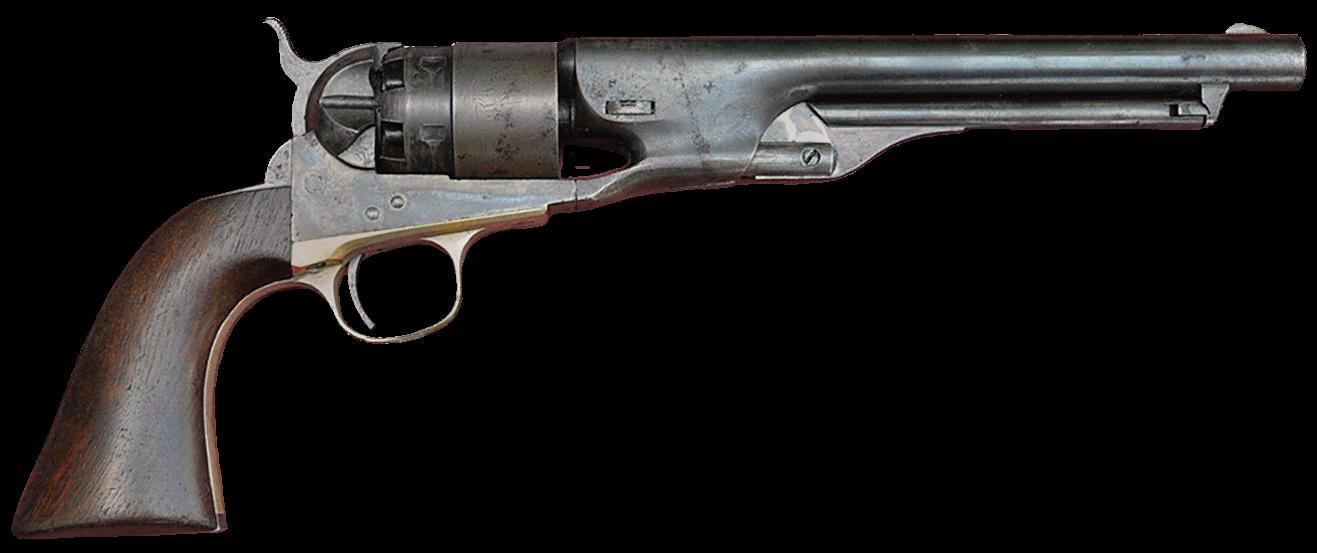
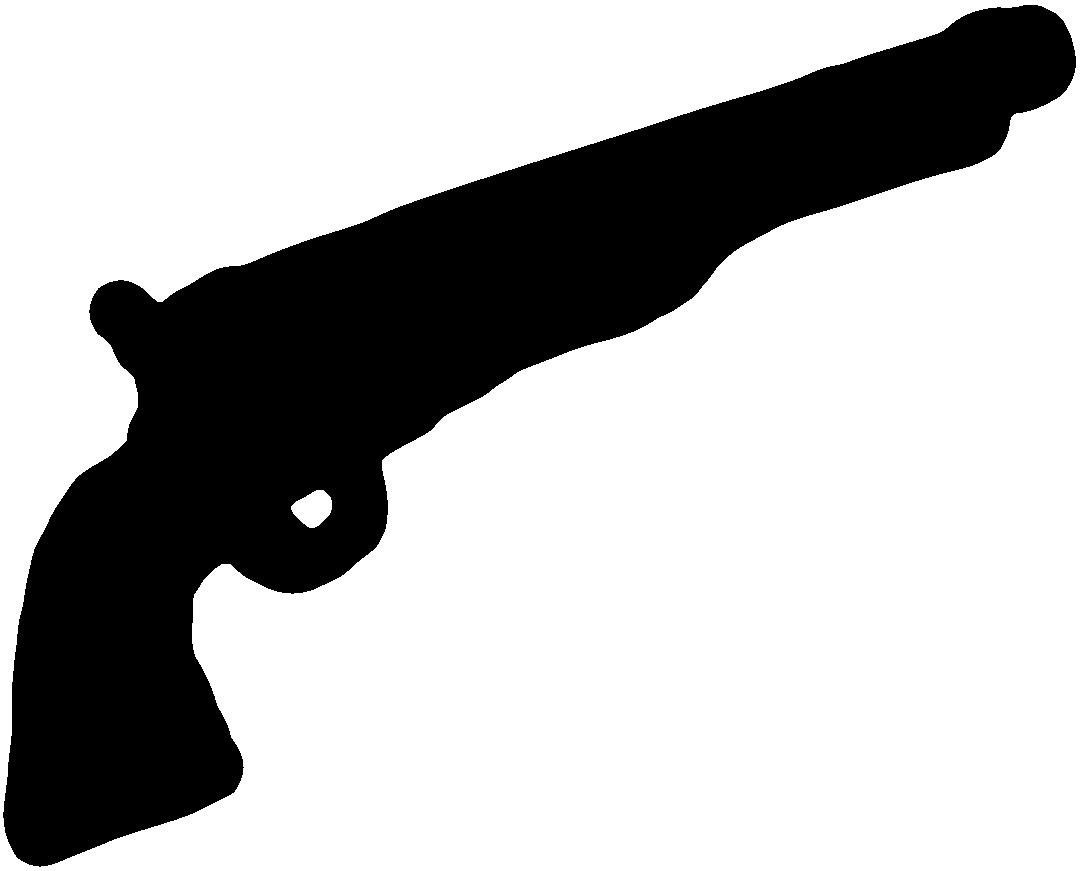
Family lore has him saying, “keep on a fight’n boys, my guts are dragging the ground.” He was absent on a surgeon’s certificate beginning March 3, 1863, and on July 30, 1863, he was declared unfit for service for six months. On September 5, 1863, he was assigned to duty at Camp Lee. In 1864, he took command of Virginia reserve forces near Fredericksburg, and on September 9, 1864, he became provost marshal of the town. On March 14, 1865, he retired to the invalid corps.
In the 1950’s, there was a push to update Fredericksburg. As a youngster exploring its streets, I saw various buildings torn down for “modernization.” Even as a child, I thought what a shame, this town is erasing its own history and destroying what remained of “the old.” How could they be preserved? I wondered.
In 1949, dad purchased three acres on Aquia Creek in Stafford County and constructed a cottage for summer vacations. While walking along the mud flats, my brother and I found white oxidized three-ring
Minié balls. When we asked dad about them, he explained that Aquia Landing was a major supply depot during the Civil War. With this tantalizing information, we returned for many searching trips. After finding a pepperbox pistol in front of our property and a three-branch guard and pommel from a Union cavalry saber, my addiction was complete.
My brother and I purchased an army mine detector through a military surplus catalog and began our organized search for Civil War relics in Stafford County. We were fortunate to have permission to go into the Rhode Island camp on Mt. Ringgold Farm in the White Oak area and Camp Aleman, a New York camp owned by Joe Davenport at Kelly’s Bottom in Falmouth. We found U.S. buckles, cartridge box plates, eagle plates, canteens, buttons, and bullets, as well as chimney bricks at the end of the hut sites constructed by the Yankees. These properties are now housing subdivisions, and all the tent holes have been bulldozed. There were dozens of Stafford County campsites that suffered the same fate over the ensuing thirty to forty years. Even a redoubt on the road to Aquia Landing was bulldozed. Such senseless acts have been beyond my comprehension and helped to fuel my passion for land preservation. Of the hundreds of hut sites in Union camps in Stafford County, most have been destroyed except those saved for the Stafford Civil War Park near Brooke. Against the odds, Glen Trimmer, D. P. Newton, and other key supporters preserved the land, hut sites, and redoubts and placed reproduction cannons there.
After graduating from the University of Virginia in 1965, I entered military service and was commissioned a lieutenant in the United States Army Medical Service Corps.
After six weeks of intense training, I reported to the 1st Battalion, 27th Infantry Regiment to assume the duties of a Medical Platoon Leader. In January 1966, the regiment deployed to Vietnam. My experience as a field medic often made me think of the Civil War soldiers and all they endured. In 1967, at the end of my active duty military service, I entered law school at the University of Richmond on the GI bill. I returned to my hometown and practiced law for 44 years and retired in 2014. During that time, I joined Historic Fredericksburg Foundation, Inc. and served as its president for a year.
Years earlier, my brother, David, and I had been given the “gun in the sock” and made it a part of our collection of Civil War artifacts. When we had to divide this collection, our parents waited for a fight to break out. But it went peaceably with each set of relics decided by the toss of a coin. I was fortunate to receive “the gun in the sock” and discovered it was an 1860 Colt Army revolver. It had few matching serial numbers, a replaced wedge, loose loading lever, and no cylinder scene. But with its provenance it is a special piece to me. After a little research, I discovered that the pistol’s one-time mate is still in the extended family, in the hands of a cousin.

Through the Civil War Roundtable of Fredericksburg, I met Civil War authors and historians, including Robert Lee Hodge, Bradley Gottfried, Chris Mackowski, and Eric Wittenberg; all have been active in battlefield preservation. In 2018, I was invited to join the Board of Directors of CVBT. As chairman of the Partnership and Outreach Committee, I have the pleasure of meeting many relic dealers and publishers when I set up the CVBT display table at various Civil War shows
Paul Scott is an active advocate for battlefield preservation, often reaching out at community events or relic shows.
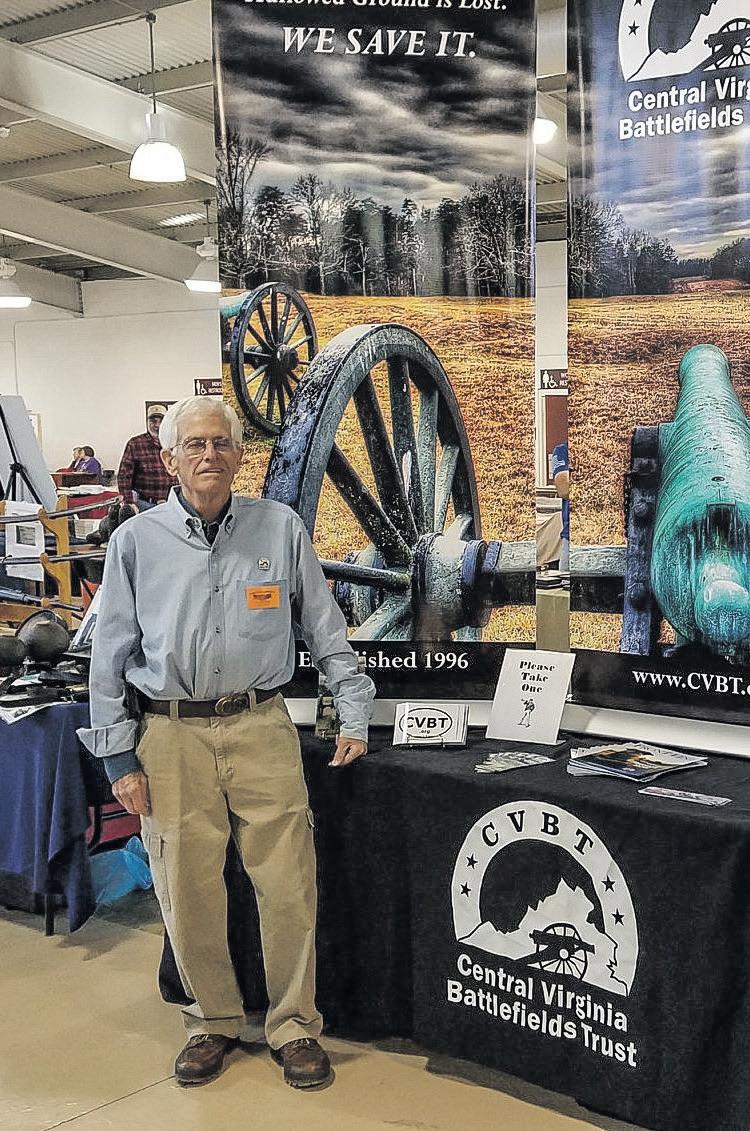
and other events.

What attracted the armies of the north and south to clash here is the same reason it attracts development: proximity to Washington, D.C. Since its formation in 1996, CVBT has preserved over 1,300 acres. We should remember that preservation is not only for battlefields hallowed with the blood spilled by Americans, both North and South, but also for the preservation of green space. Given our location, it may be some of the only open land that our children and grandchildren will enjoy in the future.
Central Virginia Battlefields Trust saves Civil War battleground to preserve the memory and meaning, sacrifice and stories of the men who fought at Fredericksburg, Chancellorsville, The Wilderness and Spotsylvania. Learn more: www. cvbt.org.

17 August 2020 CWN Subscribe at CivilWarNews.com Cliff Sophia | Proprietor CSArms.com 9150 John S. Mosby Hwy. (Rt. 50) Upperville, Va 20185 for US Mail: PO BOX 602 (540) 592-7273 • SophiaCSArms@aol.com Collector’s Arms 1700-1945 Militaria Specializing in Civil War-World War II
The Scott family’s home at 1100 Charles St., Fredericksburg, Va.
A Few Thoughts on the U.S. Model 1841
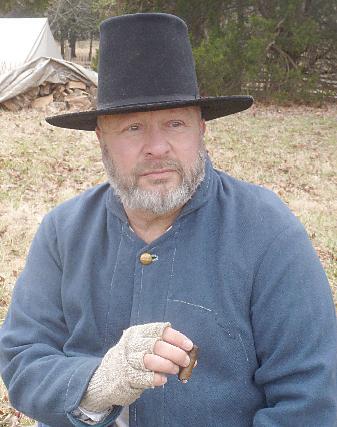
Percussion Rifle
The decision to abandon flintlocks and start producing percussion rifles and muskets led to a new military rifle design in 1841. The so-called U.S. M1841 rifle was stocked in hard oiled finished, Pennsylvania grown, American Black Walnut and brass mounted, weighing nine pounds twelve ounces, with an overall length of 48 ½ inches. The lacquer brown .54 caliber barrel was 33 inches long with seven grooves and a (slow) 1:72 inch twist. The 5 ¼ inch lock plate was flat with beveled edges; the plate and hammer were color case hardened by quenching, and the lock plate was let into the stock to bevel height.


All furniture was polished brass. The barrel was secured by two band springs that held brass
bands in place. The upper band was doubled looped, 2 9/16 inches long on top, and 3 ¼ inches long on the bottom. Both upper band straps were 15/32 inch wide. Screws and sling swivels were oil quenched and blackened.
The barrel carried the inspected, proofed, and acceptance (“V,” “P,” and “Eaglehead”) stamps, as well as a date on the 2 1/16 inches long tang that usually matched the lock plate date. Some contractor made barrels were stamped ‘STEEL.”
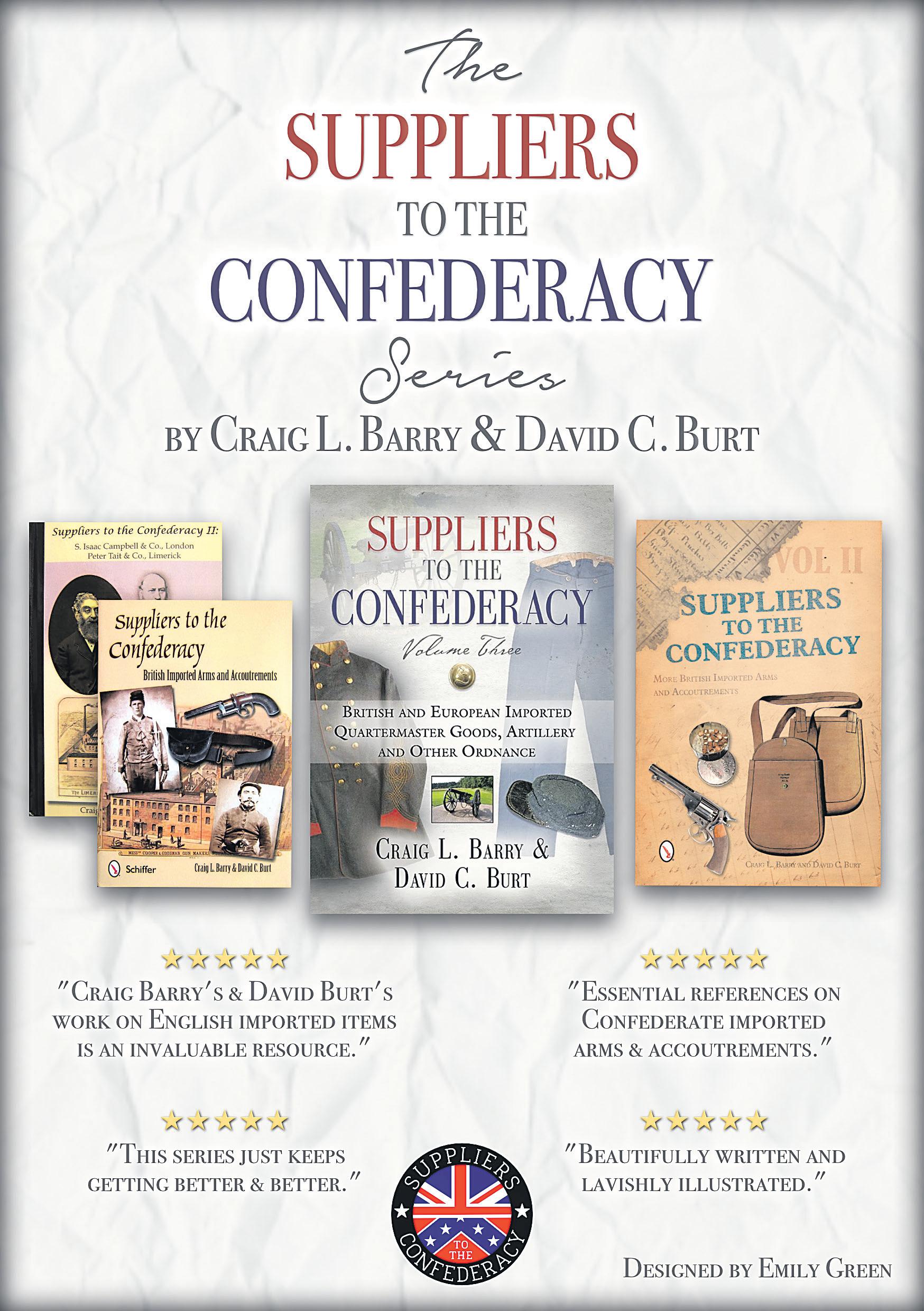
The stock was marked with an inspector’s cartouche in the round or oval styles of the 1840’s or the square or rectangular styles of the 1850’s opposite the lock. A simple brass blade set 13/16 inch from the muzzle served as a front sight. The non-adjustable rear sight was a simple “v” notched block in the “Pennsylvania/Kentucky” rifle tradition. Surprisingly, for a rifle, the sights were set for fifty yards.
The brass trigger plate was nine inches long with rounded ends and held a blued trigger on a lug. A separate brass trigger guard (bow) was attached with two spanner nuts. The 4 3/8 inch brass flat butt plate was stamped with a small “US” to the rear of the upper tang screw. The 32 ¾ inch bright steel ramrod had a 23/32 inch long brass trumpet or flared shaped tip with a concave front for loading round balls. A “spoon” device in the stock channel secured the ramrod.
A distinctive feature of the U.S. M1841 rifle was its large brass patch, or implement, box that measured 7 5/8 inches by 1 11/16 inches. The bottom of the patchbox mortise typically carried one large very shallow circular cut centered with sometimes two others faintly visible on the side with shallow holes in their centers, remnants of the bit used to make the mortise depth cut. The bottom front end of the mortise was drilled out to hold the space cone.
Inside the implement box were carried the three M1841 rifle’s tools; on top was a wiper with a long shaft, in the center the combination tool, a cone wrench with a single screwdriver arm, and on the bottom a ball screw on a short shaft to allow it to fit next to the cone. When all three tools and a spare cone were carried, there was little room for anything else in the box. Most tools were contractor made and were japanned black or oil quenched blackened carrying a stamp such as “S,” “M,” or a large “US.” Springfield and Harpers Ferry-made tools have a grayish blue finish with a small ‘US” stamped on them.
The lock plate was stamped with the name of the maker in one or two vertical lines over the year behind the hammer. For those made at Harpers Ferry Armory, a spread eagle and “U.S.” were in front of the hammer.
The M1841 percussion rifle used a cartridge containing a pre-patched .535 round ball and 75 grains of powder. The M1841 rifle would have an influence on the new advanced design for the
.58 caliber M1855 rifle that incorporated both the new .58-minie bullet as well as the Maynard tape primer system. The first two (of five) variations of the U.S. M1855 rifle, made in 1857 and then modified in 1858, were brass mounted like the M1841.
Production of the M1841 rifle did not begin at U.S. armories until 1846 when 700 were turned out at Harpers Ferry. Between 1846 and the end of production in 1855, 25,296 rifles were produced at Harpers Ferry. There is some controversy over production at Springfield Armory as there are no records indicating any production of M1841
rifles but some believe a limited number (3,200) were produced in 1849. Springfield records are somewhat unclear; the 3,200 referenced as “3,200 arms” may not be M1841 rifles but rather shortened M1842 muskets altered for the Fremont Expedition. It is worth noting that any M1841s produced at Springfield Armory would be exceedingly rare because Springfield did not produce muzzle loading rifles similar to the M1855 either, only the longer three band rifle musket. Harpers Ferry Armory made the U.S. model rifles. The reasons for this division of manufacture were not documented.
18 CWN August 2020
Union soldier wearing sergeant’s uniform and Company H forage cap with revolver, musket, and attached U.S. Model 1862 “Zouave” sword bayonet. Liljenquist Family Collection of Civil War Photographs. Library of Congress.
Closeup of the Union soldier.
The rifled military arm was far from a new design by the time of the Civil War. The smoothbore muskets still dominated as the military arms because of the difficulty in loading a rifled infantry arm quickly or repeatedly. To be effective, a rifle required a tight-fitting projectile to achieve the necessary compression and take the spin afforded by the rifled barrel. The problem was that once the barrel heated up, the tight-fitting bullet no longer loaded as quickly or easily.
Taking a practical feature from the frontier, it was discovered that a slightly smaller bullet wrapped in a greased patch rammed home much more easily. The use of the patched round ball also gave rise to a distinctive characteristic of the frontier hunting rifle, the patch box on the rifle stock. In the patch box one could easily store a supply of greased patches (or grease) and keep them free of dirt and contaminants that would normally stick to such a material stored elsewhere. It also held various necessaries such as tools, spare flints, or a spare cone if the rifle had a percussion lock. The patch box is still a feature found on flint and percussion “American mountain” black powder hunting rifles, but in terms of any military application it proved short-lived.
The United States was quick to adopt and improve upon the new ballistics technology but with a nod to its frontier heritage, it was slower to adopt the new trends in military arms design, particularly where elimination of the patch box was concerned. TheM1841 percussion rifle had a large brass patch box in the stock. The Maynard tape primer M1855 rifle still had a patchbox when production began in 1857, as did the last generation of the three band M1855 rifle-muskets in production through early-1861. Strong consideration was given to continuing the patchbox for the new U.S. M1861 rifle musket; a prototype version with a round lid was proposed but never produced. The following account from Claud E. Fuller’s classic The Rifled Musket, (1959) lends insight into the discussions which occurred during 1860, just prior to the Civil War:
From the best information the board can obtain from officers using the rifle musket it appears the patchbox is very convenient and useful for carrying a greased rag or grease. The report of inspectors general indicates that the same difficulty has been found in our service that has been reported in the British service in India with regard to the drying up of the grease used in the cartridge as a
lubricator for the bullet of the rifle musket; and as the use of a lubri cating material is very important for accurate shooting with these arms, the Board is of the opinion that the patchbox should be re tained, and they recommend the adoption of the pattern presented from Springfield Armory (marked A 117) as the neatest and cheap est plan offered. Major Hagner desires to record his dissent to the above recommendation...the arm fabricated for the general service should consist of as few parts an [sic] be as little costly as possi ble to fit for effective service. The patchbox in the stock is costly and cannot be of general use in the ranks as grease...renders the arm untidy to handle if so used. Should marksmen on special ser vice in deliberate firing find it best to have an additional supply of grease on hand it can be car ried with equal convenience in a box detached from the gun and of little cost. The patchbox has not been applied to the rifle musket in any European service, as far as known to me although the cartridges used by them are not superior to our own.
Ultimately, the exigencies of the Civil War and its increased demand for small arms dictated that cost and additional production time necessary to add a patch box was no longer desirable, at least on U.S. model rifle muskets. The projectile or (for the Enfield) the cartridge paper itself was lubed instead. The patch box was still found on commercially made military rifles of proprietary design such as the Sharps rifle even though they were breechloaders with no need of a greased patch. The M1841 continued to see service throughout the Civil War; despite the design being 20 years old, it was far from obsolete.
Craig L. Barry was born in Charlottesville, Va. He holds his BA and Masters degrees from the University of North Carolina (Charlotte). Craig served The Watchdog Civil War Quarterly as Associate Editor and Editor from 2003–2017. The Watchdog published books and columns on 19th-century material and donated all funds from publications to battlefield preservation. He is the author of several books including The Civil War Musket: A Handbook for Historical Accuracy (2006, 2011), The Unfinished Fight: Essays on Confederate Material Culture Vol. I and II (2012, 2013) and three books (soon to be four) in the Suppliers to the Confederacy series on English Arms & Accoutrements, Quartermaster stores and other European imports.
Gun Works, Inc.
KEEPING
The muzzleloading community is diverse and encompasses a broad range of interests and professions, brought together by a shared passion for all things blackpowder. From re-enactors to modern hunting and competitive shooting, DIXIE GUN WORKS’ catalog has been a staple for generations of blackpowder enthusiasts. Our 2020 catalog has the world’s largest selection of blackpowder replica arms, accessories, antique parts, muzzleloader hunting and sport shooting equipment.

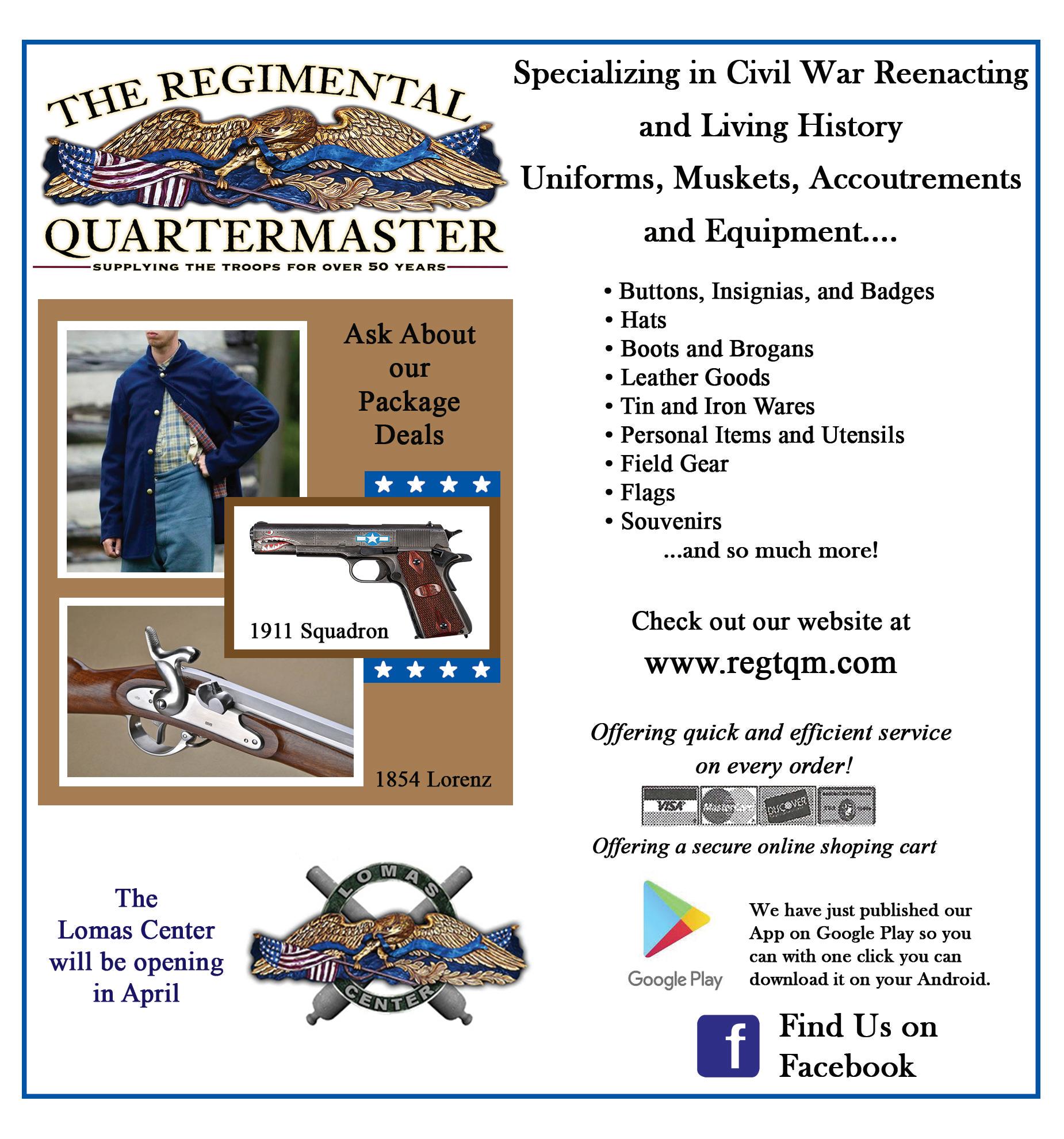
19 August 2020 CWN
VIEW ITEMS AND ORDER ONLINE! www.dixiegunworks.com Major credit cards accepted FOR ORDERS ONLY (800) 238-6785 PROFESSIONAL SERVICE AND EXPERTISE GUARANTEED DIXIE GUN WORKS, INC. 1412 W. Reelfoot Avenue PO Box 130 Dept. 17 Union City, TN 38281 INFO PHONE: (731) 885-0700 FAX: (731) 885-0440 EMAIL: info@dixiegunworks.com
TRADITION ALIVE
Want To Advertise In Civil War News? Email us at ads@civilwarnews.com or Call 800-777-1862 For a rate sheet visit: www.civilwarnews.com
Dime Novels
During the war, soldiers loved to read, especially during the downtime in camp. Newspapers, letters from home (the favorite of most), the Bible, and various dime novels populated the literary menu for the voracious consumers. Dime novels, which gained in popularity in this country during the years leading up to the war, skyrocketed in the number of new titles introduced in 1861. This trend continued through 1865 and beyond.

Thanks to the ongoing efforts of Villanova University’s Falvey Memorial Library, researchers can access dime novels online at https:// dimenovels.org, and peruse various issues beginning in 1852, and running through 2019. This site serves, as indicated in the name—Dime Novel Bibliography—as a collection point, which indexes dime novels
held in several different repositories. Villanova staff continue their digitization efforts, so bookmark this site and check back periodically, and visit them on Facebook and Twitter; follow them on either social media platform to receive updates more quickly
Begin your journey at the homepage (pictured above) and request a free account for full access to the site. Various filtering options exist; this writer decided to use the ‘by year’ method to quickly access issues from the war years.


Researchers will profit in reading the same material many soldiers viewed 160 years ago. Even the fictional accounts can add meaning to the thoughts of the soldiers, and assist in better understanding the world they lived in. On the non-fiction
front, some issues distributed during the war carried information on different Federal officers. For example, an issue dated November 14, 1862, offered an installment in the ‘Men of the Time’ series, which featured background stories on Generals Hooker, Rosecrans, Grant, McClernand, and Ormsby Mitchell. Editors included illustrations of some of these men, like the shown image of Grant.
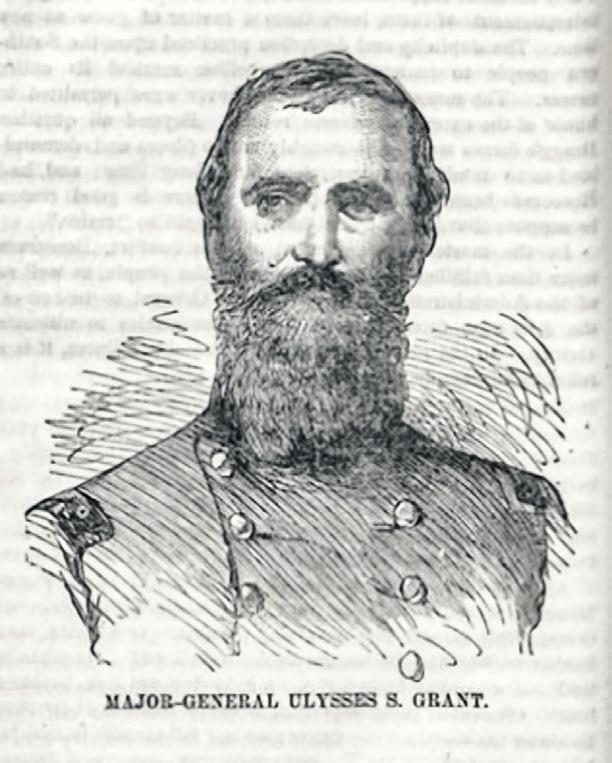

For those interested in the history of dime novels, please visit the companion site, Paper for the People, at https://exhibits.library.villanova. edu/dime-novels.
Next month, we will investigate additional primary sources. Until then, good luck in researching the Civil War!
Michael K. Shaffer is a Civil War historian, author, lecturer, instructor, and a member of the Society of Civil War Historians, the Historians of the Civil War Western Theater, and the Georgia Association of Historians. Readers may contact him at mkscdr11@gmail.com, or to request speaking engagements, via his website www.civilwarhistorian.net. Follow Michael on Facebook www.facebook.com/ michael.k.shaffer and Twitter @ michaelkshaffer.

20 CWN August 2020 Subscribe online at CivilWarNews.com
March 17, 1862, cover of Beadle’s Dime.
Dime Novel homepage.
U.S. Grant illustration in Dime Novel.
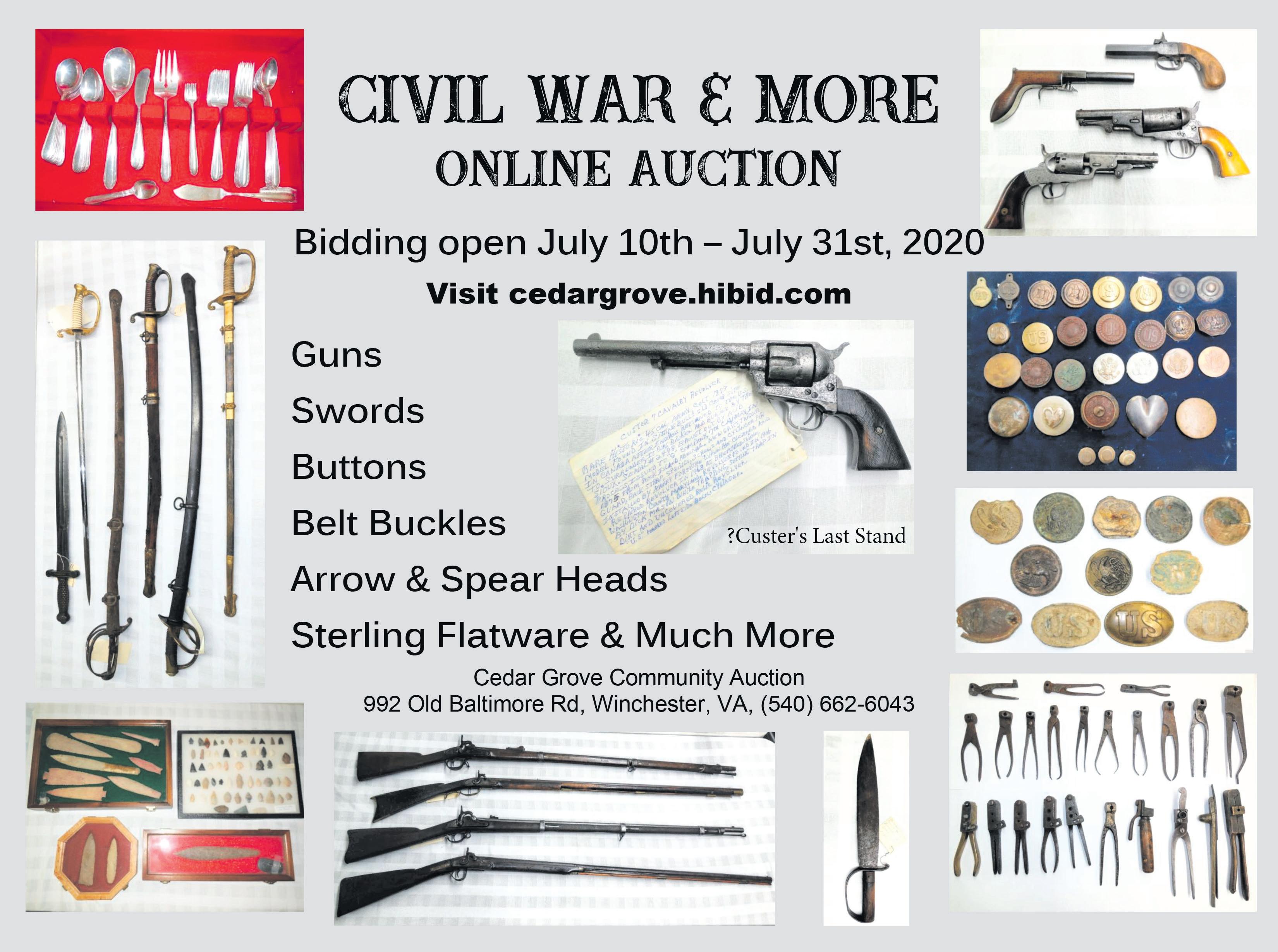
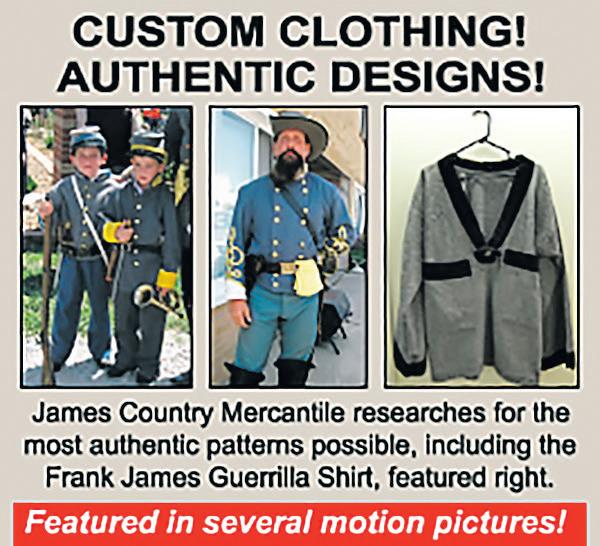



21 August 2020 CWN 19th CENTURY LIVING HISTORY! James Country MERCANTILE 111 N. Main Liberty, MO 64068 816-781-9473 • FAX 816-781-1470 www.jamescountry.com Ladies – Gentlemen Civilian – Military • Books • Buttons • Fabrics • Music • Patterns • Weapons Mens, Ladies and Children’s • Civilian Clothing • Military Clothing • Military Accessories • Accoutrements Everything needed by the Living Historian! Our Clothing is 100% American Made! The home of HOMESPUN PATTERNS© MI Military Images magazine MilitaryImagesMagazine.com | Facebook.com/MilitaryImages Since 1979, MI has been America’s only publication dedicated to historic photographs of soldiers and sailors. By check payable to: Military Images PO Box 50171 Arlington, VA 22205 Online: MilitaryImagesMagazine.com SUBSCRIBE NOW 4 quarterly issues, $24.95 Want to try before you subscribe? Visit MI’s website to sign up for a 2 issue trial. TRIAL ISSUES
Wanted: Eighteen-Foot-Tall Men
“To capture Richmond would be grand, but to capture Charleston would be glorious.” –Soldier, 11th Maine
In 1862, the walls of Fort Pulaski, Ga., crumbled under the fire of U.S. Gen. Quincy Gillmore’s rifled cannons, rendering masonry fortifications obsolete around the world. In July 1863, Gillmore’s imagination turned to “the cradle of the rebellion,” the city of Charleston. Fierce fighting had not weakened the Confederates’ resolve. Would their determination hold
if Charleston were shelled? It would be an engineering feat to construct a battery on top of the salt marsh. But would it be possible?
On July 16, Gillmore told engineer Col. Edward W. Serrell to find a site to build a battery between James and Morris Islands in Charleston Harbor. Before the War, Serrell assisted with the design and construction of railroads and bridges internationally. He helped raise the 1st NY Volunteer Engineer Regiment and his military suggestions included long wire, armor plate, impromptu gun carriages, and iron viaducts.


After breakfast Serrell and Lt.
Nathan M. Edwards,


1st NY,
under the watchful eyes of three Confederate forts and twelve batteries, examined the marsh. The site consisted of “soft, black mud, from sixteen to eighteen feet in depth, overgrown with reeds and grass, traversed by numerous deep and tortuous bayous, and subject to daily overflow by the tides.” The men were able to support themselves crossing unstable mud by sitting on a fourteen-foot plank as they pushed it forward between their legs.
In the evening, Serrell proposed building the battery about 7,900 yards from Charleston in a location where the mud “seemed of slight depth.” Pilings pounded into the mud, with sandbags atop a platform of grillage, made of large yellow pine logs, could support a gun not weighing over 10,000 pounds.

On August 2, Gillmore approved the plan for construction. According to talk around camp, Serrell tasked a young lieutenant to oversee the build. A jester requisitioned, “twenty men eighteen feet tall to do duty in fifteen feet of mud,” and that “the regimental surgeon splice three six-foot men together to give him his eighteenfoot-tall man.”
The hurried construction was hard labor, in intense heat, under Rebel fire. It took the weight of thirty men to drive each piling down into the mud. A two to fourfoot-wide and seventeen-hundred-yard plank road was built. Along the slippery boards, the 7th New Hampshire men would fall into the marsh while carrying 13,000 sandbags during the hour trip. The 7th referred to the project as the Marsh Croaker, Mud Lark, and Serrell’s Folly. Another soldier described it differently, “We’re building a pulpit on which a Swamp Angel will preach.”
The “Swamp Angel” was an 8-inch, 200-pdr. Parrott rifle cannon weighing 16,577-pounds.
To fire a shell capable of reaching Charleston, Serrell estimated the cannon needed to be elevated to an angle never used before by a large Parrott and would require loading 20 pounds of powder instead of the usual 16. Furthermore, when considering the Parrott’s reputation for bursting, the whole endeavor could be

22 CWN August 2020
Gen. Edward Wellman Serrell; Colorization © 2020 civilwarincolor.com courtesy civilwarincolor.com/cwn. Library of Congress.
Drawing of the burst Swamp Angel from Plate XXXIII, from the book, Engineer and Artillery Operations Against The Defenses Of Charleston Harbor: 1863. The 8-inch Parrott rifle burst firing its 36th round firing a projectile weighing 150 pounds, with a propellant powder charge of 16 pounds, at 31° 30' elevation.
Gen. Quincy Gillmore; Colorization © 2020 civilwarincolor.com courtesy civilwarincolor.com/cwn. Library of Congress.
considered an artillery and construction experiment.
On August 21, Fort Sumter was already under Federal fire when Gillmore received word the Marsh Battery was ready. Gillmore sent a message to his counterpart, C.S. Gen. Pierre Beauregard, “demanding the immediate evacuation of Morris Island and Fort Sumter by the Confederate forces” or Charleston would be fired upon in the “heart of the city.” Beauregard was out when the letter arrived. His staff, due to lack of signature, did not believe it was an official message and returned the letter.
Lt. Charles Sellmer, 11th Regiment Maine Volunteers and his regiment were tasked with manning the battery. Orders had been issued to fire the Swamp Angel towards St. Michael’s steeple in Charleston every fifteen minutes, and at night, both to avoid Federal shipping and to prevent endangering Federal POWs. A compass reading had been taken and the bearing chalked in the Swamp Angel’s position. It was the first known use of a compass reading in firing an artillery piece. Low tide delayed the arrival of the boats with the cartridges until one o’clock on the morning of August 22. At 1:30 a.m., the first shot was fired.
War correspondent Frank Vizetelly was reading in his hotel room when he heard “the whirr of a phantom brigade of cavalry galloping in mid-air…My first feeling was that of utter astonishment; but a crash, succeeded by a deafening explosion in the very street on which my apartment was situate, brought me with a bound into the centre of the room. Looking from the window, I saw smoke and fire issuing from a house in which were stored the drugs of the medical purveyor....The hotel was crowded with speculators who had been attracted to the city by the sale of some blockade cargoes, and the corridors were filled with these terrified gentlemen rushing about in the scantiest of costumes and the wildest alarm.....On reaching the hall I found a motley crowd, some of whom with the biggest of words were cursing the Federal commanders. Whirr! came another shell over the roof, and down on their faces went every man of them into tobacco-juice and cigar-ends and clattering among the spittoons.”
To the surprise of the 11th Maine, “at every shot fired from the Swamp Angel gun the whole structure swayed to and fro as if it were a vessel afloat. The pintle block holding the gun-carriage in place moved gradually from the epaulement with each shot, until
after the sixteenth shot it had gotten back nearly three feet,” ending the firing.
Beauregard sent a message protesting the bombardment without allowing non-combatants to leave the city. Serrell had estimated it would take two days to make the necessary repairs. Gillmore avowed he would hold
off resumption of firing until 10 p.m. of the 23rd.
On August 23, the 11th Maine had to wait for hours “…around the battery, seated upon loaded shells, watching the enemy’s projectiles as they approached… luckily not a single shell burst in the air, all striking quite near enough, but sinking into the mud
before exploding. Mud-spattering the only damage caused by them.”
As per Gen. Edward Wellman’s orders, at 10 p.m. the command was given to “Fire.” The seventeenth shell hurled towards the city. During the attack six shells had exploded in the cannon. Sellmer knew the gun would soon burst. He tied two lanyards
together and positioned his men outside the battery when firing.
On the thirty-six round the whole battery turned “into one sheet of flame.” The cannon had burst. Sellmer and three men were injured. The last shell reached its target. “The gun itself had died like a soldier, face to the foe.”
On November 2, President
“In the construction of the Marsh Battery, the following labor and materials were expended:


13,000 sand bags.
123 pieces, 15 to 18-inch diameter, yellow pine timber, 45 to 55 feet long.
5,000 feet 1-inch boards.
8 paulins, 18 x 28-feet each.
9,516 feet 3-inch pine plank.
300 pounds 7-inch, and 300 pounds 4-inch, spikes and nails.
600 pounds round and square iron.
75 fathoms 3-inch rope.
These quantities do not include the material or labor employed in the bridges and plank walk across the marsh, and the boom, or on the road and pier at the old engineer camp, which were incidental to the construction of the battery.” – Report of Colonel Serrell, Engineer Office, Morris Island, S.C., Sept. 10, 1863.
23 August 2020 CWN
The Swamp Angel, after it burst, laying on the pulpit of the Marsh Battery, near Morris Island, Charleston, S.C. Colorization © 2020 civilwarincolor.com courtesy civilwarincolor.com/cwn. Library of Congress.
The “Marsh Battery” and the 8-inch Parrott rifle known as the “Swamp Angel” after the explosion on the night of August 23, 1863. Colorization © 2020 civilwarincolor.com courtesy civilwarincolor.com/cwn. Library of Congress.
Jefferson Davis arrived in downtown Charleston. The area was known as the “Shell District.” Buildings had been damaged or destroyed by shelling. At City Hall Davis addressed the large crowd. He “believed Charleston would never be taken.” He asked if the city should be left “a heap of ruins or prey for Yankee spoils?”
Cries of “ruins, ruins,” were heard, supporting Davis’s perpetual campaign to resist surrender.

On Dec. 24, 1864, Gen. William T. Sherman wrote that Charleston “is now a mere desolated wreck and is hardly worth the time it would take to starve it out.” The city would surrender Feb. 18, 1865, as part of the second phase of the “March to the Sea,” that went north into the Carolinas.
Today the Swamp Angel is mounted on a pedestal in Cadwalader Park, Trenton, N.J.
Sources:
• The Cornhill Magazine, Vol. 10-11, page 109. Smith, Elder & Company, London. 1864.
• Stryker, William S. “The Swamp Angel”, Battles and Leaders of the Civil War, Volume IV, pages 72-74: The Century Company. 1884.
• Wise, Stephen R. Gate of Hell, Campaign for Charleston Harbor, 1863: University of
The
8-inch Parrott rifle known as the Swamp Angel. Morris Island can be seen in the far background. Almost nothing remains of the once, grand battery. GPS coordinates are 32°43'13.38"N, 79°53'23.37"W. Photo by Jack Melton.

• Maxfield, Albert, The Story Of One Regiment; The Eleventh Maine Infantry Volunteers In The War Of The Rebellion, pages 108, 138-147: J.J. Little & Co. 1896.
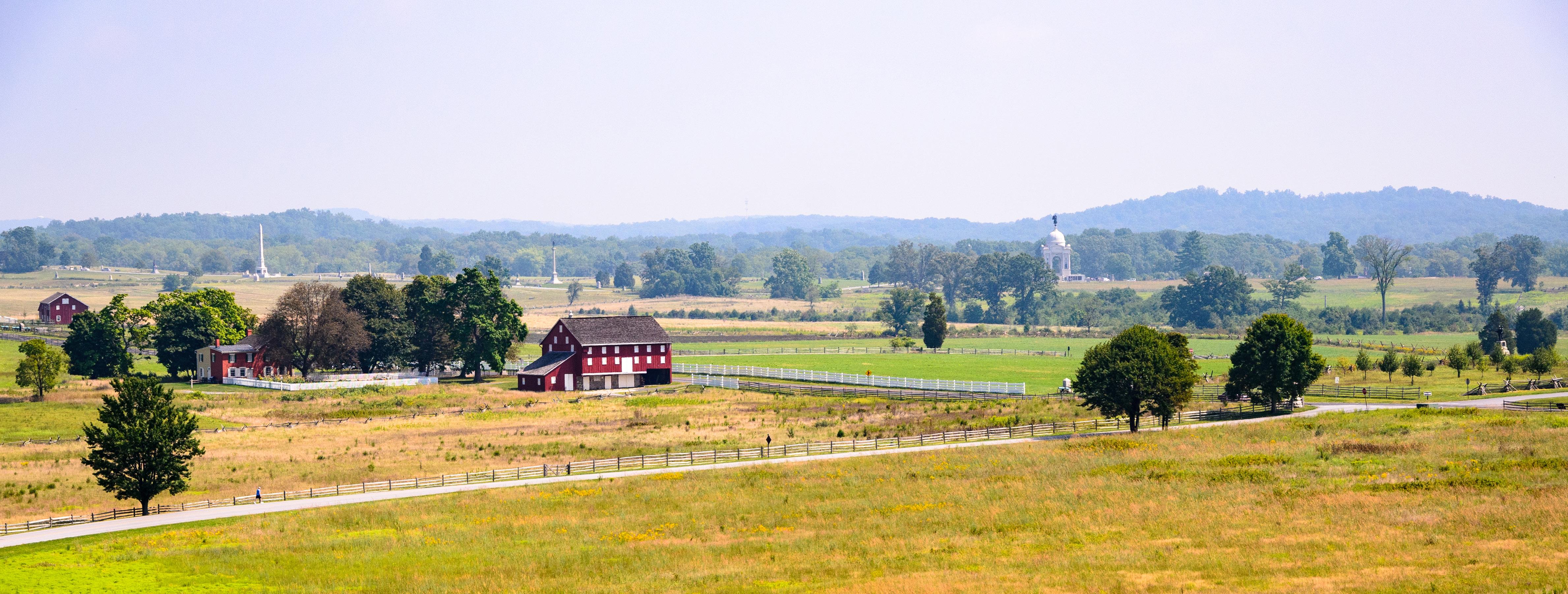
• Bostick, Douglas W. Charleston Under Siege: The Impregnable City: The History Press. 2010.
• Gillmore, Q. A. Engineer and Artillery Operations Against The Defenses Of Charleston Harbor: 1863: D. Van Nostrand. 1865
• OR, Series I, Volume 35, Part 2, page 284.
• Ed. Moore, Frank. The Rebellion Record: A Diary of American Events, Volume 8, page 2: D. Van Nostrand. 1865
REINFORCEMENTS MAKE ALL THE DIFFERENCE!!!
Nobody even comes close to building a Civil War tent with as much attention to reinforcing the stress areas as Panther. Our extra heavy duty reinforcing is just one of the added features that makes Panther tentage the best you can buy! PANTHER Catalog - $2 Web: www.pantherprimitives.com 160 pages of the best selection of historical reenactment items from Medieval era to Civil War era. Includes over 60 pages on our famous tents and a 4-color section.
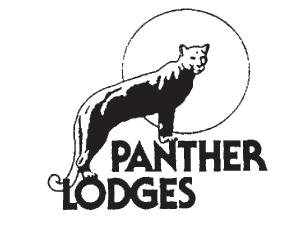
The Best Tents in History P.O. Box 32N Normantown WV 25267 (304) 462-7718 Digital Issues of CWN are available by subscription alone or with print plus CWN archives at CivilWarNews.com

24 CWN August 2020
devotion
Marsh Battery as of Oct. 12, 2017. This was the location of the
We take increased to the cause they gave the last
-President Abraham Lincoln Preservation. Stewardship. Education. ·Preservation of land, monuments and artifacts ·Operation of the world-class, LEED-Gold Certified Museum & Visitor Center ·Education about the relevance of Gettysburg today Maintaining our cultural resources for future generations. GettysburgFoundation.org | 866-889-1243
for which full measure of devotion
South Carolina Press. 1994.
Stephanie Hagiwara is the editor for Civil War in Color.com and Civil War in 3D.com. She also writes a column for History in Full Color. com that covers stories of photographs of historical interest from the 1850’s to the present. She also has had her work published in The Artilleryman Magazine. Her articles can be found on Facebook, Tumblr and Pinterest.
Your $2 cost is refundable with your first order. SEND for copy TODAY
Land Saved in Five States
Despite ongoing restrictions on visiting battlefield parks and other sites in many states, the American Battlefield Trust has continued to protect additional hallowed ground. Recent victory announcements included the protection of 31 acres from Revolutionary War battles in the Carolinas; 31 acres were added to the Liberty Trail at Hanging Rock, S.C., and a half-acre has already been transferred to the National Park Service at Guilford Court House National Military Park.
We also completed the final, critical step in protecting 12.44 critical acres, part of a larger, 200-acre acquisition project, along the Rappahannock River. This step paved the way for recreational water access at a potential new state park currently being evaluated by the Commonwealth of Virginia. In placing conservation easements on the property through the Virginia Outdoors Foundation (VOF) and Department of Historic Resources (DHR), the Trust ensured that this pristine landscape is protected in perpetuity. Critical funding for the full $1.8 million project was provided by the federal American Battlefield Protection Program and Commonwealth matching grants, from the Virginia Land Conservation Fund, Virginia Outdoors Foundation, and Virginia Battlefield Preservation Fund, as well as a landowner donation.
Further, we were able to simultaneously declare victory on a number of efforts related to battles fought during 1862. All told, we saved 101 acres across five properties on four battlefields: Shiloh (61 acres for a total of 1,378 acres cumulatively saved by the Trust), Glendale (nine new acres for a total of 726), South Mountain (18 new acres for a total of 703), and Fredericksburg (11 new acres for a total of 248) through a combination of private contributions, state and federal grants, and landowner donations. All are significant properties.
New Format for Teacher Institute
Amid ongoing access limitations at planned tour destinations,
the American Battlefield Trust made the difficult decision to transition its popular National Teacher Institute to an online format in 2020. A series of webinars and interactive sessions were held July 7-10, 2020. While in-person events are anticipated to return in future years, this first of its kind Virtual Teacher Institute had the capacity to accommodate more than twice as many educators in sessions geared to sharing the latest techniques in history education.

“As disappointing as it is not to be able to gather in person in Mobile, Ala., this summer, this was the best course of action, given the uncertainties we face during this time,” said Trust Chief Historian Garry Adelman.
“The work our teachers do matters tremendously, and the Trust prides itself on holding outstanding events for them. So, as we heard that tour sites and restaurants we planned to visit might not be accessible, and that our great presenters were facing difficulties in traveling, it became clear that we had to postpone, but not cancel, our visit to the Azalea City. We are already looking forward to our rescheduled event there in 2022.”
As always, registration was free of charge and those who attended four or more sessions were eligible to receive continuing education units, paid for by the Trust, through Virginia Tech. Refunds were issued for all registration deposits and recipients of scholarships to cover travel expenses will have that award applied to attendance at either the 2021 or 2022 events in Baltimore, Md., and Mobile, Ala., respectively.
Major Steps Made for Parkland Protection
On June 17, the U.S. Senate passed the “Great American Outdoors Act,” landmark legislation to benefit maintenance needs at existing public lands and secure the protection of additional landscapes. The measure now proceeds to the House of Representatives.
“The American Battlefield Trust wholeheartedly and enthusiastically supports the bipartisan Great American Outdoors Act,” said Trust President Jim Lighthizer. “This vital,
long-awaited legislation combines two priorities related to battlefield preservation. First, it fully and permanently funds the Land and Water Conservation Fund (LWCF), which in turn funds the Battlefield Land Acquisition Grant Program, a matching grant program that has successfully saved more than 32,000 acres of America’s hallowed Revolutionary War, War of 1812, and Civil War battlefields. Second, it tackles the critical maintenance backlog within our National Park System, including millions of dollars’ worth of projects at dozens of battlefield parks.”
The Great American Outdoors Act would authorize mandatory and full funding ($900 million) for LWCF in perpetuity by directing revenues to it from on-shore and off-shore energy development, both fossil and renewable energy operations, that are not already allocated by law to other programs. Further, the bill would allocate $9 billion over five years to address the deferred maintenance backlog experienced by federal agencies, including the National Park Service, the National Forest Service, the Bureau of Land Management, U.S. Fish and Wildlife Service, and the Bureau of Indian Affairs.
Explore Revolutionary Yorktown with Confidence
As visitors begin returning to historic sites this summer, travelers to the Yorktown Battlefield at Colonial National Historical Park have a new resource to explore that landscape at their own pace, on their own schedule. The new Yorktown Tour Guide app, developed by the Trust on behalf of the park, takes users on three distinct tours, the historic town, the battlefield, and the allied encampment,
with audio interpretation at each of the 21 stops. While the app is GPS-enabled, providing integrated driving directions to individual sites within its map feature, images and historical content can be accessed from anywhere on the globe, bringing history to those not yet able to visit in person. The free app is now available for download via the App Store and Google Play, or online as a web app, available through any web browser. Visit www.battlefields. org/yorktownapp for all options.
“We are thrilled to launch this new option for visitors to the Yorktown Battlefield and expand our array of interpretive resources,” said Kym Hall, superintendent of Colonial National Historical Park. “From ranger-led programs to physical pamphlets and now into the digital realm, the National Park Service strives to help each visitor find their preferred way to explore our historic resources. Working with likeminded partners, including the American Battlefield Trust helps us fulfill this mission.”
American Battlefield Trust Chief Digital Officer Larry Swiader emphasized that the beauty of an approach like this app is that it can function for those on the battlefield, as well as those learning history from home.

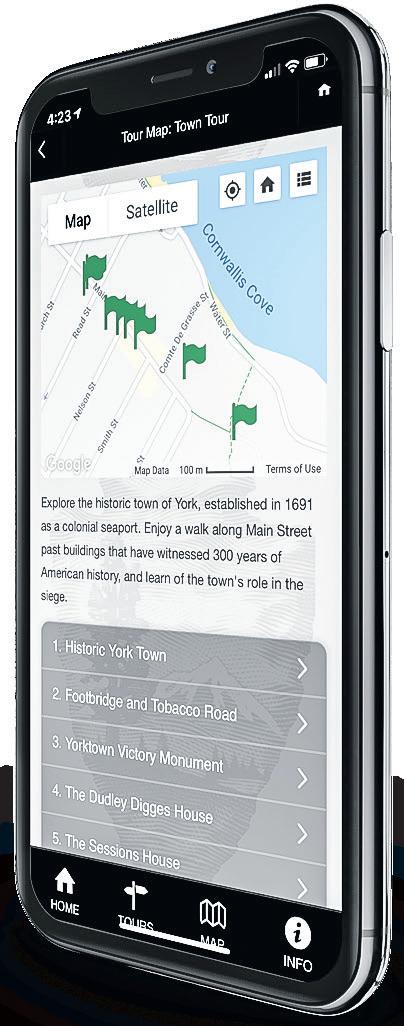
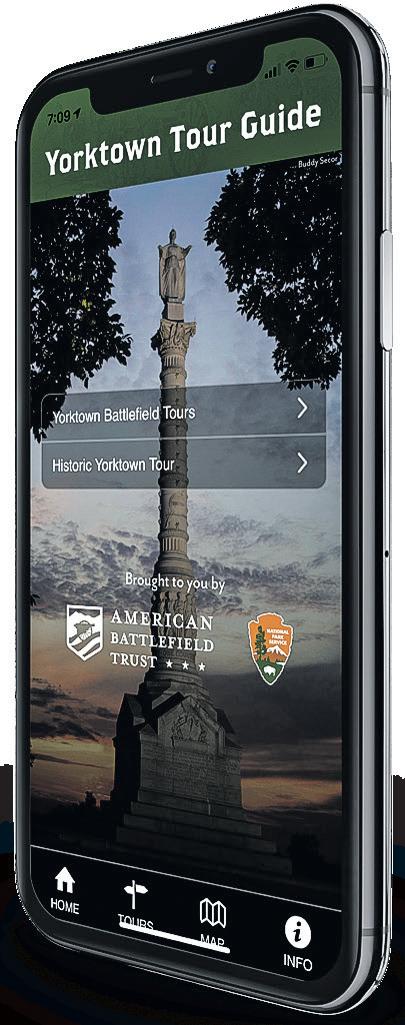
“With photos and audio content, as well as place-based functionality, the Yorktown Tour Guide can bring history to life whenever and wherever you are when you want a peak into the past. It really is like having a tour guide in your pocket,” he said.
The Trust is no stranger to digital battlefield interpretation, having launched its first Battle App® guide in 2010. All 19 titles that have been introduced in that series feature Civil War battles and campaigns, reflecting the organization’s origins focused exclusively on that conflict. The Yorktown Tour Guide, the Trust’s first foray into the Revolutionary War using this medium, will certainly not be its last, particularly as the nation prepares to mark the 250th anniversary of its independence in 2026. Learn more about the entire suite of Trust mobile apps at www.battlefields.org/ mobileapps.

25 August 2020 CWN The Artilleryman Magazine is a quarterly magazine for enthusiasts who collect and shoot cannons from Rev War to World War II. $34.95/ year. Historical Publications LLC, 520 Folly Rd. Suite 25 PMB 379 Charleston, SC 29412 800-777-1862 www.ArtillerymanMagazine.com
Yorktown app screen shots.
The Graphic War highlights prints and printmakers from the Civil War discussing their meaning and most importantly, the print maker or artist’s goals.



For years before the Civil War, the firm of Currier and Ives produced small folio lithographs either entitled “In Memoriam,” or “Sacred to the




Memory.” The market for these was families mourning the loss of loved ones. Families looking for some physical, visual reminder of their deceased could purchase for little money, a reminder that hung on the wall. Undoubtedly, more versions of this print will come to light; to date more than 20 different iterations printed before the war have been identified.1
In 1862, 1863, and then in 1865, with the ravages of Civil War touching nearly every household in the country, Currier responded to the national tragedy and the market, and re-introduced the same prints with the new titles: “The Soldier’s Memorial” in one version, or “The Soldier’s Grave” in two versions. They were essentially identical;
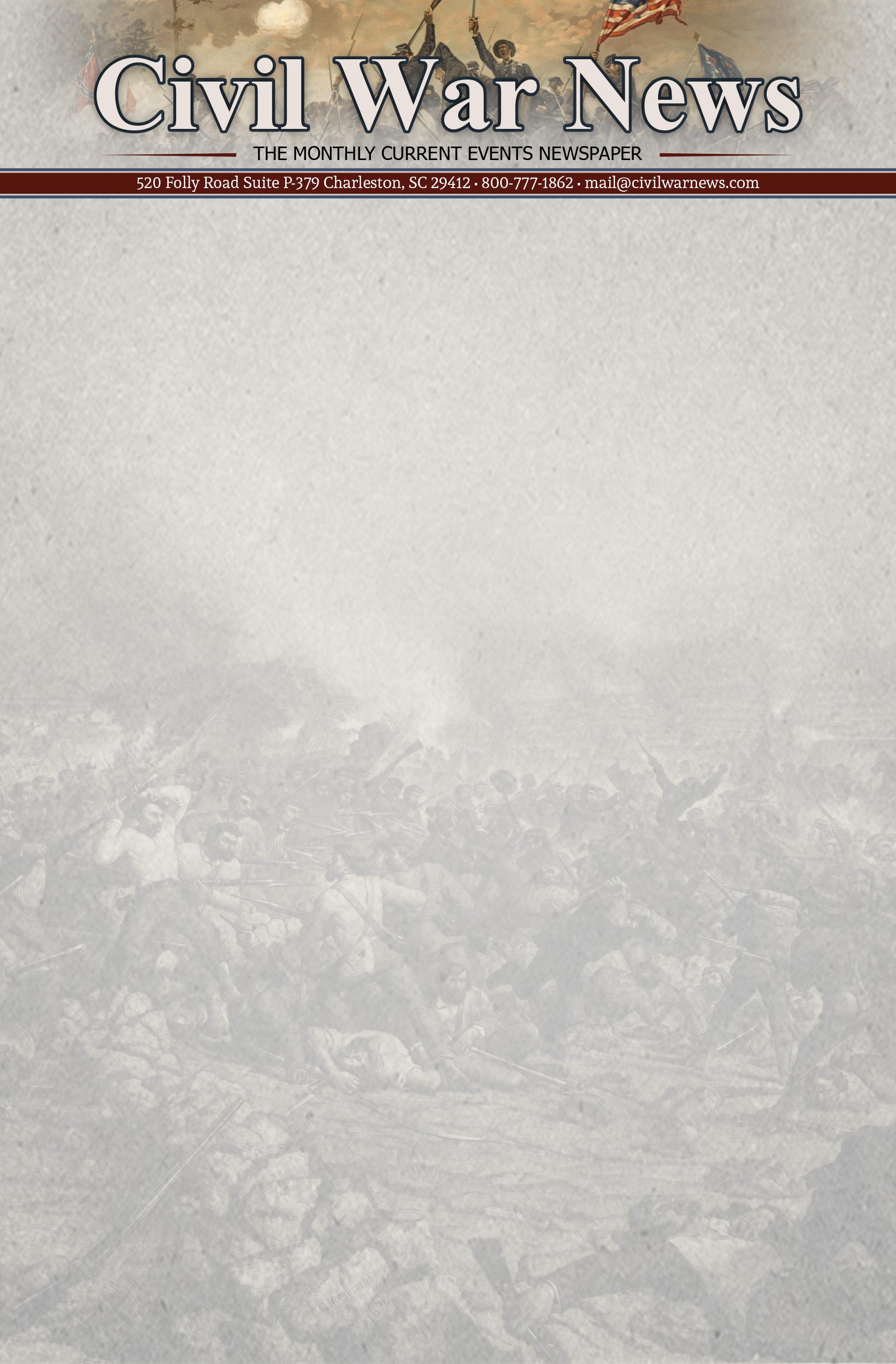
vertical rather than horizontal, usually with a lone mourner, who was almost always a woman, but sometimes a small family, mourning the family member in the frame. She and they, are dressed in black; she has buried her face in her handkerchief. The center of the print featured a monument topped by an American eagle with a wreath in his mouth, cannon, cannon balls, and flags. In some versions, an urn replaced the eagle. To either side of the white memorial monument are stacked arms and drums. In the background are surviving soldiers marching into the distance. Above the monument, topping it off are either weeping willows or, as it appears in some extant, presumably Southern oriented examples, Spanish moss dangling from the trees.

Much like other prints, such as family, birth, death, and wedding registers, Currier, and to a lesser degree, his competitors, produced mourning prints that were meant to be written on. Currier provided the template; the family filled in the particulars: “In Memory of ____of the (regiment) Who Died at ____186_. A Brave and Gallant soldier and a True Patriot. His Toils Are Past, His work Is Done;/And He Is fully Blest:/He Fought the Fight, the Victory Won./ And Enters into Rest.”2
Once filled in, the “death record” undoubtedly received a conspicuous place of honor in the home. Drew Galpin Faust, who wrote the essential This Republic of Suffering: Death


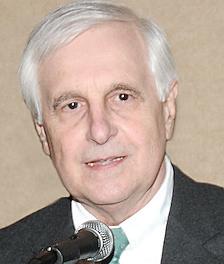
and the American Civil War, furthered our understanding of the Civil War’s tragedy and death on the large scale experienced by the American public. Summed up, she wrote of the war’s impact on dying, killing, burying, naming, realizing, believing and doubting, accounting and numbering. These were not stages of grief, but new realities unfaced by prior generations. She writes compellingly about the mystery of the war’s deaths since “nearly half the dead remained unknown, the fact of their deaths supposed but undocumented, the circumstances of their passage from life entirely unrecorded.” The Currier mourning print served a double meaning for those whose loved ones rested in unmarked graves. As Faust writes, “The Soldier’s Grave” lithograph with its inscribed details offered the family who “had no actual grave to mark, … a substitute.”3 These rapidly drawn and crudely produced prints have appeal to print collectors; but they have a more significant use as important genealogical documents establishing a soldier’s service in the Northern war effort.



Endnotes:
1. Gale Research Company, Currier & Ives: A Catalogue Raisonné. Detroit, Gale Research Company, 1984, 2 Vols. I, 346-347. Harry Peters. Currier & Ives. New York: Doubleday & Co., 1931, 2 Vols., I, 216.
26 CWN August 2020 In Memoriam Historical Publications, LLC Civil War News • 800-777-1862 520 Folly Road, Suite 25 PMB 379 Charleston, SC 29412 www.CIVILWARNEWS.com UP-TO-DATE COVERAGE • PRESERVATION NEWS • BOOK REVIEWS SHOWS, LIVING HISTORY AND REENACTMENTS • HISTORICAL ARTICLES MONTHLY COLUMNS • CALENDAR OF EVENTS STAY INFORMED! Only $38.50/One Year • $66.00/ Two Years THE MONTHLY CURRENT EVENTS NEWSPAPER -FORCIVIL WAR ENTHUSIASTS SINCE 1974 12 ISSUES PER YEAR PRINT & DIGITAL EDITIONS AVAILABLE CALL OR SUBSCRIBE ONLINE TODAY! 2018 CW N 44, $3.50 America’s Monthly Newspaper For War Enthusiasts our have acres states! County, Friends Mountain Civil War Trust’s Path to Preservation CW N 44, No. Pages, Civil War News America’s Newspaper War Enthusiasts Holzer Dancing Inside this Smoke people visit and town industrypeople spirits. mightthen departedplace eating 1863. 1797, McClellan’s ghosts nursed woundedballroom. GettysburgRemembrancePenn., Mo., beenRemembrance the featuresmeant slight meantime, please ball. Dancing the Night Away at the Gettysburg Hotel Poretsky he Lincoln Scholar Harold Holzer’s Oration at the 154th Anniversary of the Gettysburg Address Gettysburg spot—in Abraham one;one clutchingliftingAmerican becauseDouglass history,” hadduring men read great today, been politically some, kneeling believeDespiteroiling country.remember Gettysburg mightgallery,values, elevated let’s secessionconsideredequal—remained reckoning have Today,speech own, other statues Ball held INSIDE EVERY ISSUE
“The Soldier’s Memorial.” New York: Published by Currier & Ives,
ca. 1863. Library of Congress.
2. Gale, II, 621.




3. Drew Galpin Faust, This Republic of Suffering: Death and the American Civil War, New York, Alfred A. Knopf, 2008, , 267, 231.


After 43 years in the museum field, Salvatore Cilella devotes his time collecting American prints and maps and writing. His last professional position was President and CEO of the Atlanta History Center. His most recent books are Upton’s Regulars: A History of the 121st New York Volunteers in the Civil War (U. Press Kansas, 2009). His two-volume Correspondence of Major General Emory Upton, (U. of Tennessee Press, 2017), is the recipient of the 2017-2018 American Civil War Museum’s Founders Award for outstanding editing of primary source materials. His latest book Till Death Do Us Part, is an edit of Upton’s letters to his wife 1868–70, published this spring by the Oklahoma University Press.

27 August 2020 CWN Want To Advertise In Civil War News? Email us at: ads@civilwarnews.com “The Soldier’s Grave.” New York: Published by Currier & Ives, 152 Nassau St. New York, [1865]. Library of Congress.
THE FINEST HISTORICAL ANTIQUE MILITARIA Wallace Markert info@csacquisitions.com 16905 Nash Road • Dewitt, Virginia 23840 804-536-6413 • 804-469-7362 www.csacquisitions.com e Artilleryman is a quarterly magazine founded in 1979 for enthusiasts who collect and shoot cannons and mortars primarily from the Revolutionary War, Civil War to World War II. Now expanded and fully illustrated in rich color throughout the entire magazine. 520 Folly Road, Suite 25 PMB 379, Charleston, SC 29412 • 800-777-1862 • mail@artillerymanmagazine.com www.ArtillerymanMagazine.com The Artilleryman Magazine FOUR INCREDIBLE ISSUES A YEAR
Merrill Altered Virginia Manufactory Rifles
By an act of the Virginia legislature, the Virginia Manufactory of Arms was established in 1797. The goal of this armory, located along the James River in Richmond, was to supply the Virginia militia with arms required for the defending the Commonwealth. Over a roughly two-decade period, from 1802 through 1821, the Virginia Manufactory produced a variety of small arms, including some 58,000 flintlock muskets, 4,000 flintlock pistols, 2,000 flintlock rifles, and some 10,000 sabers. The facility also produced about 300 cannon during this period. Although the facility was shut down circa 1821, primarily because arms were now forthcoming from the U.S. government under the Militia Act of 1808, it
was resurrected during the Civil War period as the Richmond Manufactory.

In the interim the facility served as an arsenal, a storage facility, rather than an armory or manufactory. In 1860, with the clouds of war looming, the Commonwealth of Virginia decided to return the facility to its prior manufacturing status. To perform this task former Harpers Ferry Master Armorer James Burton was hired to set up the facility. Burton had just returned from overseeing the set-up of the British Royal Small Arms Factory (RSAF) at Enfield Lock, Great Britain’s version of “Springfield Armory” and was undertaking to receive the necessary machinery to manufacture rifle muskets in Richmond when the Civil War erupted.
The reestablishment of the Virginia Manufactory as the new Richmond Arsenal was not the only action that the Virginia
government took to prepare for war. In addition to trying to acquire small arms from as many vendors as possible during the year leading up to the firing on Fort Sumter, a major program of improvement was undertaken to alter existing flintlock firearms to percussion. This had actually been going on somewhat aggressively since about 1857, when the Commonwealth started to turn in as many flintlock muskets as allowed to have them replaced with percussion altered muskets by the Federal Government under the Militia Act of 1808. The Commonwealth had also contracted with some private vendors like Merrill, Thomas & Company to alter existing stocks of arms to percussion, primarily Virginia Manufactory arms that were in store prior to the war.
Once the war broke out the Commonwealth relied on additional contractors to continue the percussion alteration program. The primary contractors were Thomas J. Adams of Richmond, J.B., and A.B. Barrett & Company, William Morgan, F. Persignon, S.C. Robinson, and the Union Manufacturing Company. Three smaller contractors also did alterations for the Commonwealth on a much more limited basis, including J.H. Wells, J.D. Brown, and S. Holbrook. While the majority of this work was performed on flintlock muskets, many remaining stocks of flintlock Virginia Manufactory rifles and pistols were altered to percussion as well.
During 1803, the Virginia Manufactory had produced its first flintlock rifles. These “First Model” or “Type I” rifles largely followed the pattern of the “Kentucky” or “Pennsylvania” rifles then in common use on the frontier. They were nominally .50 rifles with octagonal barrels that were initially 46 inches in length but were changed to 43 inches in 1806. The guns were 62 inches overall length (1803–1805) and then 58 ½ inches overall after 1805. They were full stock, did not accept a bayonet, and were brass mounted during early production, but were changed to iron
mounted during 1806. The most notable visual feature of these early rifles was a large, four-piece patchbox in the obverse buttstock that terminated in a large coiled snake-motif hinge plate. The Virginia Manufactory produced only 333 of these very scarce “snake patchbox” rifles, and then only from 1803 through 1809.
The production of “Second Model” or “Type II” Virginia Manufactory Rifles began circa 1810–1811, but no rifles were completed until 1812. These later rifles were very similar to the earlier “Type I” guns, but came in .45 caliber, with a nominally 39 inches (38 13/16 inch) octagonal barrel and an overall length of 55 inches. The barrel was secured with three keys plus a screw through the breech plug tang. Like the preceding rifle, it was a flintlock muzzleloader, and like the earliest “Type I” rifles, was brass mounted. Again, the design incorporated a fulllength stock with no provision for a bayonet as U.S. tactical doctrine of the period saw the rifle as a specialty weapon, not generally equipped with bayonets. Instead of the “Snake Patchbox,” a more conventionally shaped four-piece brass patchbox was incorporated in the obverse buttstock. Between 1812 and 1821, a total of 1,760 Second Model Virginia Manufactory rifles were produced, bringing the Virginia Manufactory’s total rifle production to 2,093.
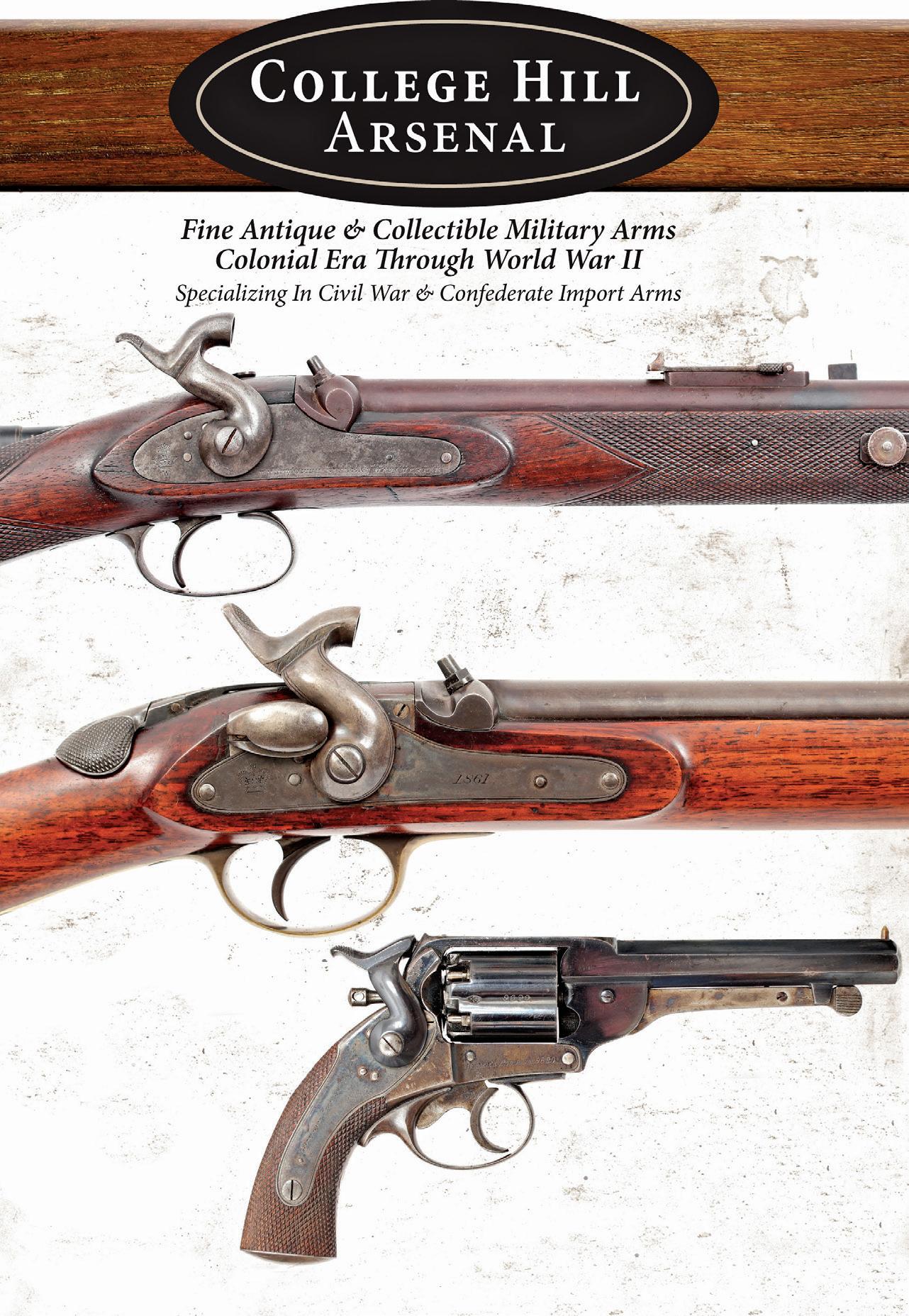
Between 1809 and 1815, the Commonwealth also purchased some contract rifles, and did so again in 1819. These contract rifles were quite similar to the current production Second Model rifles, and a total of 2,145 were acquired. Thus, the Commonwealth of Virginia manufactured or purchased a total of 4,238 flintlock rifles between 1803 and 1821. According to George Moller’s research, between 1,000 and 1,500 of these flintlock rifles were still in storage at various locations throughout the Commonwealth in 1860.
During the fall of 1858 and spring of 1859, one of the largest pre-war operations to alter Virginia Manufactory rifles from flint to percussion was undertaken. During that period some 600 Virginia Manufactory rifles were forwarded to the Washington Arsenal to be altered, but only 32 were modified. The balance of the rifles was then shipped to Harpers Ferry, where in early 1859, hammers and jigs were produced to perform the alterations. The remaining guns were altered and then returned to the Richmond Arsenal.

The cost of the work by the



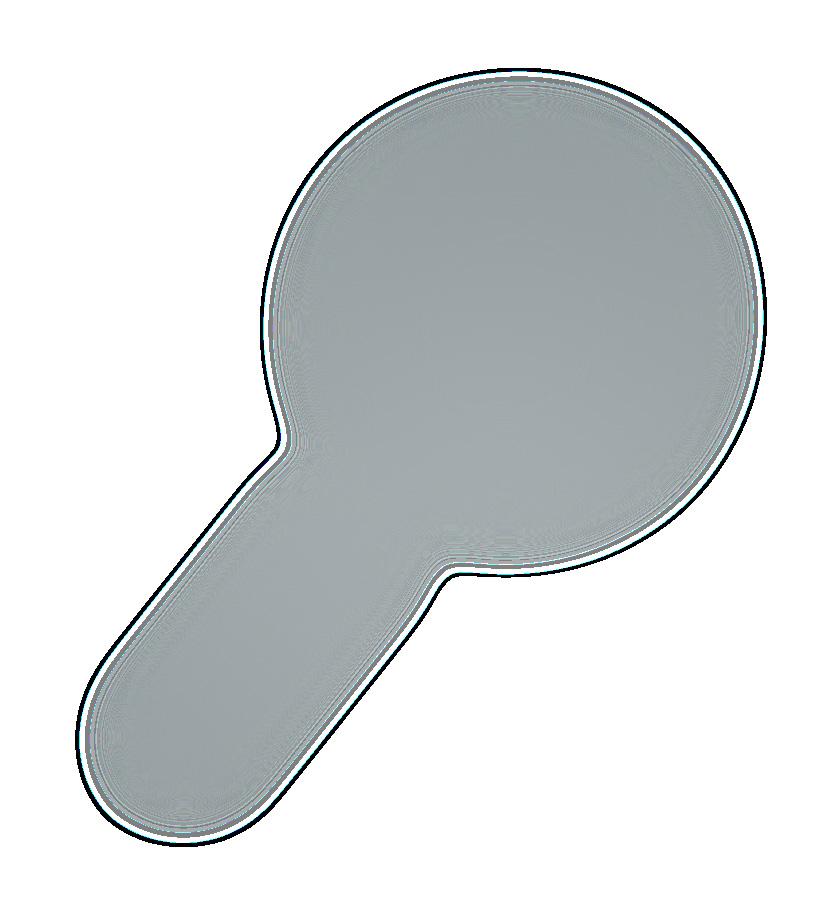

U.S. Ordnance Department was charged against Virginia’s annual arms allotment under the Militia Act of 1808; the effective “cost” equated to a deduction of some 44 muskets from the Commonwealth’s yearly issue. As a result of the October 16, 1859, John Brown Raid on Harpers Ferry nearly all the converted rifles were issued to the Virginia Militia. The raid likely induced the Commonwealth to look for other potential locations to have their remaining stock of flintlock rifles altered. One company the Commonwealth turned to was Merrill, Thomas & Company of Baltimore.
Merrill, Thomas & Company had formerly been the firm of Merrill, Latrobe & Thomas that had manufactured the Merrill, Latrobe & Thomas breechloading carbine for the U.S. military circa 1855 and would go on to manufacture Merrill breechloading carbines and rifles for the Union. The firm agreed to undertake the alteration process at a cost of $2 per rifle, plus shipping and packing costs. Between 250 and 360 rifles were forwarded to Merrill in Baltimore for alteration in early 1861; one group of guns consisting of 172 rifles, was returned April 17, 1861; less than a week after the firing on Fort Sumter. The work is distinctly identifiable as Merrill’s, as the percussion bolster and hammer both have the same profile found on Merrill patent carbines and rifles. The oblong, angled bolster included a clean out screw and was brazed over the original flintlock vent hole. The external flintlock battery was removed, and the associated lock holes filled. A percussion hammer of Merrill’s design was added to the tumbler, and the percussion alteration process was complete. An additional feature of the Merrill-altered rifles was that the barrels were cut back slightly from their original 39 inch length to between 36 inches and 36 ½ inches. A number was then stamped on the face of the muzzle, which is believed to be an alteration inventory number, to keep track of the number of guns altered and to be billed for.
According to research presented in Confederate Rifles and Muskets by Dr. John D. Murphy and Howard M. Madaus, at least 270 Merrill-altered Virginia Manufactory rifles can be documented as being issued between April 1, 1861, and June 13, 1861. The issues of the guns are as follows:
“50 Virginia Altered Rifles to Captain W.W. Cogbill, Chesterfield” this is believed to be W.T. Cogbill of the “Chesterfield Central Guards,” who would go
28 CWN August 2020 www.CollegeHillArsenal.com Tim Prince College Hill Arsenal PO Box 178204 Nashville, TN 37217 615-972-2418
on to be Company D of the 14th Virginia Infantry.
“60 Altered Virginia Rifles to Captain S.S. Williams, Woodstock.” This appears to be Samuel C. Williams of the “Brooklyn Grays,” who would go on to be Company F of the 10th Virginia Infantry.
“100 Virginia Altered Percussion Rifles to M.J. Harman, Staunton.” This appears to be Quartermaster M.G. Harman of Staunton, who subsequently issued the weapons to the regiment being assembled by Colonel George A. Porterfield, that would become the 25th Virginia Infantry.
“10 Virginia Percussion Rifles to Captain J.W. Timberlake, Greenwood Depot.” These guns went to the “Albemarle Rangers.”
“12 Virginia Percussion Lock rifles to Captain Thomas G. Pollock” for issue to the “Wise Skirmishers.” Captain Pollock was a company commander in the 46th Virginia Infantry, who would later go on to serve on the staff of General Kemper and be killed at Gettysburg.
It is likely that some guns listed above that Murphy & Madaus believe were Merrill-altered rifles were actually from the first batch of rifles altered at Harpers Ferry. As the first issues of the percussion altered rifles they list occurred on April 1, 1861, slightly more than two weeks before the first Merrill-altered guns were returned; those rifles had to be Harpers Ferry alterations.
Other issues of “Virginia Rifles” are noted, but their references make it impossible to determine if the guns were percussion altered or remained in their original flintlock configuration. Using George Moller’s research as a point of reference, when the war broke out, approximately 700 to 1,200 Virginia rifles remained in store in their flintlock configuration after deducting the Merrill and Harpers Ferry altered rifles from his 1860 figure. Many of these guns were subsequently altered to percussion by Virginia
based contractors, like those listed earlier in this discussion.
The Merrill-altered 2nd Model Virginia Manufactory rifle pictured in this article conforms in all ways to the handful of known examples that survive today. The rifle has the expected Merrill pattern hammer and bolster, and the barrel has been shortened from a nominal 39 inches to 36 ¼ inches. The face of the muzzle is numbered 44. Interestingly, the only Merrill-altered Virginia Manufactory rifle available for the Murphy & Madaus study was #46, only two numbers away from this example. The original Virginia Manufactory markings remain on the lock, including a large VIRGINIA under the bolster and RICHMOND / 1820 in a two-line vertical arc behind the hammer.
The rifle has an additional mark, a carved E WATSON (or possibly “G” WATSON) in the belly of the stock, behind the triggerguard. An examination of Confederate enlistment rolls show both an “E Watson” and a “G Watson” served in the 46th Virginia Infantry, a regiment that was issued 12 Merrill-altered Virginia rifles via Captain Pollock. The regiment used these guns for a small group of skirmishers.
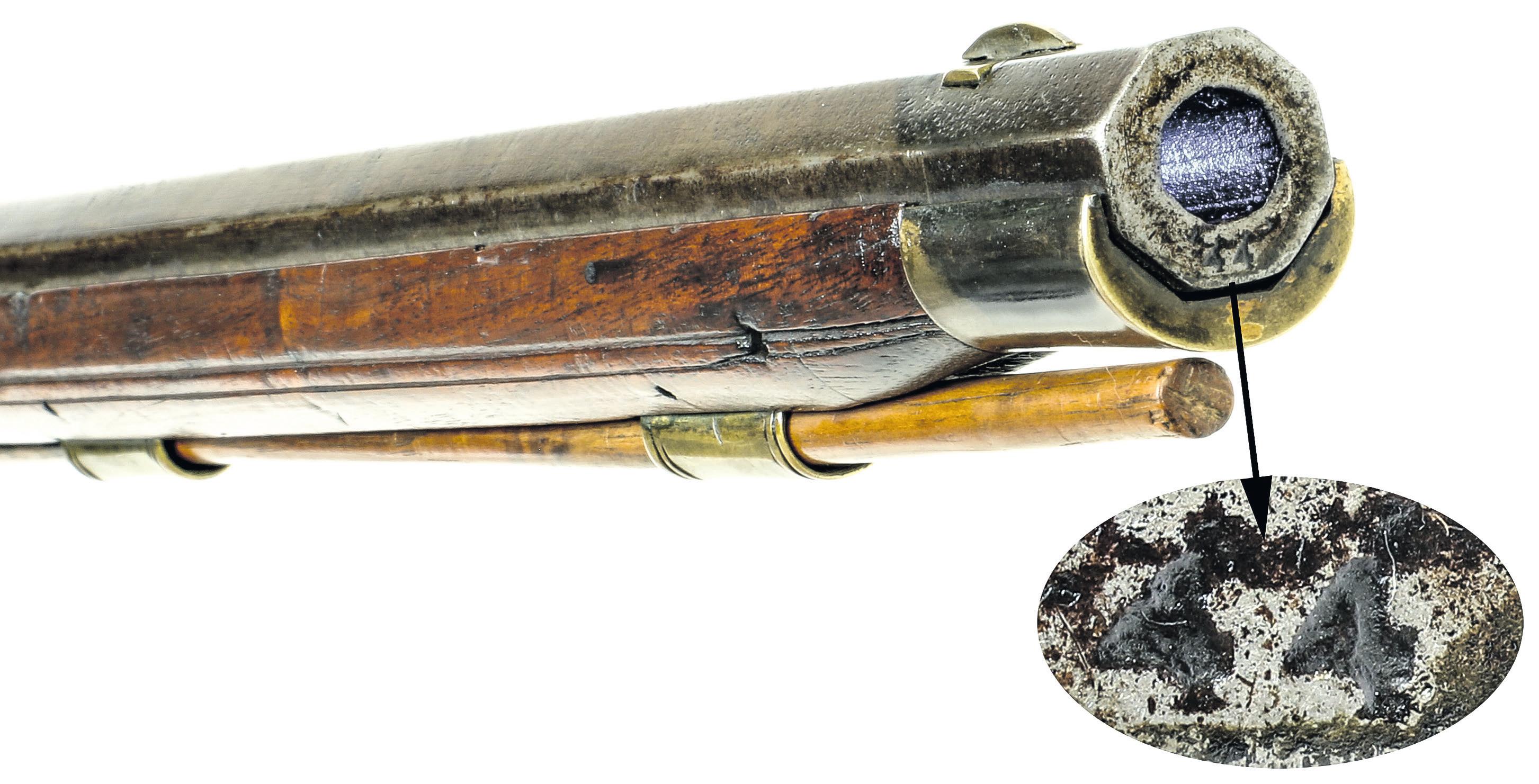

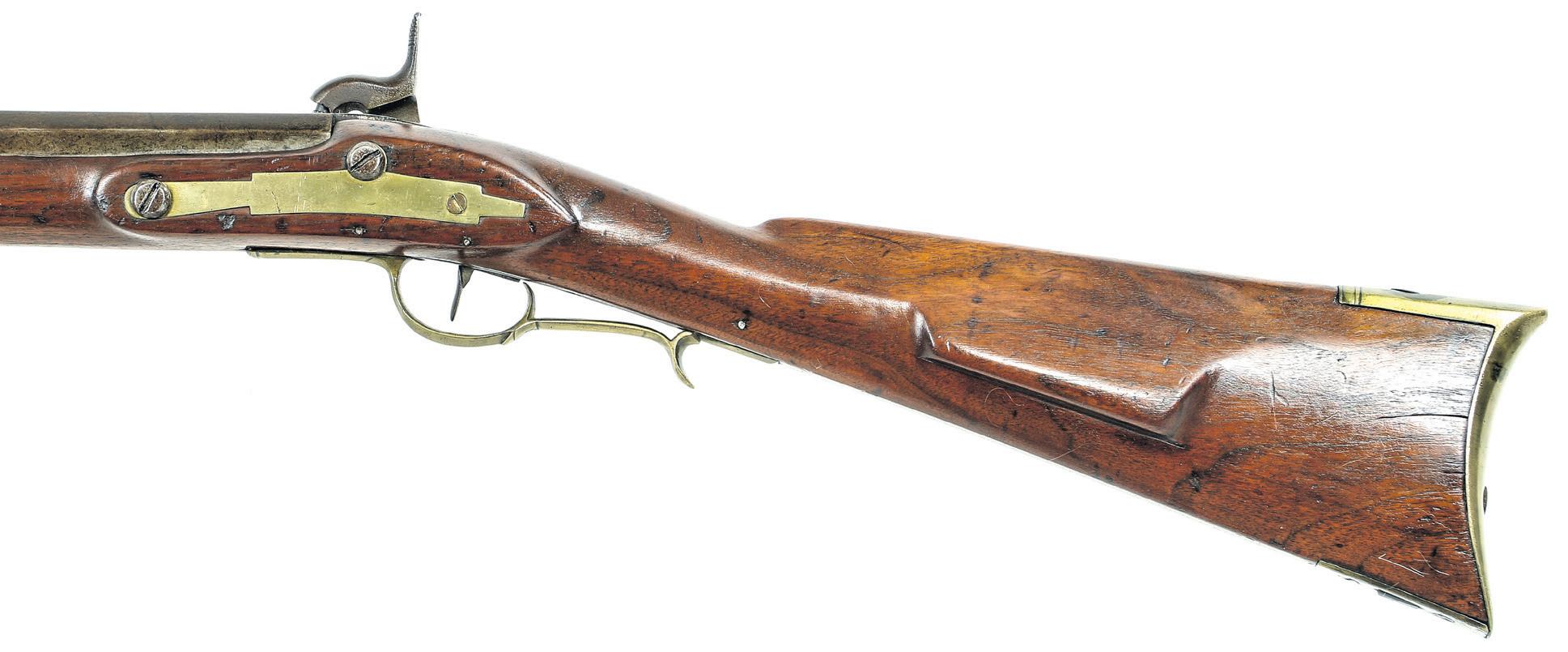



Other than the replacement wooden ramrod and some restoration of the last couple of inches of the forend, the gun pictured in this article remains in the original configuration that saw use in the Civil War.
Tim Prince is a full-time dealer in fine & collectible military arms from the Colonial Period through WWII. He operates College Hill Arsenal, a web-based antique arms retail site. A long time collector & researcher, Tim has been a contributing author to two major book projects about Civil War era arms including The English Connection and a new book on southern retailer marked and Confederate used shotguns. Tim is also a featured Arms & Militaria appraiser on the PBS Series Antiques Roadshow.
29 August 2020 CWN
Overall view of Merrill-altered 2nd Model Virginia Manufactory rifle. Photos by Tim Prince.
Close up of the patchbox and lock area of the Merrill-altered 2nd Model Virginia Manufactory rifle.
Close up of the lock area of a Merrill-altered Virginia Manufactory 2nd Model rifle, showing the distinctive Merrill bolster and hammer.
Detail of the cheek rest and counterpane of a Merrillaltered 2nd Model Virginia Manufactory rifle.
Close up of the name stamped behind the triggerguard of the Merrill-altered 2nd Model Virginia Manufactory rifle, linking this rifle to the 46th Virginia Infantry, a unit that was issued 12 percussion altered “Virginia Rifles.”
Detail of the muzzle area of the Merrill-altered 2nd Model Virginia Manufactory rifle showing the Merrill conversion inventory number “44.”
The most popular Civil War publications among respondents are:
1. Civil War Times (55%)
2. Civil War Monitor (48%)
3. America’s Civil War (39%)
4. Civil War News (36%)
5. North & South (24%)
6. Blue & Gray (22%)
Those publications that received no votes:
• American Digger
• The Avalon Hill General
• Cavalry Times
• Charge!
• De Bow’s Review
• History
• Southern Bivouac
• Taps
• United States Service
• Western & Eastern Treasures
Another 20% responded as Other. Their comments are as follows:
• Hallowed Ground
• The Blue Light
• Military Images
• Civil War Regiments
• Some of these are not in business anymore and some I gave up my subscription. My favorite was Blue & Gray. I also subscribed at times to North South Trader’s Civil War, CWTI, America’s Civil War, Confederate Veteran and Gettysburg Magazine.
• Hallowed Ground
• Military Images
• Confederate Veteran, The Bugle, Telegraph (The Confederate Voice of Australia)
• Homefront Herald
• Civil War History, Journal of the Civil War Era
• Civil War History
• Hallowed Ground
• American Battlefield Trust
• ABT magazine Hallowed Ground
• Civil War Gazette
• Military Images
• Civil War History, Journal of the Civil War Era
• Hallowed Ground
• Military Images
• Battlefield Photographer, Military Images, Archaeology
• Military Images
• Military Images
• Missouri Historical Review
• Hallowed Ground
• Military Images
Q4: What percentage of your publications actually get read?
Interestingly, 95% of respondents say the most enjoyable parts of their publications are the stories and articles and 75% say the book reviews are the most enjoyable. Obviously, these are readers from the very start.
What is nearly as telling; 1% said “How to do something”, 4% chose information and questions on social media and 5% selected tour companies.
Another 4% responded with “Other” which included:
• Biographies
• All contents
• Maps
• Artifacts
• Original articles about fresh topics—not the same old thing
• Collecting Civil War artifacts
Q6: Which three magazines do you rate the highest?
Answered: 107 Skipped: 88
These responses are very interesting because the top 7 rated publications are as follows:
• America’s Civil War
• Blue & Gray
• Civil War Monitor
• Civil War Times
• American History
• The Artilleryman
• The Avalon Hill General
The bottom 7 rated publications include the following:
• West Point
• Western & Eastern Treasures
• United States Service
• Taps
• Southern Partisan
• Southern Bivouac
What is astounding about these results is that while no one actually subscribes to the Avalon Hill General, it scores relatively high. And, while one person does subscribe to West Point, it is still at the bottom of the list.
Q7: Of those to which your DO NOT subscribe, which publications might you be interested in?
86 Skipped: 109
On average, 84% of respondents stated that they actually read their publications.
Q5: What are the most enjoyable part(s) to your favorite publication(s)?
30 CWN August 2020
Average Number Responses 84% 120 Total Respondents: 120
Answer Choices Responses Respondents Stories/Articles 95.90% 117 Advertisements 10.66% 13 Info/Questions for social media 4.10% 5 Self-guided tour ideas 29.51% 36 Tour companies 5.74% 7 Future events 21.31% 26 Ideas for my CWRT 17.21% 21 Ideas for new research 17.21% 21 Book Reviews 75.41% 92 Editorials 23.77% 29 Photographs 49.18% 60 Letters to the Editor 31.97% 39 Quizzes (Trivia) 12.30% 15 How to do something 1.64% 2 Other (please specify) 4.92% 6 Total Respondents: 122
Answered:
Answer Choices: Responses: Respondents: America’s Civil War 17.44% 15 American Digger 4.65% 4 American History 10.47% 9 The Artilleryman 10.47% 9 The Avalon Hill General 6.98% 6 Blue & Gray 31.40% 27 Cavalry Times 10.47% 9 Charge 0.00% 0 Civil War Courier 8.14% 7 Civil War from A to Z 8.14% 7 Civil War Monitor 6.98% 6 Civil War Navy 10.47% 9 Civil War News 10.47% 9 Civil War Quarterly 22.09% 19 Civil War Times 16.28% 14 Confederate Veteran 6.98% 6 De Bow’s Review 0.00% 0 Frank Leslie’s Illustrated News 5.81% 5 The Gettysburg 11.63% 10 Harper’s Weekly 2.33% 2 History 1.16% 1 Leatherneck 0.00% 0 Military Heritage 3.49% 3 Military History 15.12% 13 Muzzleloading Artilleryman 4.65% 4 Naval History 4.65% 4 North & South 24.42% 21 North South Trader’s Civil War 6.98% 6 On Point: Journal of Army History 2.33% 2 Shipmate 3.49% 3 Smithsonian 3.49% 3 Southern Bivouac 0.00% 0 Southern History Society Papers 11.63% 10 Southern Partisan 0.00% 0 Taps 0.00% 0 H
. . . . . . . . . . . from page 1
Survey
Total Respondents: 86
Essentially, this question asked about the name recognition of unsubscribed Civil War publications. Those that scored the best were:
• Blue & Gray
• North & South
• Civil War Quarterly


• America’s Civil War
Those unsubscribed publications that will remain unsubscribed by these 120 respondents include:
• Charge!
• De Bow’s Review
• Leatherneck
• Southern Bivouac
• Southern Partisan
• Taps
• United States Service
• Western & Eastern Treasures
Q9: How do you share your publications? Answer
NEW DIGITAL MAGAZINES:
Digital subscriptions for back issues of Civil War News (Archive 2012 to current issue are available now) and The Artilleryman magazine from Vol. 1, No. 1 to the current issue, will be available soon. The first twenty years of the publication and every issue from Summer 2015 to present, are now available as an online, yearly digital subscription. Over 6,500 pages of artillery information available on your phone, tablet, or computer. By the end of Summer 2020, this project will be entirely up to date, with over 160 issues.
Other (please specify)
Total Respondents: 63
Sharing is a value of many CWRT members. What is interesting is that most will seek out a friend, give it to their CWRT and a fundraiser (including meeting sales and annual auctions) or give to a family member.
The least likely to receive a shared Civil War publication include:
• Take them to a school
• Give to library
Another 19% responded “Other” and said:
• Take to VA hospital
• Copy articles and send to friends
• Lend to a friend
• Share with ACWRTA (QLD) round table
• Round table book raffle
• Free to CWRT members & guests

• Put out on table at RT meetings free for the taking
For more information about Civil War Round Table Congress visit www.cwrtcongress.org.

If you are a student of the Civil War, artillery, a historian, researcher, author, or just interested in the hobby, you’ll find plenty of information within this massive archive.


To Subscribe Visit: CivilWarNews.com or ArtillerymanMagazine.com
Back Issues:
To purchase back issues of The Artilleryman magazine please visit our website at www.historicalpubs.com
100 Significant
Civil
War
Photographs: Atlanta Campaign collection of George Barnard’s camera work. Most of the photographs are from Barnard’s time in Atlanta, mid-September to mid-November 1864, during the Federal occupation of the city. With this volume, Stephen Davis advances the scholarly literature of Barnardiana.
$19.95 + $3.50 shipping 128 pages, photographs, maps, bibliography. $19.95 + $3.50 shipping. Softbound. ISBN: 978-1-61850-151-6. www.HistoricalPubs.com. Order online at www.HistoricalPubs.com or call 800-777-1862
31 August 2020 CWN Digital Issues of CWN are available by subscription alone or with print plus CWN archives at CivilWarNews.com
CivilWarShop.com Established 1981 Buy – Sell – Trade Certified Appraisal Services Life Member, Company of Military Historians International Society of Appraisers Life Member, NC Division, SCV Federal Firearms Licensed Dealer 3910 US Hwy. 70 East • New Bern, NC 28560 (252) 636-3039 • civilwarshop@gmail.com Want To Advertise In Civil War News? Email us at ads@ civilwarnews.com or Call 800-777-1862. For a rate sheet visit: www.civilwarnews.com Publishers: Please send your book(s) for review to: Civil War News 520 Folly Road, Suite 25 PMB 379 Charleston, SC 29412 All Hands on Deck! Support Our Mission to Bring You the Naval History “This is the magazine for all things Civil War Navy. From ‘Uncle Sam’s web-feet’ to the ‘grey jacket navy’ raised by Jeff Davis! It is all here thoroughly researched and illustrated by beautiful contemporary navy images.” Ron Field, military historian and author of over 45 books, including Bluejackets: Uniforms of the United States Navy in the Civil War Period, 1852-1865. 1 Year—4 Issues: $37.95 Subscribe Now at civilwarnavy.com Or send a check to: CSA Media, 808 Drayton St., Savannah, GA 31401 International subscriptions subject to postage surcharge. Sailors and Marines on the deck of the U.S. gunboat Mendota, 1864. National Archives (Identifier 524548). United States Service 0.00% 0 Western & Eastern Treasures 0.00% 0 West Point 2.33% 2
Choices: Responses: Respondents:
63.49% 40
Give to a friend
25.40% 16
Let the CWRT sell
15.87% 10
3.17% 2
4.76% 3
Give to library or other outlet
Sell at our annual auction
Take the to a school
17.46% 11
19.05%
Give to a family member
12
The American Civil War was the first war in which both sides widely used entrenchments, repeating rifles, ironclad warships, and telegraphed communications. It was also the first American War to be extensively photographed. Mathew Brady, Alexander Gardner and Timothy O’Sullivan are famous for having made iconic photographs in the Civil War’s eastern theater. George N. Barnard deserves to be ranked in this top tier for his photographic work in the war’s western theater. A civilian photographer hired by Gen. William T. Sherman’s chief engineer to take pictures of fortifications around Atlanta, Barnard took several hundred of them in and around the city in the fall of 1864. His most famous is the site of Union Maj. Gen. James B. McPherson’s death in the battle of Atlanta, July 22, Thus far, no comprehensive, definitive listing has been made of the photographer’s work. The Library of Congress has 130 images; the U. S. Military Academy at West Point, New York, has at least 98 photographs, donated by Captain Poe’s widow. Other repositories, such as the Gilder Lehrman Institute of American History in New York City, have smaller collections. For this book we have chosen a hundred images we deem “significant,” though other students may wonder at some of our selections. We hope that this work will stimulate further interest in Barnardiana, and that other scholarly volumes are yet to come.
STEPHEN DAVIS 100 SIGNIFICANT CIVIL WAR PHOTOGRAPHS ATLANTA CAMPAIGN
The Atlanta Campaign
Perspectives on Sharpsburg, Phase One
In previous columns we viewed the Battle of Antietam from the perspective of Federal officers whose troops contended with their Confederate enemies throughout the day in the woods and fields around Sharpsburg. In one of the most famous episodes of the war, Maj. Gen. A.P. Hill’s Division, hastening from Harpers Ferry, arrived on the battlefield late in the day just as the Federals were breaking through the Confederate right. Hill’s attack halted the Union advance and turned what was about to become a disastrous defeat into a tactical draw.
Hill’s Division was not the only Confederate unit that had a long and hurried march to the battlefield. Other components of Lee’s dangerously divided army raced to Sharpsburg from Harpers Ferry and beyond, entering the fight as they arrived, footsore and hungry, to check the Federals’ dawn attack on the Confederate left. In this column we will hear from officers who led the troops in the bloody melee at this end of the line.
Job number one for Lee was to unite his dispersed army.
In his report Brig. Gen. John R. Jones described his division’s
rush to Sharpsburg. At 7 a.m. on September 15 the Federal force at Harpers Ferry surrendered, “much to the joy of the toil-worn soldiers, who were ready to encounter the enemy again if necessary. At 3 p.m. orders were received to march back to camp and cook two days’ rations and be ready to march. The cooking was complete by 12 o’clock at night,
GEORGIA’S CONFEDERATE MONUMENTS

In Honor of a Fallen Nation
Gould B. Hagler, Jr.
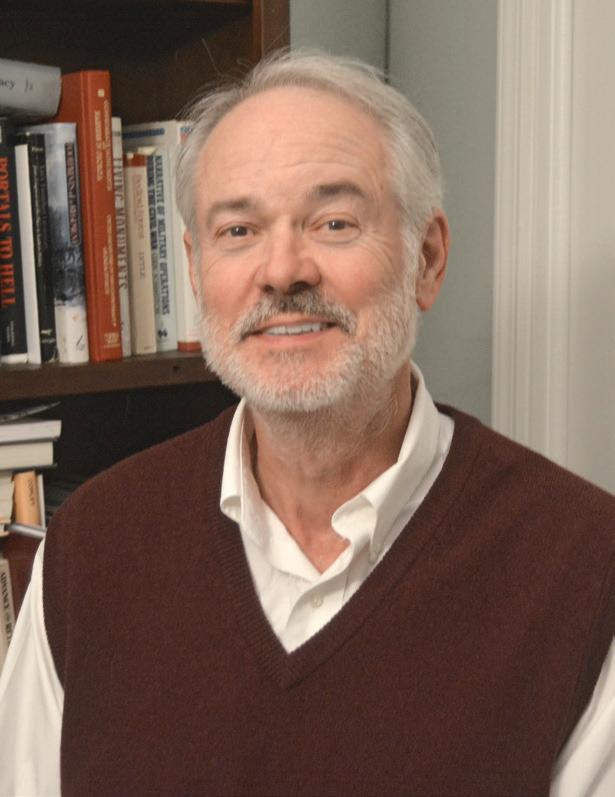
This unique work contains a complete photographic record of Georgia’s memorials to the Confederacy, a full transcription of the words engraved upon them, and carefully-researched information about the monuments and the organizations which built them. These works of art and their eloquent inscriptions express a nation’s profound grief, praise the soldiers’ bravery and patriotism, and pay homage to the cause for which they fought.
www.mupress.org
866-895-1472 toll-free
had not had time or opportunity to cook what they had. All the troops had been without sleep during the night previous, except while waiting in line for the wagon trains to pass over a pontoon bridge at Harpers Ferry…. [N] otice was sent to me to hasten the troops to Sharpsburg. I…started the command at 3 p.m. Halted after dark…within 2 miles of Shepherdstown, when, receiving orders to hasten forward, commenced the march at 12 o’clock that night, many of the regiments still without provisions.” There was no time to lose. McLaws’s report continued:
“On the morning of the 17th, about sunrise, the head of my column reached the vicinity of General Lee’s headquarters near Sharpsburg.” McLaws located Lee, received orders and moved his brigades into the battle already well underway. McLaws wrote: “I was, of course, entirely ignorant of the ground and the location of the troops [of other commands].”
One of McLaws’s brigade commanders, Brig. Gen. Joseph Kershaw, described this march and the condition of his men when they arrived at Sharpsburg: “Owing to the exigencies of the service, my command were without their usual supply of subsistence from Monday morning, September 13, until the night of the 17th. They were also under arms or marching nearly the whole of the nights


of Monday and Tuesday, arriving at Sharpsburg at daylight on Wednesday morning, September 17. As a consequence, many had become exhausted and fallen out on the wayside, and all were worn and jaded.”
Brig. Gen. William Barksdale, commanding another brigade in this division, reached the main Confederate force about 9:00 a.m. “The battle was then, and had been, raging for several hours,” Barksdale wrote, adding that “a portion of my men had fallen by the way from loss of sleep and excessive fatigue, having been constantly on duty for five or six days, and on the march for the whole of the two preceding nights.” Barksdale took 800 men into the fight.
Many weary troops fell out on the way, but much of the division was present in time to advance against Federals who had driven back those troops in line when the struggle began.
The division commanded by Brig. Gen. John Bell Hood was in place earlier, near the Dunker Church, on the afternoon of the 16th. After the division helped slow the Federal advance at Turner’s Gap, Hood’s force served as the rear guard on the 15th and the morning of the 16th as the army fell back to Sharpsburg. In his memoirs Hood described the condition of his men. “My troops…were sorely in need of shoes, clothing and food. We had had issued to us no meat
and at 1 o’clock the march commenced. Reaching the Potomac at sunrise, the division was hurried across and on to Sharpsburg.”
The division was allowed a two-hour rest, then “was again put in motion, and took up its position on the extreme left….”
The men under Maj. Gen. Lafayette McLaws also had a long march to the battlefield. McLaws’s report went into some detail about the marching and fighting and the final dash to the climactic battle.
“The entire command was very much fatigued. The brigades of Generals Kershaw and Barksdale had been engaged on Maryland Heights on the 12th, 13th, and 14th, and on the 15th had been marched from the heights to the line of battle up the valley, formed to oppose that of the enemy below Crampton’s Gap. Those of Generals Cobb, Semmes, and Mahone…had been engaged and badly crippled at Crampton’s Gap, and all the others had been guarding important points under very trying circumstances. A large number had no provisions, and a great portion
32 CWN August 2020
Maj. Gen. Lafayette McLaws. Library of Congress.
Brig. Gen. William Barksdale. Library of Congress.
for several days, and little or no bread; the men had been forced to subsist on green corn and green apples.”
Hood was relieved by three brigades of Brig. Gen. Alexander Lawton’s division. His hungry men retired to their supply wagons and began to cook their rations. As is well known, Hood’s troops had no time to finish their meal. “As the dawn of morning broke upon us,” Hood writes, Lawton sent an urgent message for Hood to come to his support. The Yankees had struck with great force.
One of Lawton’s brigades was led by Brig. Gen. Harry Hays, who reported that of his 550 men engaged at the beginning of this ferocious onslaught, 323 were killed or wounded “in a very short time.” Relieved by Hood, Hays retired. “I then proceeded to gather the remnant of my brigade. When this was accomplished I again moved toward the front.” According to Hood, Hays could rally only 40 men for the renewed effort. The field was covered with the dead and wounded comrades of these few remaining men. “Never before,” Hood wrote, “was I so continuously troubled with fear that my horse would further injure some wounded fellow soldier, lying helpless on the ground.”
The colonel commanding another of Lawton’s brigades was killed in the initial attack. The lieutenant colonel who assumed command was soon wounded. Maj. John H. Lowe then took charge. Like Hays’s men, Lowe’s were forced back in the severe fight, but moved forward again with the reinforcements. Lowe reported that the brigade lost not only its commander and his successor, but “nearly every regiment lost its regimental commander; also the greater portion of the different companies lost their company commanders.”
Let’s now advance with two of Hood’s brigades, relieved earlier for a meal, but called back to battle with their hunger unsatisfied.
Colonel William Wofford,
Civil War
commanding the Texas brigade, wrote that “at daylight the battle was opened. Our brigade was moved forward, at sunrise, to the support of General Lawton….”
One of his regiments “pressed [the enemy] rapidly to their guns, which now poured into them a fire on their right flank, center and left flank from their different batteries, before which their well-formed line was cut down and scattered….” Another of Wofford’s regiments was “in front of the extreme right battery of the enemy…, which now opened upon our thin ranks a most destructive fire.” The Federal infantry also “now opened a furious fire…upon our thinned and almost annihilated ranks.” Wofford was forced to fall back.
Of the 854 officers and men Wofford led into this battle, 560 were killed, wounded or missing. His report named 12 officers killed.
Col. Evander Law commanded another of Hood’s brigades that came forward to support Lawton’s hard-pressed troops. Law wrote that as he advanced he “found but few of our troops on the field and these seemed to be in much confusion, but still opposing the advance of the enemy’s dense masses….”
These fresh troops forced the enemy to “give way before us, though in vastly superior force.” But as Hood’s brigades reinforced Lawton’s, so did fresh Federal brigades come forward.
“At this stage of the battle a powerful Federal force (ten times our number)…was thrown in our front. The losses up to this time had been very heavy…; our ammunition was expended; the men had been fighting long and desperately, and were exhausted from want of food and rest.” Law ordered his men to fall back “to the wood from which I had first advanced.”
At this point Confederate reinforcements arrived. We have heard McLaws, Barksdale and Kershaw describing their rush to Sharpsburg. Now we hear what happened after their just-in-time
Book

arrival.
General McLaws reported that as his division advanced “Just in front of the line was a large body of woods, from which parties of our own troops, of whose command I do not know, were seen retiring, and the enemy, I could see, were advancing rapidly, occupying the place.”
McLaws’s troops checked this Federal advance, “inflicting great loss on the enemy” and driving them “not only through the woods, but over a field in front of the woods, and over two high fences beyond and into another body of woods over half a mile distant.” With no immediate support, some of McLaws’s brigades “fell back into the woods,” but advanced again when additional units came up.
A battery supporting the attack “did most excellent service,” but, McLaws wrote, was ordered to retire “after losing 14 officers and men and 16 horses.” Another battery was “so severely cut up that in a short time by the direct and cross-fires of numerous batteries” that it also was ordered back. The enemy did not attempt another advance but continued to punish McLaws’s troops “with an incessant storm of shot and shell, grape and canister.”
Of 2,893 officers and men carried into action, the division lost 1,093 killed and wounded, and 26 missing. “I could do nothing but defend the position my division had occupied,” McLaws wrote in conclusion.
Barksdale’s report recounted this same bloody back-and-forth through the woods and fields north of Sharpsburg. At 2 p.m.
Barksdale “occupied the battleground over which we had passed in the morning.”
General Kershaw’s casualty report is very telling of the army’s condition at the start of the day and at the end. One of his regiments, the 8th South Carolina, lost 23 officers and men. This may not sound like a heavy toll, until you consider how small a force the 8th was at the beginning of the battle: the regiment started the day with 26 officers and 45 enlisted men.
Brig. Gen. Paul Semmes, another brigade commander under McLaws, reported his unit’s advance as an “incessant current of wounded flowed to the rear.”
In his account “Our troops continued to press steadily forward, pouring a deadly fire into [the enemy’s] ranks, and he, after advancing 100 yards, gave way; and we continued to drive him from position to position, through wood and field for a mile….”
Semmes concluded with an interesting assessment of the Battle of Sharpsburg. “Had it been possible to have strengthened [my brigade] by a supporting force of 2,000 to 3,000 men, there was not then, nor is there now, a doubt in my mind that the enemy’s right, though in vastly superior numbers, would have been driven upon his center and both, in confusion, on his left, utterly routing him. The victory, though decisive, would thus have been rendered signal, and the enemy’s lines broken and dispersed.”
Where these 2,000 or 3,000 men might have come from is unclear, as is the reason for Semmes’s assessment of Sharpsburg as a
decisive victory.
Barksdale’s report concludes without such speculation or assessment. “I close this report,” he wrote, “with the remark that my command did its duty on the ensanguined field of Sharpsburg.”
The horrendous bloodletting on the Confederate left flank ended with both sides exhausted. Heavy fighting in this sector ended by late morning. In Part II we will move to another place on this “ensanguined field.”
Sources and additional reading:
Advance and Retreat, by General John Bell Hood; Official Records, Series I, Volume XIX, Part I, reports of Barksdale, Hays, John R. Jones, Law, Lawton, Kershaw, McLaws, Semmes and Wofford.

Maps of the Sharpsburg battlefield can easily be found online. The American Battlefield Trust shows excellent maps at its site, www.battlefields.org. The reader can appreciate the effort McLaws’s and Jones’s divisions made to reach the battlefield from the maps at Wikipedia’s article on the Maryland Campaign.
Gould Hagler is a retired lobbyist living in Dunwoody, Ga. He is a past president of the Atlanta Civil War Round Table and the author of Georgia’s Confederate Monuments: In Honor of a Fallen Nation, published by Mercer University Press in 2014. Hagler speaks frequently on this topic and others related to different aspects of the Civil War and has been a regular contributor to CWN since 2016. He can be reached at gould.hagler@gmail.com.
33 August 2020 CWN
lPromoters of Quality Shows for Shooters, Collectors, Civil War and Militaria Enthusiasts Military Collectible & Gun & Knife Shows Mike Kent and Associates, LLC • PO Box 685 • Monroe, GA 30655 (770) 630-7296 • Mike@MKShows.com • www.MKShows.com January 30 & 31, 2021 Chickamauga (Dalton) Civil War Show November 14 & 15, 2020 Capital of the Confederacy Civil War Show (Richmond, Va.) December 5 & 6, 2020 Middle TN (Franklin) Civil War Show
392 page, full-color book, Civil War Artillery Projectiles – The Half Shell Book. For more information and how to order visit the website www. ArtillerymanMagazine.com or call 800-777-1862. $89.95 + $8 media mail for the standard edition.
Artillery
interests seemed as though they were in competition with each other, but in the end, after lots of discussion, compromise, and creative thinking, everyone was able to walk away with a “win.”
Recent events have been tumultuous, but I hope for a similar “win-win” outcome.
heritage, how to ensure racial justice, and how to ensure everyone gets equal treatment under the law. There’s a tremendous amount there to unpack, but the more “win-win” scenarios we can find, the better off everyone will be.
– Chris Mackowski, Ph.D. Editor-in-Chief
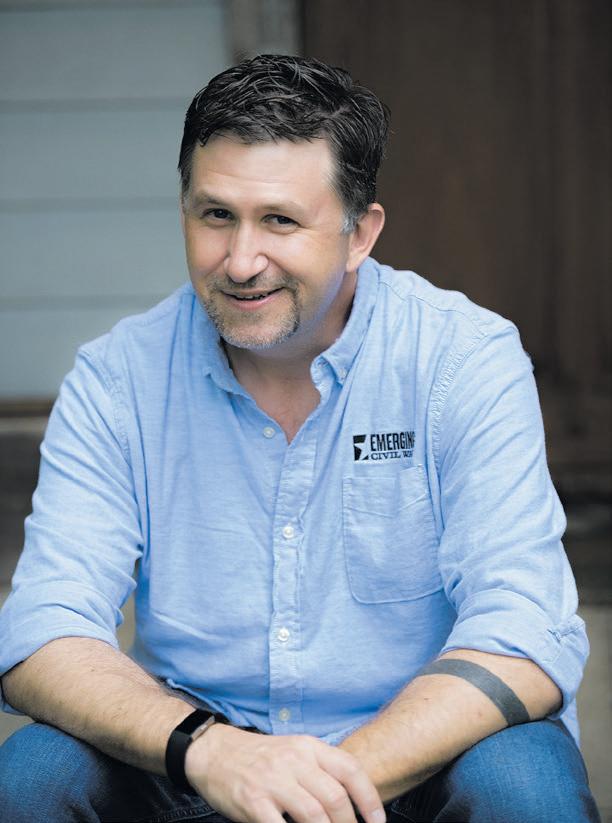
Emerging Civil War Behind the Scenes
ECW is pleased to continue our exciting work with Southern Illinois University Press on our “Engaging the Civil War” Series.
joining the blog last year, with a focus on leadership and command issues: https://emergingcivilwar. com/author/joannammcdonald.
Most recently, Cecily Nelson Zander has contributed several blog posts to ECW since coming aboard: https://emergingcivilwar.com/ tag/cecily-nelson-zander.
From the Editor
In the preservation world, we like to tout “win-win” situations. For example, when the May 1 battlefield at Chancellorsville was preserved, preservationists won a major victory because they saved hallowed ground. Developers won a victory because the county gave them zoning concessions on the ground they were still able to build houses on. The county won a victory because it not only benefitted from real estate taxes but also revenue from historical tourism. At first, these various

At Emerging Civil War, we have a lot of historians with a lot of strong opinions about what’s been going on, particularly in regard to monuments and other aspects of Confederate culture. As an organization, we don’t have a specific stand because we have such a diverse range of individual opinions among our members. We’ve tried to present as many of those perspectives on our blog as possible so that readers have many things to think about and many tools to consider.
One thing we all agree on, though, is that a better understanding of history can help us better navigate these difficult discussions. We know many of our readers agree. I want to thank all of you who have tried to raise public awareness about our national history and how that might better inform us all as we look for ways to address issues such as how to deal with Confederate
We recently overhauled our editorial board, and we’re pleased to introduce our new line-up of “emerging” scholars:
• Zackery A. Fry, US Army Command and General Staff College, Fort Belvoir
• Hilary Green, University of Alabama
• JoAnna M. McDonald, Emerging Civil War
• Angela M. Riotto, Army University Press, Fort Leavenworth
• Evan C. Rothera, University of Arkansas, Fort Smith
• Nicholas Sacco, National Park Service, U. S. Grant National Historic Site
• Cecily N. Zander, Pennsylvania State University
You’ve seen the work of many of these folks at ECW already. For instance, Editor-in-Chief Chris Mackowski did a free podcast interview with Zack Fry about Zack’s new book, Republic in the Ranks, which discusses the Army of the Potomac and the political allegiances of the soldiers within its ranks: https://www.patreon.com/posts/37622033.
Chris also did a free podcast interview with Brian Matthew Jordan and Evan Rothera about their new book, The War Went On: Reconsidering the Lives of Civil War Veterans: https://www. patreon.com/posts/37826719.
You can also see Brian’s keynote address from the 2017 Emerging Civil War Symposium at Stevenson Ridge. He spoke about the battle of South Mountain: https://www.c-span.org/video/?431932-4/ battle-south-mountain
JoAnna McDonald has been knocking it out of the park since
Nick Sacco contributed an essay in ECW’s Entertaining History book about Grant’s memoirs, which he’s also discussed in an ECW podcast: https://emergingcivilwar.com/2020/02/25/ ecw-podcast-ulysses-s-grant-inmemoir-memory-is-now-available. More recently, we talked with Nick about the Civil War “Zoom boom”: https://emergingcivilwar.com/2020/06/01/thecivil-war-zoom-boom-part-fourulysses-s-grant-national-historicsite.
We’re excited about working with such great emerging voices as we continue forward with this book series. We have a lot of cool projects in the works!
ECW News & Notes
The July 2020 issue of Civil War News includes an article that features Emerging Civil War. The piece, penned by our editor-in-chief, Chris Mackowski, looks at the many different ways the COVID-19 pandemic has affected historians. The article quotes a number of ECW’s historians, who serve as a wide-ranging sample of the Civil War field as a whole.

The blog Civil War Books and Authors published a nice review of the ECW book Entertaining History, part of our “Engaging the Civil War” Series with Southern Illinois University Press. Reviewer Drew Wagenhoffer called it “a thoroughly engaging exploration of the popularization of the Civil War in song and on page and screen.” Check out the review here: https://cwba.blogspot. com/2020/06/review-entertaining-history-civil-war.html
Sarah Bierle took a “social distanced” trip to Kelly’s Ford recently. She says it was great to get out and see some different battlefield land. “I sat by the river and read for a while until some fishermen came up and told me to be careful since there was a water moccasin swimming upriver toward where I was sitting,” she says. “Yikes! I keep having near misses with snakes at historic sites.”
Doug Crenshaw is steadily working on a volume on the Confederate high command during the Seven Days. He and Drew Gruber recently finished
the manuscript for an ECW book on the 1862 Peninsula campaign. Doug and Bert Dunkerly will be hosting a video for the Richmond National Battlefield Park about Richmond’s lesser-known battlefields on August 23. He and Bert will also be doing a video for the park featuring the battle of Glendale on Sept. 13. You can also find Doug leading a Seven Days tour for the American Battlefield Trust on October 24, and he has several speaking engagements lined up for the fall, too, so keep your fingers crossed!
Bert Dunkerly, like many of us, had tours and talks cancelled. He’s had several invitations to do Zoom or other virtual programs, though, and will be doing those for the next few months. He’s also used this time to get out and explore lesser-known historic sites and remote areas of battlefields, where he’s unlikely to run into crowds.
Dwight Hughes was asked to contribute an essay to The Essential Civil War Curriculum, a Sesquicentennial project of the Virginia Center for Civil War Studies at Virginia Tech. The 5,000-word essay, “Unvexed Waters: The Civil War on Heartland Rivers,” has been submitted for review and approval. Meg Groeling has finally gotten her hair cut! She has been researching and writing essays for an upcoming ECW book on primary sources, which, for her, means more Walt Whitman. She has also been stress-baking loaves and pans of gingerbread. The entire neighborhood has gotten gifts, although she didn’t check the trash to see if any ended up there. “Like everyone else, I’m worried about the state of the country,” she admits. “At this point, I’ll take thoughts & prayers.”
Chris Kolakowski is pleased and proud to have helped tell the story of the Battle of Algiers, 1942, part of the Operation Torch landings in North Africa, in the new documentary Shadows of Freedom, just released on several platforms. Find it here: https://www.facebook.com/ shadowsofreedom.
Chris also has a new article out in Army History on “Merrill’s Marauders” in north Burma during World War II.
https://history.army.mil/armyhistory/AH-Magazine/2020AH_ summer/index.html?fbclid=IwAR1TYP-Kb7pjck0bDlZgZK8UVAIwa98bNOjfzVqktK_ NGM_MI5jcw1wOb-w.
10 Questions...with
34 CWN August 2020 www.emergingcivilwar.com
Chris Mackowski
Brian Matthew Jordan Brian Matthew Jordan is an
The Day One battlefield at Chancellorsville provided “wins” for all the constituencies involved.
assistant Professor of History and Director of Graduate Studies in History at Sam Houston State University in Huntsville, Texas. He’s also co-editor of ECW’s Engaging the Civil War Series with Southern Illinois University Press.

You can read Brian’s full ECW bio here: https://emergingcivilwar.com/ author-biographies/authors/ brian-matthew-jordan.
Veterans were both powerful sites of memory and active participants in the struggle to control the meaning and legacy of the war.
Your new book is an volume of essays you co-edited with Evan Rothera, titled The War Went On: Reconsidering the Lives of Civil War Veterans. Can you tell us a little about that book?
You made a big splash with your book Marching Home: Union Veterans and Their Unending Civil War, a finalist for the Pulitzer Prize. Since then, you’ve continued to look at the lives of Civil War veterans, including in your newest book (which we’ll talk about in a sec). What is it about this topic that continues to compel you?
As a scholar, I’m fascinated by the ways in which the Civil War annexed everyday life. I’m also preoccupied by the ways in which the war’s violence rippled beyond the battlefield and through the decades. We think of the war as a discrete historical event, but for the generation that lived it, the war of the rebellion was a messy human experience. When you approach the conflict from that perspective, the whole landscape of the past looks a little different; some historiographical questions that we endlessly debate seem less immediately relevant. Despite a rich outpouring of recent scholarship, we still have much work to do before we can even approximate the personal consequences of the war, what it did to bodies and minds. The social historian in me loves this work; it amplifies the voices of some ordinary historical actors who have always fit uneasily into the stories the nation has preferred to tell about the Civil War. Speaking of those narratives, I continue to be fascinated by veterans because of my abiding interest in historical memory.
The War Went On is a collection of scholarly essays about the lives and experiences of Civil War veterans. It makes three central claims. First, the book demonstrates that the “hibernation” thesis, the notion that veterans suppressed the war and its issues, does not really capture the messy reality of veterans’s experiences in the decades immediately after Appomattox. We propose that engaging with the war’s history was more than attending a reunion or strutting down Main Street on Memorial Day; it was engaging in electoral politics, thinking about the war hemispherically, planting colonies in the Dakotas, making out a pension claim, or tending to a rotting wound. Second, the book demonstrates that veterans took seriously their role as historians. David Blight has argued that Civil War veterans were the first Civil War “buffs,” but veterans believed that they were the true arbiters of the war’s history. Finally, the book seeks to convey the range and diversity of veterans’ experiences after the war. How veterans experienced reintegration, imagined the future, and lived out the balance of their lives depended not only on their unique wartime experiences, but on who they were before the war. The book seeks to move Civil War veterans’ studies beyond some unnecessarily polemical debates by pointing in new directions. We include essays on previously under-explored cohorts of veterans, southern Unionists, Confederate deserters, and rebel guerrillas, for instance. We include essays that ask new questions of old sources, like the National Tribune, regimental histories, and disability pension files. We also introduce some new bodies of evidence, including veteran authored plays, state soldier home records, and GAR Memorial Halls as physical spaces.

How does an examination of Civil War veterans help us understand some of the issues today’s veterans might be facing?
What grizzled old Billy Yanks make so urgently evident is the significance of postwar politics in any veteran’s personal healing
or reintegration to civilian life. While veterans tended to a ghastly catalogue of physical wounds and untold psychological scars, and while the memory of what they did at Shiloh could (and did) gnaw at them for decades, what haunted Billy Yank above all else was the possibility that he had suffered and sacrificed in vain. As former rebels regained their prewar social and political clout, and northerners clasped hands across the bloody chasm, Billy Yank was left to wonder if he had won the war after all. Indeed, it is easy for us to forget that Billy Yank returned home to a society that was sharply divided over the war, a northern population that had reached no consensus about the meaning or necessity of emancipation, the proper punishment for a treasonous rebellion, or the participation of so many men in great violence.
James McPherson persuasively argued that a keen sense of what was at stake in the war steeled and sustained Billy Yank through four years of fighting. Ironically, that same knowledge rattled the Union veteran as he confronted the peace. He looked on uneasily as the radical possibilities of the war yielded—though not inevitably—to the farce of Jim Crow
The lessons, then, are these: (1) political divisions on the home front during the war and immediately thereafter will yield more complicated and troubled homecomings; (2) benefits and health care are vital, but veterans also need genuine acknowledgment, and (3) it is vital that veterans maintain a sense of authority over their war and its issues.
In one of your many capacities, you serve as a co-editor of ECW’s “Engaging the Civil War” Series with Southern Illinois University Press. What do you enjoy about working on that series?
Co-editing the Southern Illinois University Press series has been truly rewarding. I believe that all Civil War historians are by definition public historians; given the intense public interest in our subject, not to mention its enduring relevance, we have a professional obligation to reach lay audiences. The Engaging Series is a place to collect compelling new work that, while aimed at a broad audience, sacrifices nothing in terms of scholarly moorings and peer review. Co-editing the series has allowed me to work with authors, and a co-editor, who care about both the craft of history and the craft of writing.
You’re also working on some projects for the Emerging Civil
War Series. What do you have in the hopper?
I’m finishing An Unspeakable Calamity: The Assassination of Abraham Lincoln and the Road to Reconstruction, which I hope will convey something of the uncertainty and confusion that attended the end of the war. Booth’s pistol fired not the last shot of the Civil War, but rather the first shot of Reconstruction. I’m also working on a short history of the battle of South Mountain for the ECWS series. I hope to contribute other titles as time allows moving forward.
Lightning Round (short answers with a one-sentence explanation)
Favorite primary source?
I am happiest when a stack of Union pension files is delivered to me in Room 203 of the National Archives.
Favorite Civil War-related monument? The preserved United States!
I’m going to cheat and give two more answers: my favorite battlefield monument is the simple wooden board erected by the Wisconsin Company of Berdan’s Sharpshooters at the Deep Cut on the Second Bull Run battlefield where a replica is maintained on the spot today, but my favorite Civil War monument is the Lincoln Memorial.
Favorite unsung hero of the Civil War era? Benjamin F. Butler. He’s come to us mostly through caricature, but we need to take him seriously.
What’s a bucket-list Civil War site you’ve not yet visited? Fort Donelson is the only major battlefield I have not visited.
Favorite ECWS book? Strike Them A Blow recounts an important leg of the Overland Campaign in gripping prose.
ECW Bookshelf
ECW’s Eric Wittenberg has a new co-authored book out. “West Virginia was the child of the storm,” concluded early Mountaineer historian and Civil War veteran, Maj. Theodore F. Lang. The northwestern third of the Commonwealth of Virginia finally broke away in 1863 to form the Union’s 35th state. In Seceding from Secession: The Civil War, Politics, and the Creation of West Virginia, authors Eric J. Wittenberg, Edmund A. Sargus, and Penny L. Barrick chronicle those events in an unprecedented study of the social,
legal, military, and political factors that converged to bring about the birth of the West Virginia.
President Abraham Lincoln, an astute lawyer in his own right, played a critical role in birthing the new state. The constitutionality of the mechanism by which the new state would be created concerned the president, and he polled every member of his entire cabinet before signing the bill. Seceding from Secession includes a detailed discussion of the 1871 U.S. Supreme Court decision Virginia v. West Virginia, in which former Lincoln cabinet member Salmon Chase presided as chief justice over the court that decided the constitutionality of the momentous event.
Curious about our Engaging the Civil War Series from Southern Illinois University Press? Here’s our line-up so far:
Turning Points of the American Civil War edited by Chris Mackowski and Kristopher D. White
“All of the essays included in this slim volume are excellent, both readable and meticulously researched. Turning Points of the American Civil War is a must read for all Civil War buffs.”—Paul D. Travis, Journal of Southern History
Where Valor Proudly Sleeps: A History of Fredericksburg National Cemetery by Donald C. Pfanz
“This might be the best book ever written about a national cemetery. Donald Pfanz tells in vivid form and in close detail the story of how, over time, a place of struggle became a place of remembrance.”—John J. Hennessy, author of Return to Bull Run
The Spirits of Bad Men Made Perfect: The Life and Diary of Confederate Artillerist William Ellis Jones by Constance Hall Jones
“As lush with literary allusions
35 August 2020 CWN
Dr. Brian Matthew Jordan is co-editor of the Engaging the Civil War Series.
Eric Wittenberg’s latest book.
as it is sharp with critiques of military life, the diary of William Ellis Jones epitomizes the soldier’s plight . . . as well as the small comforts of friends, drink, and reading.”—Kathryn Shively Meier, author of Nature’s Civil War
New
Entertaining History: The Civil War in Literature, Film, and Song edited by Chris Mackowski
“Brisk and lively, the essays in Entertaining History convey the immersive joy of reading, watching, and listening to popular Civil War history.”—Megan Kate
Nelson, author of Ruin Nation: Destruction and the American Civil War
Imagining Wild Bill: James Butler Hickock in War, Media, and Memory by Paul Ashdown and Edward Caudill
from Valley Arts Publishing & Casteel Sculptures, LLC
Monument Replicas
Monument Replicas
Valley Arts Publishing features superb signed and numbered, limited edition Civil War Fine Art landscapes prints and Battlefield Monument Replicas created by sculptor Gary Casteel.

www.valleyartsgallery.com - to purchase, or purchase at our gallery at 789 Baltimore St., Gettysburg, PA 17325 717-387-0461 – garycasteel2018@gmail.com
“The one and only gallery for Civil War monument replicas by noted historical artist Gary Casteel”
Made in the United States
“A spirited and carefully framed reassessment that is thoughtful, nuanced, and most important, fair to a subject who is otherwise evasive to the claims of mere mortals.”—Bryan Giemza, author of Images of DepressionEra Louisiana June has been a momentous month in terms of the present meeting the past. ERW wanted to release the following statement: With the recent events facing our nation, American Revolutionary War monuments and memorials have an important role in demonstrating pride in our shared past and the highest ideals we value. Statues and monuments to the leaders and participants of the struggle for American independence today stand on battlefields, in courthouse squares, and on historic sites all across this nation. While these statues depict very flawed and imperfect human beings, they memorialize the deeds and character that contributed to the creation of the nation we now live in. These statues and monuments not only tell an important part of the nation’s founding, they are also artifacts of the eras in which they were constructed and how we have remembered our Revolutionary struggle, and how the ideals of the Revolution continue to live to this very day.
Part of what we do at Emerging Revolutionary War is connect the past to what people can find at historical sites today. Over the past few weeks, we have seen
localities remove or plan to remove statues honoring Caesar Rodney in Delaware and Philip Schuyler in New York. We have also seen statues of Marquis de Lafayette, Baron von Steuben, and Thaddeus Kosciusko vandalized in Washington, D.C.; a statue of George Washington vandalized in Boston; statues of Washington and Benjamin Franklin, and the Tomb of the Unknown Revolutionary War Soldier vandalized in Philadelphia .
We feel it is important that all the United States’ Revolutionary War statues and monuments are protected so they can continue to represent our highest values and ideals and the tell the story of the important figures who shaped our nation. Without these monuments, we lose vital resources to tell the important stories of our past and help unite us in moving forward as a country.
As the 250th anniversary of the American Revolution draws near, rather than the removal of monuments, we hope more monuments and memorials will be erected, especially for overlooked populations that also played a role in the founding of our nation. With this more comprehensive view of history in mind, a broader and more accurate story can be told to the American public. Emerging Revolutionary War will continue to trace the stories of the past and tie them to the places through these challenging times and we look forward to a better tomorrow.”
As always, we invite conversation and viewpoints on the history of the Revolutionary Era and the threads that connect to the present, on our blog: www.emergingrevolutionarywar.org.


100 Significant Civil War Photographs: Atlanta Campaign collection of George Barnard’s camera work. Most of the photographs are from Barnard’s time in Atlanta, mid-September to mid-November 1864, during the Federal occupation of the city. With this volume, Stephen Davis advances the scholarly literature of Barnardiana.


$19.95 + $3.50 shipping 128 pages, photographs, maps, bibliography. $19.95 + $3.50 shipping. Softbound. ISBN: 978-1-61850-151-6. www.HistoricalPubs.com.
Order online at www.HistoricalPubs.com or call 800-777-1862
36 CWN August 2020 Subscribe online at CivilWarNews.com
48 E. Patrick St., Frederick, MD. 301-695-1864 / civilwarmed.org Divided by Conflict. United by Compassion.
The American Civil War was the first war in which both sides widely used entrenchments, repeating rifles, ironclad warships, and telegraphed communications. It was also the first American War to be extensively photographed. Mathew Brady, Alexander Gardner and Timothy O’Sullivan are famous for having made iconic photographs in the Civil War’s eastern theater. George N. Barnard deserves to be ranked in this top tier for his photographic work in the war’s western theater. A civilian photographer hired by Gen. William T. Sherman’s chief engineer to take pictures of fortifications around Atlanta, Barnard took several hundred of them in and around the city in the fall of 1864. His most famous is the site of Union Maj. Gen. James B. McPherson’s death in the battle of Atlanta, July 22, 1864. Thus far, no comprehensive, definitive listing has been made of the photographer’s The Library of Congress has 130 images; the U. S. Military Academy at West Point, New York, has at least 98 photographs, donated by Captain Poe’s widow. Other repositories, such as the Gilder Lehrman Institute of American History in New York City, have smaller collections. For this book we have chosen a hundred images we deem “significant,” though other students may wonder at some of our selections. We hope that this work will stimulate further interest in Barnardiana, and that other scholarly volumes are yet to come. The Atlanta Campaign STEPHEN DAVIS 100 SIGNIFICANT CIVIL WAR PHOTOGRAPHS ATLANTA CAMPAIGN
Previously Unknown Map Showing Engagement’s Aftermath Amounts to ‘Rosetta Stone” for Battle of Antietam
Existing historic resources seen in new light as recently uncovered S.G. Elliott Burial Map shows precise locations where more than 5,800 Americans rested in temporary graves
Without a doubt, the battlefield at Antietam, site of the September 17, 1862, clash that still represents the bloodiest day in American history, is hallowed ground. Antietam National Battlefield protects landscapes associated with the Union strategic victory that gave Abraham Lincoln the opportunity to issue his Emancipation Proclamation. Now, a period map, uncovered through happenstance by researchers primarily concerned with a different engagement, is shedding new light on the human toll of war by showing the locations where more than 5,800 Americans were buried on that field, often just feet from where they fell.
“Looking at this map, there can be no doubt in the truth of the statement that a battlefield is ‘hallowed ground,’ made so by the blood of soldiers,” said American Battlefield Trust President Jim Lighthizer. “The landscape around Sharpsburg was turned into one vast cemetery, sacred to the memory of those who lost their lives in the struggle.”
More than this symbolic value, the map unleashes a host of interpretive opportunities for historians. “This discovery reveals truths about the Battle of Antietam lost to time” said Trust Chief Historian Garry Adelman. “It’s like the Rosetta Stone: by demonstrating new ways that primary sources already at our disposal relate to each other, it has the power to confirm some of our long-held beliefs, or maybe turn some of our suppositions on their heads.”
Although residing in the collection of the New York Public Library and digitized by that organization nearly two years ago with National Endowment for the Humanities grant funding, the map was wholly unknown to experts in the field, including the National Park Service staff at Antietam National Battlefield, until this spring, when researchers from the Adams County Historical Society (ACHS) in Gettysburg, Pa., happened upon it. They were looking for information on the mapmaker, Simon G. Elliott, who is renowned in Civil War history circles for a similarly detailed and often cited study of the Gettysburg Battlefield.
ACHS Executive Director Andrew Dalton had begun looking for more details about the somewhat mysterious cartographer, who has a checkered reputation from
his work on railroads in California and Oregon. As Dalton looked into what, precisely, brought Elliott east, his colleague Timothy H. Smith scoured other digital collections to compare minor differences in printed copies of the Gettysburg map, hoping to determine the original versus subsequent revisions.
“The New York Public Library has an excellent map collection,” said Smith. “I searched for ‘S.G. Elliott’ and ‘Gettysburg,’ then downloaded the results, so I could look at them in detail. When I opened up the file, I was utterly taken aback and knew I was looking at something extraordinary.” In addition to alerting his colleague, Dalton, Smith swiftly reached out to the Trust’s Adelman, a close friend and longtime collaborator, looking to corroborate the significance of the discovery. Adelman confirmed the instincts of ACHS’s Gettysburg experts and shared word of the find with Antietam National Battlefield park ranger historian Brian Baracz, who was, likewise, totally unaware of the map’s existence.
“One of the beauties of working with the public is that you never know what’s going to come in the door,” said Baracz. “We have visitors bring us new letters and diaries from participants on a regular basis and those enrich our understanding. But this find exceeds all that; it is on a fundamentally different level.”
Elliott’s Antietam Map, like its Gettysburg counterpart, shows in

significant detail about how the battlefield appeared in the aftermath of fighting. The two maps were likely made at approximately the same time, during the autumn of 1864, when Elliott came east to lobby Congress on a railroad bill. Although they were recorded a year (in the case of Gettysburg) or two (in the case of Antietam), after the battle, they show precise locations for burials of Union and Confederate soldiers (differentiated by the icon used), as well as horses, because they were based on surveys done immediately following the fighting.

The Battle of Antietam saw some 23,000 total casualties, with the National Park Service interpreting that some 4,000 to 5,000 men are individuals who died on the day of the battle. Although historians are still performing analysis of the map, more than 5,800 soldier burials are individually recorded, typically in groups associated with a particular regiment, also noted on the map. Field burials often saw soldiers interred by comrades, very close to where they fell, meaning that the map confirms the locations where specific units were engaged on the field.
“In some ways, this Antietam map is even better than the Gettysburg one,” said ACHS’s Dalton. “On the latter, Elliott identified 18 soldiers by name when he marked their graves, but at Antietam, he was able to do that for more than 50. For each of those men, we can tell a story.”
This type of detail opens up remarkable interpretive opportunities, especially when paired with other battle documentation such as diary entries describing the work of burial crews and the photographs taken by Alexander Gardner, the echoes of which can be found in the Elliott Map. Likewise, the visual representation of exactly where men died and were initially buried; although the number of burials made at Antietam National Cemetery demonstrates the vast majority of the internments have been moved off the field, occasional discoveries of human remains do occur at Antietam and other sites and have major implications on battlefield preservation initiatives. The Elliott map shows that dozens of men were once buried in the immediate vicinity of the
national park’s visitor center. The 461 acres that have been protected by the American Battlefield Trust show evidence of more than 600 burials.
“I have no doubt that this is going to change the way we understand and preserve Antietam,” said Tom Clemens, president of the Save Historic Antietam Foundation, one of the country’s top battlefield friends organizations. “Knowing where that sacred ground lies is vital to us as preservationists. It underscores the urgency of our task”
Those interpretive shifts will become evident, as the National Park Service is making plans to integrate the Elliott Map, both visually and interpretively, into exhibits at the Antietam National Battlefield Visitor Center.


37 August 2020 CWN
Antietam Battlefield. Photo by Buddy Secor.
Burnside’s Bridge at Antietam. Photo by Jen Goellnitz.
Elliott burial map of Antietam. Courtesy New York Public Library.
Closeup of the second position of Burnside’s Corps on the 17th.
Chesapeake Monument Commemorates Jackson Greys

 by Bob Ruegsegger
by Bob Ruegsegger
In the old Pleasant Grove Baptist Churchyard on St. Brides Road West, a rough granite obelisk commemorates formation of the Jackson Greys on July 11, 1861. The Greys were a company of local men who volunteered their services to their state and ultimately to the Confederacy during the Civil War.

Recruited from St. Brides Parish in what was then Norfolk County, the Jackson Greys were named in honor of James W. Jackson, the proprietor of the Marshall House in Alexandria, Va. Jackson shot Colonel Elmer Ellsworth of the New York Fire Zouaves when Ellsworth attempted to remove the Confederate flag from his hotel. During the disturbance that followed Ellsworth’s shooting, Jackson was also killed.
The company was created on the grounds of Pleasant Grove Baptist Church by Captain William H. Stewart whose residence, Beechwood, was situated nearby. Stewart was born
on September 25, 1838, in Deep Creek, Norfolk County, Va. He was educated at the Union Academy in Hertford County, N.C., and left his home in the Tidewater to attend the University of Virginia in 1857. During the spring of 1861, many young Virginians who were advocates of secession were forming militia companies in anticipation of defending the Old Dominion.
Captain William H. Stewart was one of those young men.
The Jackson Greys were mustered into the service of the Confederacy as Co. A, 61st Virginia Volunteer Infantry Regiment and initially defended the Gosport Navy Yard. Members of the Jackson Greys met in Richmond with other men from South Hampton Roads to form Co. A, 61st Regiment Virginia Infantry and to elect the field grade officers of the regiment. Virginius Despeaux Groner was elected colonel, and William Frederick Niemeyer, a former West Point cadet, was named
lieutenant colonel. William Stewart accepted the post of major. After Niemeyer was killed in battle near Spotsylvania Courthouse, Stewart replaced him as lieutenant colonel.

In December 1861, the unit was transferred to an advanced artillery battery at Sewell’s Point where they exchanged artillery fire with Fort Wool in the middle of Hampton Roads harbor.
Local militia units kept a watchful eye on developments at the U.S. Navy Shipyard at Gosport. When Union forces set fire to the shipyard and evacuated Gosport, Virginia militia units charged into the yard in an effort to save as much military equipment as was feasible.
The partially burned hulk of the USS Merrimac was among the stores and equipment salvaged by the Confederates. The Merrimac’s hull served as the core of the ironclad CSS Virginia.
When the CSS Virginia steamed out of Gosport on March 8, 1862, to do battle with the frigate USS Congress and the sloop-of-war USS Cumberland, Captain Stewart and the Jackson Greys manned the rifled guns on Sewell’s Point.
As the steam frigate USS Minnesota moved up from Fort Monroe during the contest, the ship passed within range of Sewell’s Point’s guns; several shots slammed into the vessel. One projectile, struck the main mast.
By May 1862, despite protests from the local citizenry, Confederate troops began removing military stores and preparing to abandon Norfolk and the Gosport Navy Yard. When General Wool arrived at Ocean View with a large contingent of Union troops, Confederate troops, including the Jackson Greys, had already evacuated Norfolk. Norfolk and the best shipyard in America returned to Union control.
Upon evacuating Norfolk, the Jackson Greys were relocated to Bermuda Hundred near Petersburg. On June 26, 1862, the unit exchanged cannon fire with Union gunboats at Port Walthall.
After a brief period of independent service, the regiment joined Gen. William Mahone’s Brigade near Fredericksburg. The 61st Virginia became the final component of one of the best brigades in the Army of Northern Virginia. Most men in the brigade, like their commander, were from southeastern Virginia.
The 61st fought at Fredericksburg, Spotsylvania,
38 CWN August 2020
This overview of the Jackson Greys monument site illustrates the monument, flagpole, benches, and fenced enclosure. The Jackson Greys monument site was developed with funds raised by the Norfolk County Grays Chapter of the United Daughters of the Confederacy. The Norfolk County Grays Chapter of the Sons of Confederate Veterans maintains the site.
Lt. Colonel William H. Stewart.
Jackson Greys Monument detail.
Bob Shirley is Commander of the Norfolk County Grays. He is a descendant of privates T.E. Halstead and J.P. Halstead who served with the Jackson Greys. Both are named on the monument.
This weathered sign on Battlefield Blvd. (Route 168 South Business) directs visitors to the Jackson Greys Monument.

Virginia Infantry are inscribed as a tribute to their courage and honor.
Civil War Artillery Book

Civil War Artillery Projectiles – The Half Shell Book. This hardbound book has 392 pages, and is full-color with 850 photographs. For more information and how to order visit the website www.ArtillerymanMagazine. com or call 800-777-1862.

$89.95 + $8 media mail for the standard edition.
The names of these men were listed among the privates who served in the Jackson Greys.

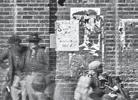

Chancellorsville, Salem Church, Gettysburg, Cold Harbor, the Wilderness, the Crater, Wilcox’s Farm, Burgess’ Mill, Bristoe Station, Weldon Railroad, and Cumberland Church before surrendering at Appomattox on April 9, 1865.
Lt. Colonel Stewart and his men were paroled by Union authorities at Appomattox. After the Civil War, Stewart returned to Norfolk County and farmed his father’s land for five years before moving to Portsmouth to study law. Stewart served as commonwealth’s attorney for Norfolk County and as vice president of

the Norfolk and Portsmouth Bar Association. In addition, Stewart worked as an editor for The Norfolk Landmark and founded and edited the Tidewater Times (Portsmouth Times Weekly).

On July 11, 1905, Stewart, with other former Jackson Greys, watched as a small granite monument was unveiled in their honor at the church where local men first volunteered for military service.
The rough granite monument still stands where it was unveiled. On its polished surfaces, the names of those who served with the Jackson Greys in the 61st

Lt. Colonel Stewart’s sword, acquired during the Wilderness Campaign from a Union cavalryman who no longer needed it, is on display in the Wallace Local History Room at the Chesapeake Central Library along with other relics from Chesapeake’s past.
Bob Ruegsegger is an American by birth and a Virginian. His assignments frequently take him to historic sites throughout Virginia, the Mid-Atlantic, and the Southeast. His favorite haunts include sites within Virginia’s Historic Triangle—Jamestown, Yorktown, and Williamsburg. Bob served briefly in the U.S. Navy. He is a retired educator and has been an active newspaper journalist for over twenty years.
“The best little book on Barnard”
The American Civil War was the rst war in which both sides widely used entrenchments, repeating ri es, ironclad warships, and telegraphed communications. It was also the rst American War to be extensively photographed. Mathew Brady, Alexander Gardner and Timothy O’Sullivan are famous for having made iconic photographs in the Civil War’s eastern theater. George N. Barnard deserves to be ranked in this top tier for his photographic work in the war’s western theater. A civilian photographer hired by Gen. William T. Sherman’s chief engineer to take pictures of forti cations around Atlanta, Barnard took several hundred of them in and around the city in the fall of 1864. His most famous is the site of Union Maj. Gen. James B. McPherson’s death in the battle of Atlanta, July 22, 1864. Thus far, no comprehensive, de nitive listing has been made of the photographer’s work. For this book we have chosen a hundred images we deem “signi cant.”


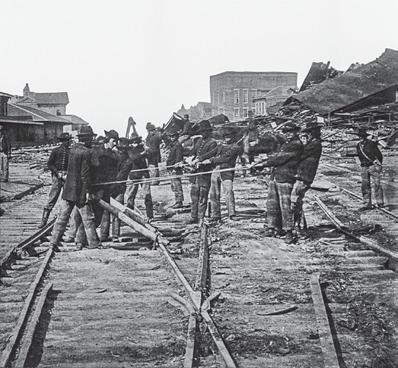


128 page Paperb ac k: $19.95 (+$3.50 S & H)



Ordering

39 August 2020 CWN “The STORIES BEHIND THE PICTURES” 100 Significant Civil War Photographs CHARLESTON IN WAR By Stephen Davis & JACK W. MELTON JR Name Shipping Address City State Zip 160 pages • OVER 100 PHOTOS • MAPS • INDEX • BIBLIOGRAPHY • ISBN: 978-1-61850-167-7 Paperback: $19.95 (+$3.50 S & H) • Released Jan. 2020 3 ways to order YOUR COPY! CALL US 800-777-1862 ORDER ONLINE www.historicalpubs.com fill out this form BELOW & mail with a check for $23.45 to: Historical Publications LLC 520 Folly Road, Suite 25 PMB 379, Charleston, SC 29412 (S.C. residents include 9% sales tax of $1.80) newly and Charles photograph, selected e Fire allow book are Confederates Harbor Reminiscences of Federal history historical works. such as (1838–1910). DAVIS & MELTON 100 SIGNIFICANT CIVIL WAR PHOTOGRAPHS CHARLESTON IN THE WAR
info: $19.95 plus $3.50 s&h South Carolina residents add 9% sales tax Mail a check to: Historical Publications LLC 520 Folly Road, Suite 25 PMB 379 Charleston, SC 29412 or Order online at www.historicalpubs.com Wrecking Atlanta Northern Engineers Prying Up Track the right—leading one to deduce that this picture was taken on the afternoon of November series of the 1880s. When the men of the 1st Missouri Engineers (oneofPoe’s thecaption,“theFirstMissouriEngineersdestroyingarailroadshowingtheuseofhooks made by them for the purpose.” for Monday, November 7. Freedpeople on the Boxcars Library of Congress. Congress images bear no captions (as do Poe’s pictures), so students of Barnardiana have to scrutinize the pictures and compare them to others. In identifying these kinds of scenes, viewers look for telltale clues. One the most important Confederate Lt. Col. Bushrod W. Frobel, assistant chief engineer in Hood’s army, called this“thePeachtreestreetbattery.”InhisdiaryentryforAugust14,1864,heremarkedon Peachtree Battery–Another View Order these books online at www.HistoricalPubs.com
CIVIL WAR BOOK,___ B mv 11:
Civil War News book reviews provide our readers with timely analysis of the latest and most significant Civil War research and scholarship. Contact email: BookReviews@CivilWarNews.com.


Technology and Humanity in the Civil War: An Illustrated Journey
Confederate Soldiers in the American Civil War. By Mark Hughes. Illustrated, appendices, index, 160 pp., 2019, Savas Beatie Publishing, www.savasbeatie.com. Softcover. $15.95.

Reviewed by Wayne L. Wolf
An Interesting Book About a Yankee Regiment with an Unusual Career
A Yankee Regiment in Confederate Louisiana: The 31st Massachusetts Infantry in the Gulf South. By Larry Lowenthal. Hardcover. Maps, notes, bibliography, index, 398 pp. Louisiana State University Press. lsupress.org, 2019. www. lsupress.org. Hardcover, $48.

Reviewed by Robert L. Durham

wanted to promote his own. This disagreement thrust the regiment squarely into the middle of political controversy before their Civil War adventure began and delayed their starting for the front. Eventually, President Lincoln decided he could not risk losing the support of Butler, one of the few democrats who supported the war, so he promoted Butler to brigadier general with the right to choose his own officers.
of Port Hudson.
The Civil War neophyte and reader just being introduced to the men, material, medicine, and individual trauma of the Civil War will find this small volume both informational and historically sound. It is voluminously illustrated, covering the Civil War from the initial enthusiasm of enlistment, through the realization of what “seeing the elephant” really meant for the individual soldier. It includes chapters on the soldier’s camp life, the organization of the Southern army, weapons of war, caring for the dead and wounded, naval warfare,
prisoners of war, and the hardships faced by soldiers returning home.
Particularly helpful to the new Civil War buff is a glossary of terms emanating from the war as well as a section on how to research your Civil War ancestor. Another useful addition is a state-by-state listing of some more prominent Civil War sites in each state one may wish to visit. In total, this small volume illustrates the Civil War from its inception through the final surrenders and provides a starting point for new historians to further their research.

My only suggestions for improvement would be to increase the size and/or clarity of many of the photographs. This would have allowed the author an opportunity to explain many nuances that remain hidden in the small, dark, and occasional grainy photos. Also, a helpful addition to the appendices would be hours open, phone numbers, and resources available. Despite these shortcomings, the book is recommended for those just entering on a study of the Civil War as it provides a good overview of the men and machines that fought America’s most divisive war.
Wayne L. Wolf is Professor Emeritus at South Suburban College and the author of twenty books on the Civil War including The Last Confederate Scout and Two Years Before the Paddlewheel. He is past president of the LincolnDavis Civil War Roundtable.
The 31st Massachusetts Infantry was born in controversy on Nov. 20, 1861. The founder of the 31st was Benjamin Franklin Butler, who also organized other Massachusetts regiments in the hope of their being united as a brigade, with Butler as commander, and a general. Unfortunately, Massachusetts Governor John A. Andrew had other uses in mind for the 31st. Andrew wanted control of the regiments Butler raised, using them to make up the Massachusetts quota.
Andrew also wanted to defend his prerogative of having the right to promote officers of his own choosing while Butler, naturally,
Butler was a notorious and a divisive Union general, earning a nickname among southern secessionists as “Beast” Butler, and a reputation among his superiors as a sub-par general. However, he always looked out for his men, securing their affection and loyalty, feelings that never left them. In A Yankee Regiment, Larry Lowenthal lays the groundwork for the birth and unusual career of the 31st Massachusetts, known as the “Western Bay State Regiment.”
When the 31st eventually left Massachusetts, they endured a rough sea voyage, in the Atlantic Ocean and Gulf of Mexico, until they finally landed on Ship Island, off the Mississippi coast. There, they prepared and trained for an attack on New Orleans, which was taken by the Union Navy under Admiral David Glasgow Farragut. On May 1, 1862, the 31st was the first Union regiment to enter the city they spent many months garrisoning.
In December 1862, Butler was replaced by General Nathaniel P. Banks. Their first campaign under Banks was the Teche Campaign. This consisted of fruitlessly pursuing Confederate troops under General Richard Taylor through Louisiana. In May and July 1863, the 31st participated in the Siege
On Dec. 9, 1863, the regiment became a cavalry regiment. It was now, officially, the 6th Massachusetts Cavalry but no one paid much attention to the re-designation and it was still known to everyone as the 31st. Before the end of its service, the regiment was consolidated into five companies making the regiment a battalion. The regiment would be changed from cavalry to mounted infantry and back again. The shifts consisted only of trading in their rifles for carbines when they became cavalry and vice versa when they became mounted infantry. Their duties remained basically the same.
In 1864, the 31st took part in Banks’ Red River Campaign. The last major campaign they shared in was the 1865 siege of Mobile, Ala., in 1865. When the war finally ended, the 31st remained on duty until September.
Lowenthal has done a masterful job of describing the inner workings of the 31st Massachusetts Infantry from November 1861 to September 1865. Born amid political turmoil, the regiment continued to experience internal discord throughout its service. This is an interesting volume, replete with fascinating facts about the unusual career of a Yankee regiment. They served in a relatively unknown theater of the war.
Robert L. Durham has been a history buff for some sixty-five years. He is retired and is currently back in school to get his history degree. His main interests are the Civil War and old West history, but lately he has been broadening his horizons into WWII and the Korean War. He has written numerous articles for Military Heritage magazine.
40 CWN August 2020
Alexandria’s Itinerant Missionary
A Civil Life in an Uncivil Time: Julia Wilbur’s Struggle for Purpose. By Paula Tarnapol Whitacre. Illustrated, notes, Bibliography, Index, Potomac Books, An Imprint of the University of Nebraska Press, 2017, 291 pp., $22.95 softcover.
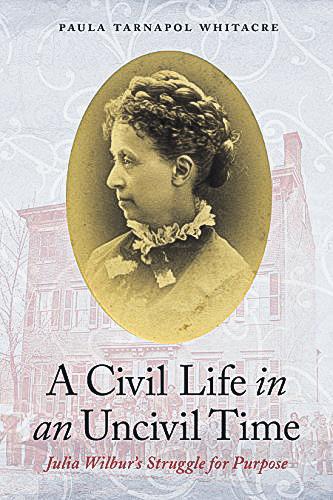
Reviewed by Wayne L. Wolf
Photographic Work on Western United States History
strongly supported the policies of the Lincoln administration.


Julia had found her calling in life. She became the first white woman in Alexandria to labor on behalf of freed people. Her commitment was total. She socialized with free blacks, prayed with them, and became their friends and colleague for the rest of her life. Most importantly she made a change in their lives, helping them in the first months of their transition to freedom, visiting them in hospitals and their homes, dispensing clothing and food, and advocating their fair treatment.
Hardship, Greed, and Sorrow–An Officer’s Photo Album of 1866 New Mexico Territory. Devorah Romanek. Photos, notes, bibliography, index, 165 pp., 2019. University of Oklahoma Press, www.oupress. com. $29.95

Reviewed by Tom Elmore
Mexico architect bought it from some New York rare book dealers. What happened to it between 1866 and its purchase is still a mystery. It was then donated to a Santa Fe archive. It is now a part of the Palace of the Governors Photo Archives. Though many of the images have appeared in other books, this is the first time the whole collection has been presented.
Whoever took these photos did an amazing job, especially given the harsh conditions they worked in. The strength of the images is that they show real life, something rarely shown in Hollywood westerns.
Julia Wilbur was a spinster from Rochester, N.Y., whose early life consisted of teaching, caring for family members, and dabbling in the abolitionist movement. From the age of 29 when she began teaching until she arrived in Alexandria, Va., at 47, she kept an extensive diary of her life to which she added until her death at age 80. Her early diary entries evidenced a woman searching for meaning to her life. She supported the Temperance Movement, attended lectures by notables Frederick Douglass and William Lloyd Garrison, advocated women’s issues like equal pay and voting rights, but did not wholeheartedly embrace any of these issues as her mission in life. That all changed in 1862 when she volunteered with the Rochester Ladies Anti-Slavery Society for an assignment in Alexandria, Va., ministering to the needs of newly freed slaves. The Civil War transformed Julia into an advocate for the thousands of contrabands flooding Union lines in Alexandria. For the next four years Julia struggled with the demands of her new vocation. She saw the misery confronting newly freed people and sought to alleviate their suffering. She lived in cramped quarters near the contraband camps, solicited help and supplies from military authorities, fought corrupt administrators, begged Northern connections for money and clothing, and
After the Civil War, Julia spent four years working for the Freedman’s Bureau and continuing her quest to end inequality. The next 25 years saw her working as a clerk in the Patent Office while continuing to help her sister and niece financially, attending lectures and social events, travelling, and taking up the cause of women’s rights. Yet it was her service to the contraband community and soldiers recuperating in Alexandria’s hospitals that defined her extraordinary life.
Paula Whitacre does a commendable job of weaving together the diary entries of Julia with historical events, social trends, and political roadblocks to equality that defined the Civil War and Reconstruction. What she has achieved is a well-researched and timely novel that serves as one woman’s story of finding herself in helping others less fortunate. The historian interested in social history this book should be added to their library.
Wayne L. Wolf is Professor Emeritus at South Suburban College and the author of numerous books and articles on the Civil War, particularly focused on the life of the common soldier. He is past president of the LincolnDavis Civil War Roundtable.
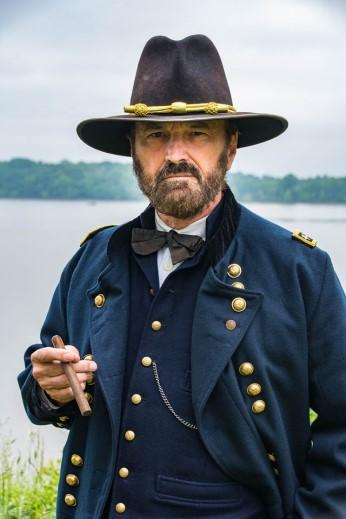

To say that the Civil War and Reconstruction west of the Mississippi River have not gotten their due is an understatement. While several good books have been written dealing with this aspect of the war, they are few and far between.


This makes Hardship, Greed, and Sorrow all the more important. The book contains 62 plate glass negative images made in 1866. Their original size was 9 x 7 inches. The names of the photographer(s), and the person or persons who originally annotated the photos or the reason for taking them are unknown. This collection, called Souvenir of New Mexico was first made public in the 1930s when a New
The images are arranged thematically and start with ousted Mexican President Benito Juārez and members of his cabinet. Subsequent images include U.S. Army officers, the town of Santa Fe, and the army posts Fort Union and Fort Summer in New Mexico, and El Paso, Texas. Most powerful are the images of the Navaho. These are the oldest known photographs of the tribe’s members. The looks in the Navaho’s faces tell the story of a proud people now subjugated. In their eyes one can easily see looks of despair, anger, and defiance.
The book is accompanied by a number of essays that give proper context and background on the photos. One essay tries to solve the matter of who took the photos, and makes a very good case for who did it.
For those interested in any aspect of western United States history, this is an excellent book to add to your collection.
Tom Elmore’s interest in western history was whetted when he spent a summer on the staff of Philmont Scout Ranch in Cimarron, New Mexico.
The Maryland Arms Collectors Assoc., Inc. presents


The “Original Baltimore” Antique Arms Show

Since 1955
North of Baltimore, York Road, MD. - Rt. 45 1,000 8-Foot Tables
March 20-21, 2021
Public Hours: Sat. 9 A.M. to 5 P.M., Sun. 9 A.M. to 3 P.M. Admission: $10.00
– Modern Handguns are Prohibited –Complete information on web site: www.baltimoreshow.com Or Call 443-497-9253
Known as the “CROWN JEWEL” of Collector’s Shows!
41 August 2020 CWN Digital Issues of CWN are available by subscription alone or with print plus CWN archives from 2012 at CivilWarNews.com Subscribe at CivilWarNews.com Want To Advertise In Civil War News? Email us at ads@civilwarnews.com Call 800-777-1862 CW N Civil War News Inside this issue: Day Remembrance Day, 2019, Gettysburg President Lincoln was wrongThe world will little note, nor long remember what we say here, but can never forget what they did here. – Abraham Lincoln, November 19, 1863.es and visiting monuments. A Gettysburg National Cemetery Although the numbers of reenacwhen Wikipedia estimated thereenactors; still impressive num-Battlefield Trust)
Maryland State Fairgrounds Timonium, MD
Bull Run To Boer War: How the American Civil War Changed the British Army.
By Michael Somerville. Photos, footnotes, bibliography, index. 384 pp. Maps. 2019, softcover. Helion and Company. www.helion.co.uk. $43.34.
Reviewed by John Michael Priest
Intense Research on Jefferson Davis
Jefferson Davis, Napoleonic France, and the Nature of Confederate Ideology, 1815–1870. By Jeffrey
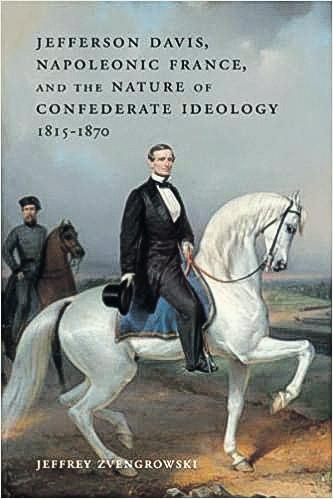
The high command viewed the American Army much like a colonial or yeoman militia force comprised of non-professional soldiers who fought well but did not use cavalry very effectively.
The Americans fought more like mounted infantry whenever possible but were not true cavalrymen. They used too much antiquated smoothbore artillery and were reluctant to switch to breech loading rifles. They often fought bloody battles without decisive victories.
To their credit, American engineers developed rifle pits, good skirmish tactics, and a balloon corps, which they did not properly utilize. The British actually, through observing the FrancoPrussian War and other European conflicts, had started to adopt more modern weapons, including machine guns well ahead of the United States.
I requested this book because, having never studied the war from a European perspective, the title intrigued me. The major purpose of this hefty, thoroughly documented, and researched book is to examine how much the American Civil War influenced the British Army up through the Boer War and to decide whether the British Army has been justifiably criticized for not adapting its tactics to meet those of 20th Century warfare. The author meticulously assessed four major topics that British officers reported upon while acting as observers in both armies: Artillery and Engineers; Cavalry, Infantry, and Aeronauts. Overall the British Army selectively adopted and adapted tactics from the Crimean War, the U.S. Civil War, the Austrian Wars, and the FrancoPrussian War to suit their needs in the various types of fighting that occurred within their empire, while not necessarily using them in regard to the professional army involved in a “civilized” war on the European Continent.
By examining the American Civil War through the writings of contemporary British military observers, Mr. Somerville clarifies the influence the American Civil War upon the British military. The observers did write about and discuss their observations and suggested changes to the British system but did not particularly change operation of the established British Regular Army.
The book, I believe, illustrates, in part, the difference between an isolationist United States and a nation involved in imperialism long before the United States existed. The United States did not become a global player until the Spanish American War. During the Civil War, Britain and, probably the rest of Europe, viewed the United States as a provincial country that the military establishment could supply with its military surplus while it modernized.
Bull Run To Boer War: How the American Civil War Changed the British Army thoroughly explains how the U.S. Civil War did not dramatically change the British Army as has been previously believed. This objective study places the impact of the Civil War upon the British Empire in a new perspective.

Mike Priest is author of Antietam: The Soldiers’ Battle (1989) and Before Antietam: The Battle of South Mountain (1992).
Zvengrowski.
Notes, index, 355 pp., Louisiana State University Press, Baton Rouge, LA, $55.
Reviewed by Thomas J. Ryan
sustain the breakaway states, Davis looked to the French rather than the British, because the latter espoused “white inequality as well as racial equality,”—both inimical to Davis’s outlook on life.
Once the United States became engulfed in the Civil War in April 1861 over the fundamental issue of slavery expansion into the western territories, the burden of leadership fell on Abraham Lincoln, President of the United States, and Jefferson Davis, President of the newly formed Confederate States. Davis brought with him years of experience as a public servant in congressional, senatorial, and governmental administrative positions. Over time he also developed a political philosophy resembling the ideology of the French emperor, Napoleon III.
As Jeffrey Zvengrowski describes in this illuminating study, Davis looked to France, not only as a model for the political agenda he desired to implement, but for diplomatic and substantive support in the effort to sustain a vulnerable nascent Confederacy against Northern resistance to secession. Davis’s viewpoints about the French governing philosophy date from his earliest days of involvement in the military and political arena.
The author describes the motivating force behind Davis’s early participation in the U.S. political process as a desire to prevent “treasonous Anglophile Republican abolitionists from perverting the federal government to impose inequality among whites and racial equality across the Union.” Davis and his fellow Democrats viewed themselves as “conservatives” who were preserving “the true nature of the American nation.” As a result, in searching for an ally to help
Zvengrowski lays the groundwork with a look at a “pro-Bonaparte Democratic tradition” in the U.S. espoused by Southern luminary John C. Calhoun who reformed West Point’s curriculum along Napoleonic lines in the early 19th century. Calhoun, a slave holder and hard taskmaster, mentored Davis in opposition to the British attempt to “promote racially egalitarian abolitionism in the Americas.” Davis, labeled a “disciple” of Calhoun, claimed the political mantle of “that distinguished statesman” in the 1850’s by urging the South toward industrial and agricultural development, and called for slaves to be employed in factories and mines. Davis also espoused U.S. expansion through acquisition of Cuba and the Yucatan Peninsula.
Years prior to the Civil War, Davis warned against Northern abolitionism that he predicted would lead to shedding blood. As Secretary of War in the Pierce Administration, he advocated moving Indians to western lands and developing transcontinental railroads to help stabilize control of California threatened by the British who were seeking to dominate commerce in the Pacific. However, he opposed reopening the international slave trade that would cause the country to be “overrun with the African race.” Davis and his supporters did not help the Northern Democratic candidate for president in 1860, Stephen A. Douglas, which led to Republican victory and “destruction” of the Union.
The author addresses Davis’s preference for the politics of Napoleon III’s France, particularly favoring “white equality and supremacy.” Yet, Davis denounced the “outrages” of the French Jacobins, who were on the far left politically, and French intrusion in the Americas while, at the same time, they were promising to respect the Monroe Doctrine. However, those of French descent living in Louisiana, supported the growing power of France.
Zvengrowski goes into considerable detail about French influence in the U.S. leading up to the Civil War and its impact on Davis’s political leanings, and addresses the issues involving white supremacy and equality among whites in the Confederacy that became more problematical after
Lincoln issued the Emancipation Proclamation in 1863. Yet, as the war turned in favor of the North, Davis had to deal with the sensitive issues of organizing “corps of negroes” initially as laborers for military purposes, with later consideration given to employing them in combat and awarding freedom, but not equality, for their service to the Confederacy.
Along the way, Davis solicited Napoleon III’s help in his struggle to prevent the Confederacy’s destruction. The French foresaw potential for monopolizing global cotton exports through an alliance with the South, along with commercial advantages in its competition with Great Britain and other European countries. Davis also cheered when the French captured the border town of Matamoros, Mexico, opening a trading port for the South that was otherwise hampered by the Northern blockade of its Atlantic and Gulf ports.
The author writes about the intricacies and intrigues on the international scene as France competes with Great Britain, and Russia plays a role as well by aiding the U.S. blockade of the South. Davis’s attempt to gain recognition from France and/or England is another topic of discussion, while diplomatic complications arise when the Confederacy contracts for construction of warships and sale of munitions and other products from European countries.
As the Confederacy’s hope for success against the Northern forces faded in late 1864 and early 1865, Davis had to face reality. His desire for French intervention on the Confederacy’s behalf never materialized, and France lost its hold on Mexico in 1866. Although from the North’s perspective, Napoleon III had been “fully in sympathy with the Rebellion,” this sympathy never translated into substantial support. As a result, Davis, became a man without a country after the American Civil War ended, decided against being a resident of France which, in his eyes, was in decline and its citizens reminded him of “our neglected braves and their unprovided orphans” in the South.
Jeffrey Zvengrowski closes with a summation of the complex events leading to and during the American Civil War with European countries, especially France and Britain, playing key roles. Davis, as a disciple of Calhoun, believed that the Union would achieve its “Manifest Destiny” by forging an alliance
42 CWN August 2020 Digital Issues of CWN are available by subscription alone or with print plus CWN archives at CivilWarNews.com
“the U.S Civil War did not dramatically change the British Army…”
with France against Great Britain. While Davis supported the French incursion in Mexico to restore white rule in that country, France denied diplomatic recognition that may have facilitated the Confederacy’s independence from the North.
Jefferson Davis, Napoleonic France, and the Nature of Confederate Ideology, 1815–1870 is an intensely-researched tour de force that enhances our understanding of both the motivation for Southern secession from the Union, and Jefferson Davis’s political philosophy that was opposed by many citizens, not only
in the North, but in the South as well. Be forewarned, this is a meticulous study with multifaceted themes, but the resilient reader will be rewarded.
Thomas J. Ryan is author of the multiple award-winning books
‘Lee is Trapped and Must Be Taken’: Eleven Fateful Days after Gettysburg, July 4-14, 1863 (with co-author Richard R. Schaus), and Spies, Scouts, and Secrets in the Gettysburg Campaign: How the Critical Role of Intelligence Impacted the Outcome of Lee’s Invasion of the North, June-July 1863.
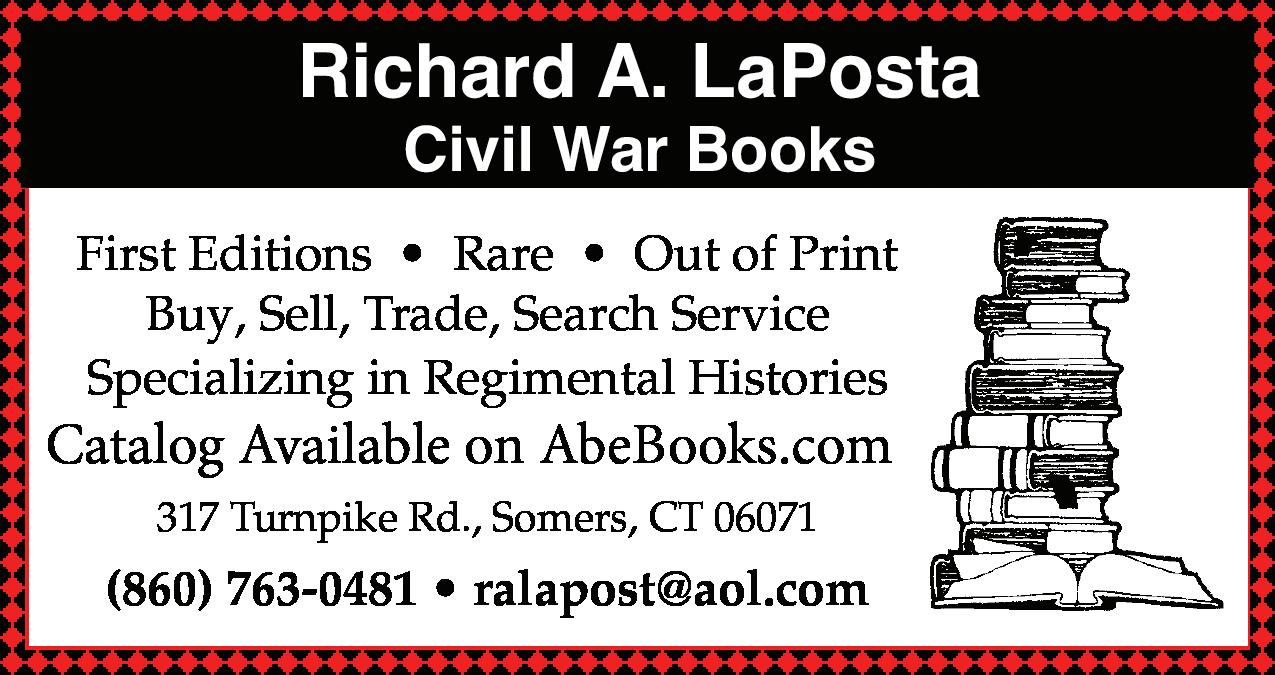
Unusual Prison Life Topics
Living by Inches: The Smells, Sounds, Tastes, and Feeling of Captivity in Civil War Prisons
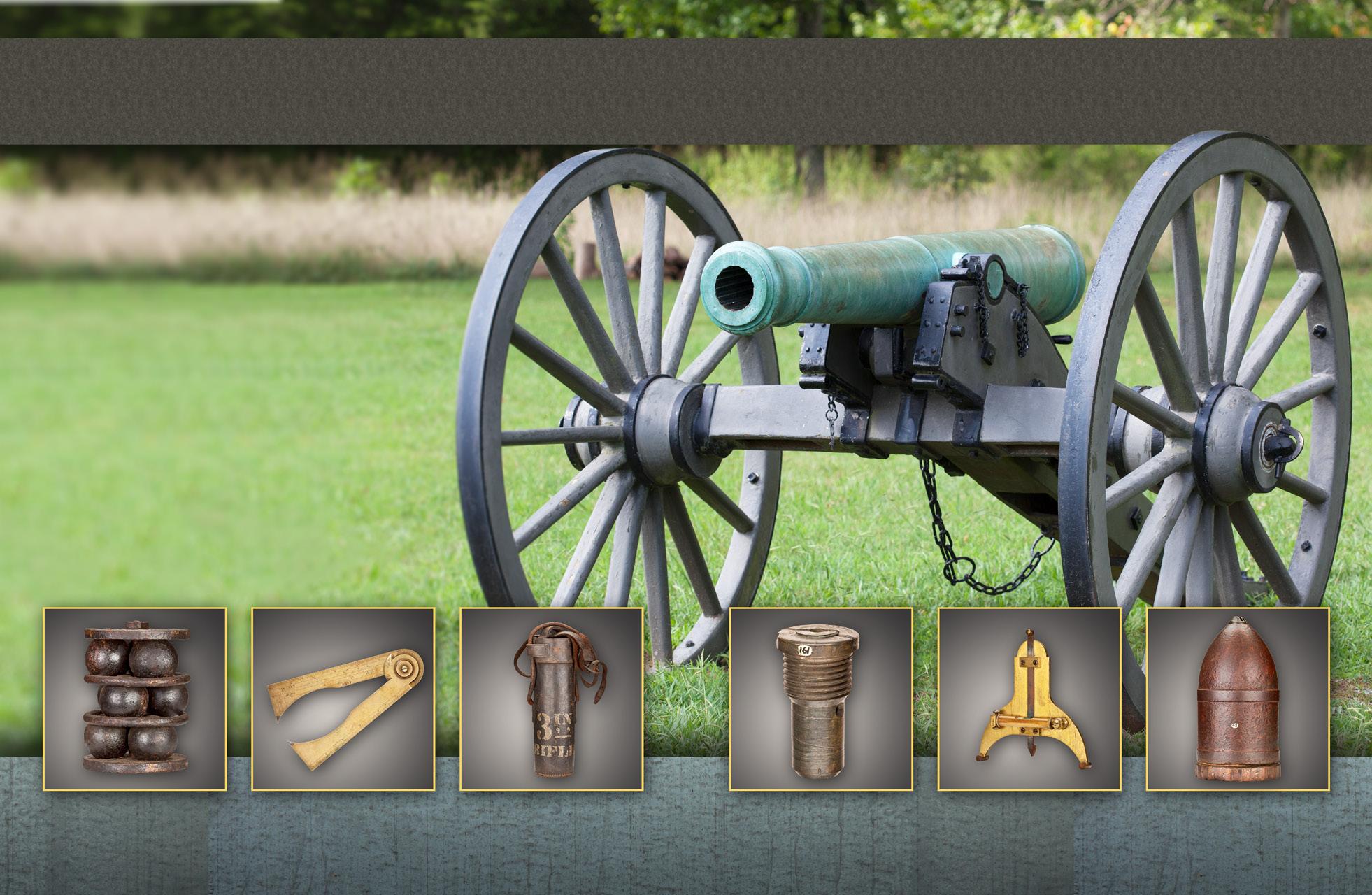
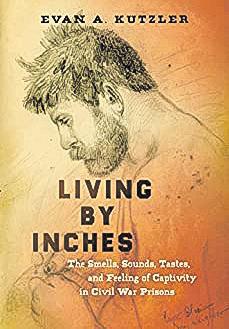
By Evan A. Kutzler. Photos, notes, index, 208 pp., 2019. University of North Carolina Press, www. uncpress.org. Softcover, $29.95.
Reviewed by Ken Williams
Much More Than History
German Americans on the Middle Border: From Antislavery to Reconciliation
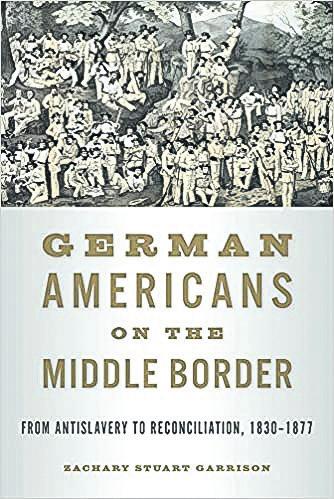
study of political ideology shaping an area unsure of its own identity.
As I sit here writing this review, we are in the midst of a pandemic where we are all being urged to wash our hands as often as possible. But imagine not being able to wash not just your hands but everything, body, clothes. Imagine a stench you can smell miles away and that permeates your existence. Imagine hunger that haunts your dreams, if you can sleep.
Evan Kutzler, assistant professor of history at Georgia Southwestern State University, brings this all to light in unsettling but fascinating detail in his
work on the sensory experience of Civil War soldiers both North and South. Working from a basis in sensory history, the author weaves a narrative drawn largely from diaries kept and letters often never mailed. This gives it more of the immediacy we desire than relying on memoirs written sometimes decades after the war which either gloss over the difficulties or magnify them out of proportion.
Kutzler also gives us a sense of what it meant to be a man, or sometimes a woman, in 19th century America. Unlike many preconceptions, cleanliness was often seen as next to godliness; the lack of it in others, and worse, ultimately the lack of it for oneself was an experience that scarred immediately, and for many, permanently as well. I find that perhaps those boys of ’61 were not all that different in their attitudes toward cleanliness from many of us today.
As our nation struggles to manage a crippling outbreak, I take heart in that I am not “Living by Inches.” Highly, highly recommend this book.
Kenneth D. Williams is a graduate of Gettysburg College and West Virginia University. He was a park ranger at Gettysburg National Historic Site and is a long-time student of the American Civil War. He is currently a Museum Educator at Frank Lloyd Wright’s Fallingwater, an UNESCO World Heritage property.
1830–1877.
By Zachary Stuart Garrison. Illustrations, notes, bibliography, index.
213
pp., 2020. Southern Illinois University Press. www.siupress.com. Softcover. $30.
Reviewed by Mike Shovlin
The German Americans came in large numbers to work the lands opening up to settlement in the Midwest.
Their reasons for leaving the old country did not blend well with the culture of a slave holding society. Garrison does a good job pointing out how this difference led to many actions and reactions. Formation of the Republican Party was helped by the liberal convictions of the new German American citizens. Guerilla warfare in many cases was directed at these new residents leading many to enlist to fight for freedoms they were denied in Europe.
Garrison’s deep research behind the points he makes leads the reader to an understanding of not what happened but why. This is not just a history book but one that could be used in political science or sociological studies. The book follows the trends of the
population changes pre and post war. Radical Republicanism later turning to a more moderate approach during the Reconstruction is well explained in these pages about a region that is somewhat ignored in many Civil War publications.
Civil War Roundtables in the Missouri, Kentucky, Southern Illinois, and Indiana areas would find Garrison’s work a fascinating topic to discuss. Non-Civil War students would find this book interesting in dealing with how cultural migration affected areas in the American political thought.
I recommend this book for Civil War enthusiasts. It is refreshing to read about the deeds of the German American soldiers beyond the Eleventh Corps.
Mike Shovlin is a graduate of Westminster College where he majored in history. He is currently the lead at the Rupp House History Center for the Gettysburg Foundation.
It is a joy to discover in the first few pages of a book that the author is taking you on a journey to an area that has not been part of your previous studies. This reader had preconceived thoughts about the German population that settled in central or western Pennsylvania or eastern Ohio. This background led me to picture a population of non-violent, politically inactive families making their living off the land and not playing any active part in this time period.
Garrison captured my attention in the introduction and had me sitting up straighter as I turned the pages. Highlighter in hand and also marking pages with paper slips, I slipped deeply into a

43 August 2020 CWN
Publishers/Authors Updated Information Send your book(s) for review to: Civil War News 520 Folly Road, Suite 25 PMB 379 Charleston, SC 29412 bookreviews@civilwarnews.com Buying, Selling and Brokering Jack Melton 520 Folly Rd, Suite 25 PMB 379 Charleston, SC 29412 jack@jackmelton.com 843-696-6385 Let me help connect you with a buyer or seller. I specialize in cannon, projectiles, fuses and wrenches, implements, sights, gunner’s equipment, tools, and other artillery related equipment. From single items to collections. Finders Fees Paid. Purveyor of Original Artillery Items
Fishing Creek Confederacy in Pennsylvania 1864
 by John A. Punola
by John A. Punola
It was early May and I planned a trout fishing trip to the Bloomsburg, Penn., area to do some trout fishing in upper Columbia County. My wife Nancy, also my outdoor photographer, accompanied me while I explored Fishing Creek trying to catch some rainbow trout that inhabited this famous stream. To finish our trip we would spend a day attending the annual Civil War Weekend at Bloomsburg Fairgrounds. It was an ideal time to visit the area, fish for trout, or attend festivities at the Civil War Weekend.
We traveled to Bloomsburg, Penn., from our home in Madison, N.J., and when we exited at Bloomsburg, we stopped to refill the gas tank, plus enjoy a cup of coffee with our sandwich. The lady in charge asked if we were in the area for the weekend, when I told her yes, she said “That’s nice, if you attend the Civil War Weekend, I think our men of the Fishing Creek Confederacy are supposed to be there.” I knew then our plans were going to change. I had no previous knowledge of the historical significance of the Fishing Creek Confederacy, so now we formulated plans to visit the town of Benton, Penn. All we had to do to reach the town was to follow Route 487, which paralleled Fishing Creek all the way to Benton.
The saga of the Fishing Creek Confederacy’s resistance to the draft
is virtually unknown to history buffs knowledge of the Civil War, unless you live in Columbia County, Penn. Let’s begin with the surrender of Fort Sumter in Charleston, S.C., after shelling by Confederate artillery. The Union now faced the possibility of war with its Southern states and was woefully unprepared. The standing Union regular army numbered about 30,000, with the majority of its manpower either on the western frontier or based to defend Washington, D.C. The Union’s reservoir of service men lay in the trained and maintained state militias that could be called by President Lincoln to join the regular Union army; this was done in short order. The call went out to the states to begin activating their militia and prepare for active duty, designated reporting stations were quickly assigned, and militia units prepared to report for duty.
On April 15, 1861, Lincoln gave the order for 75,000 men to serve for three months, with options of extension if needed. The Pennsylvania share of the quota was fifteen regiments, mixed branches. Immediately after the surrender of Fort Sumter, there was a sudden surge in patriotism to defend the North and save the Union; Pennsylvanians quickly filled their prescribed quotas. The prevailing thought was that the 75,000 addition to the main army would soon defeat the Southern states who dared attack the Union, and they would
quietly return to their home states. Quick and efficient was the popular view in Pennsylvania and men were anxious to march off to perform their duty. The North had overall advantages over the South except for one category, military leadership. The Southern states were home to eight military schools producing leaders. The top United States Military Academy cadets at West Point, N.Y., were bright, skilled Southern students, who soon resigned and departed for home to join their state’s Confederate units.
On July 21, 1861, the first full scale battle of the Civil War took place at Manassas (Bull Run), Virginia. The Union army was severely defeated by the Confederates and retreated to Washington, D.C. Had Jefferson Davis, President of the Confederacy, taken the advice of his generals, Johnson and Beauregard, it was possible the Confederate army could have pursued the retreating Union army all the way to Washington, D.C., and seized the Union’s capital, but they chose not to do so. Confederate president Jefferson Davis stated he did not want a prolonged war and thought Abraham Lincoln would agree to a conference to settle their differences. Instead President Lincoln chose a hasty military build up to subdue the newly declared nation.
Pennsylvanians were shocked and angry by the defeat at Manassas and Governor Curtin was concerned with the possibility of a costly and prolonged war. The first two years of the war resulted in a string of Confederate victories despite the heavy advantages of the Union manpower, supply, and equipment which resulted in several leadership changes by Abraham Lincoln but no improved results on the battlefields. Things were getting bad on the home front; resistance and discontent grew along with public impatience, and concern about the horrific losses in men and material. Citizens along Fishing Creek were not just concerned, they disagreed with Lincoln’s conduct of the war and were openly talking about withdrawing their support and participation.
Still looking for a major victory, the Union Army of the Potomac met the Confederate Army of Northern Virginia at Manassas again on August 28-30, 1862. The results were the same, another victory by the Confederates; Abraham Lincoln was putting more pressure on General George McClellan for a badly needed victory against the unbeatable Robert E Lee and his Confederate army. The two armies met Sept. 17 when the massive Battle of Antietam, resulted in such a bloodbath, it was difficult to claim a victory. Robert E. Lee wisely
chose to withdraw from Maryland and took his army back to Virginia. McClellan proclaimed victory, and on September 22, President Lincoln issued his awaited Emancipation Proclamation granting freedom to all slaves in Southern States.
The year 1862 ended with another horrific disaster in December when the Confederate’s dealt the Union another major blow at Fredericksburg, Va. In January 1863, President Lincoln made his speech to the government and declared the war to save the nation was over; the objective was now to free the slaves from their bondage throughout the Southern states. He also announced the imminent start of a military draft, badly needed to replace the continued high losses from battle casualties and a high desertion rate.
The impending draft call up was not good news in the state of Pennsylvania. There was talk and rumors of Confederate scouts in the state plus agents of the Knights of Golden Circle supposedly active in Western Pennsylvania, the Reading area, and also Columbia County in northern part of the state. Draft
eligible men around Fishing Creek vowed not to report for any active service; this geographic area later declared itself the Fishing Creek Confederacy. Congress finally enacted the draft law on March 3, 1863, and immediately there were rumors of armed action threatened by draft resistance men and Confederate sympathizers. The rumors proved just that, no violence happened, just more idle gossip.
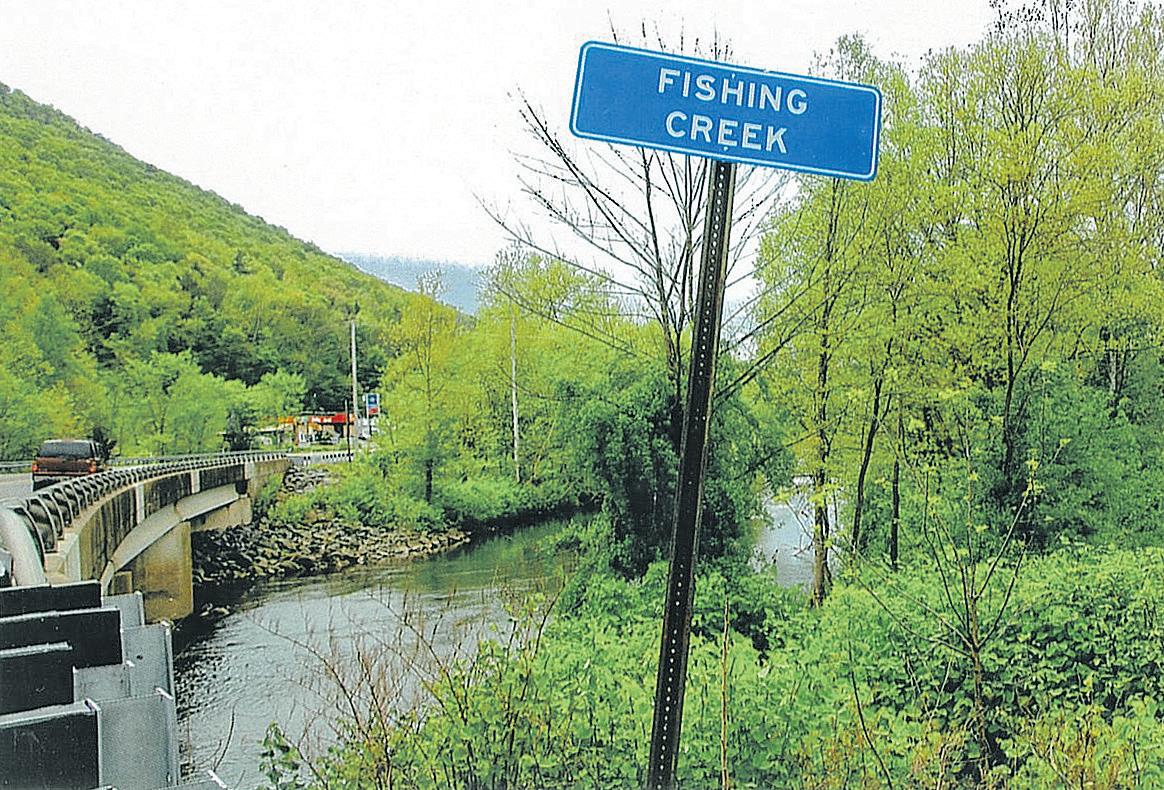
Men of the Fishing Creek Confederacy had no intention of answering the call when the draft quotas reached Fishing Creek, and the wait for the call up could arrive anytime. The draft call for Columbia County arrived in mid-July 1864 when 618 men classified as selected received a notice to report on a designated day. True to their anti-draft stand, 463 draft eligible men of Fishing Creek Valley did not answer the call, and had no intention of changing their minds. Now it was a matter of how long the Union would wait before using force to round up the Fishing Creek Rebels. The men of the targeted area were tough and skilled with firearms, with a great

44 CWN August 2020
This large impressive metal sign erected by Pennsylvania Historical & Museum Commission 2009, appears on Route 487, Main Street Benton, Penn.
There actually is a Fishing Creek and it does exist as a popular trout fishing stream. The stream is clearly marked with colorful signs at various locations.
The beautiful Fishing Creek landscape in Columbia County, Penn., home of the Fishing Creek Confederacy which existed during 1863–1864 before being decimated by superior Union forces.
knowledge of the forest.
I drove north on Route 487 closely following Fishing Creek and passed thru Benton. I had called my fishing friends, Barry and Cathy Beck, who have long family ties to the area and live and operate a famous trout fishing business in Benton. We arranged to meet the Becks for a casual lunch where I could relax and learn some history from people who live in the heart of the Fishing Creek Confederacy. I took particular interest in the beauty of the area and noted trout fishermen catching and releasing rainbow trout. The developing story about the Fishing Creek Confederacy diverted my attention. Instead of trout fishing I was now eager to learn more about the Civil War.
In the summer of 1864 the Civil War, many parts of Pennsylvania were subjected to military raids wherein citizens were arrested by Union soldiers, imprisoned in military prisons, then tried by military commissions in direct defiance of the constitution of the United States. States’ rights were violated as well as common law, which provided trial by jury in civil courts for all who were not specifically in the Union Army or Navy. Pennsylvania suffered Union military raids in Berks, Clearfield, Columbia, Pike, and Schuylkill Counties. The Columbia County raids targeted the Fishing Creek Confederacy because one vicious imaginative charge against the inhabitants of that peaceful region was that a conspiracy to support the Southern cause existed there. There is no proof that any connection ever existed between Richmond, Va., and Benton, Penn.
Before the Civil War, the people of Fishing Creek lived in a high state of prosperity, refinement, and independence. They were descendants with ties to relatives from the Revolutionary War. They were intensely patriotic and took an intelligent interest in their public affairs.
After the outbreak of the Civil War,
and a Republican, Abraham Lincoln, was elected president, their interest greatly intensified. These farmers and business men listened to political speeches of Republicans and Democrats. They read all the newspapers and pamphlets they could find, and formed private clubs to discuss the merits of the two parties. They were solid, loyal Democrats with few exceptions and not pleased with the war policy of Abraham Lincoln.
Early in August 1864, Lieutenant James S. Robinson and a half dozen men from Luzerne County rode into Columbia County. Without warning they challenged a man they met along the road. The challenged man was ordered to stop; when he refused he was fired upon. The man defended himself and returned fire, hitting Lieutenant Robinson who later died of a gunshot wound. Who fired the fatal shot remained a mystery until twenty-five years later, when a neighborhood quarrel about a boundary line, resulted in serious charges being lodged with the authorities. An individual named Eli Young was arrested and tried for the shooting in Luzerne County Courthouse. He was declared innocent on grounds of self defense, and the charges dropped, case closed.
Another serious charge lodged against Columbia County citizens as a reason for the invasion of Fishing Creek, was that the citizens had organized a secret society to resist the draft; its name was the Knights of the Golden Circle. This false charge was presented at a Military Commission in Harrisburg, Penn., where a number of witnesses testified under oath for both the government and the defendants that the organization was not secret, being open for anyone interested in attending. The only secret part was a password or sign such as those common in all lodges, and that it was a political club, known as a Democratic Lodge or Club. The name, Knights of the Golden Circle, was applied only to those who wished to malign members at the time of the arrests and trials. For the record, the KGC had dissolved at its last meeting in May 1863, well over a year before the military action began.
produced any proof, but there was plenty of idle talk minus facts.
Exaggerated statements were made over and over so often and so loud that those who made them may have in time, come to believe a major part of what they were stating. Certainly, outsiders were led to believe that conditions within Columbia County needed an investigation by the military. Immediately after the shooting of Lt. Robinson, the incident was lodged in both Harrisburg, Penn., and in Washington, D.C., and there was concern that Union troops would soon be appearing in Columbia County. Union squads were active in other parts of Pennsylvania searching for draft evaders but were not finding any. The arrival of Union troops into Columbia County was anticipated. Would the draft evaders scatter into the familiar forests, or consolidate for a battle?
On Aug. 13, 1864, the first detachment of troops arrived in Bloomsburg. Others came later so that within a few days, the armed force numbered one thousand men, with Major General Darius Couch, Commander of Dept. of Susquehanna, in command. The combined force camped on the Fair Grounds near Bloomsburg. It consisted of a company of cavalry, a section of the Keystone Battery from Philadelphia, plus a battalion of infantry. Finally, a battalion of the Veteran Reserve Corps was added to the camp, making the Army of Occupation complete.
This well-trained unit with one thousand men, supplies, and equipment was ready to march up the Fishing Creek Valley. The impressive show of force shocked and frightened the village people in its path. Onward past scattered homesteads, in search of rifle pits that were never dug, to arrest draft evaders, who had not deserted, to display its proud might against a mirage that did not materialize, against a populace that just wanted to be left alone.
been scheduled but for the threatening presence of the military force. It was a natural and spontaneous result of the alarm and excitement felt by innocent and indignant men who heard reports that this armed force was coming into their neighborhood to burn, destroy private property, and make arrests.
Older and wiser members of the Fishing Creek community were called to the meeting and advised that all men assembled there should return to their homes and that they should offer no resistance if the soldiers came, but should go on about their business and attend to their duties as citizens. They were told that if anything did happen to them they had the law to fall back upon and that their neighbors would not let them suffer. The meeting quietly dispersed and the men returned to their homes. That was all there was accomplished at the Rantz Meeting.
On Aug. 21, the remaining troops at the Bloomsburg Fairgrounds, broke camp and traveled to a new encampment in Coleman’s Grove, just outside Benton. During the ensuing week scouting parties were sent forth searching, unsuccessfully, for evidence of an armed insurrection. Finding nothing, the troops looted pig pens, chicken roosts, and ripe cornfields.
On Aug. 28, Major General George Caldwalader arrived to assume command. Squads of troops were posted at various positions throughout the northern townships and, at the break of dawn, the signal was given, and 100 doors were pounded upon as occupants were aroused from their beds, and arrested without due process of law, in defiance of their constitutional rights.
General Caldwalader marched his thousand troops northward to the head of Fishing Creek and made camp at the foot of the mountains that shut in the narrow and beautiful little valley. Troops began an intensive hunt for the fort with its two field pieces, its big brass cannon, plus five hundred bold, bad men awaiting a battle on North Mountain. General Caldwalader was an officer of experience and military reputation, and that search of the upper end of Columbia County was made with thoroughness and precision.
The soldiers who had such an easy, pleasant time down in the lower valley, now had to climb and claw their way up steep ravines, over rocks and stones, windfalls, thru briars, and almost impossible laurel thickets in the wilderness of the upper end of Columbia County. They scoured the region and into Sullivan County. For their efforts, the troops found two old bear traps, a place where huckleberry pickers had a picnic, and nothing else. They never located the phantom fort, the twin cannon, the rifle pits, or any hostile draft resistors.
John and Nancy Punola, were warmly welcomed by the local population on the occasion of their visit to the Fishing Creek Confederacy.
The final charge, the crowning achievement in the fanatical version, was the imaginative claim that there was an armed citadel, a real fort, built on the rocky ramparts of North Mountain, complete with entrenchments and a large number of well armed men with stores of ammunition. There was also supposed to be a big bronze cannon, dragged up those rocky trails and steep precipices, but from where? No one could say where the cannon came from, maybe smuggled all the way from the Confederates in Richmond, Va. Rumors were rampant about a well manned fort with cannon; no one
News of the Union soldiers’ arrival traveled swiftly up the Fishing Creek Valley. The inhabitants were told by some they would be arrested, placed in prisons without trial, and their buildings destroyed by fire. The coming of a military force aroused excitement and turmoil throughout Columbia County especially in the northern townships where the expedition was known to be headed. On Aug. 14, the day following the arrival of an advanced detachment in Bloomsburg, a meeting of Fishing Creek residents was held between Stillwater and Benton.
This was the famous Rantz Meeting, sometimes cited as the main cause of the military invasion. The troops did not come into Columbia County because of the Rantz Meeting. The coming of the troops caused and produced the meeting. The meeting would not have
The prisoners were marched to a church near Benton, where they were taken before an officer who desecrated the pulpit by standing therein. The proceedings were hurried and brief. About half the prisoners were discharged without any reason being given for either their arrest or discharge. Forty-four were chosen, taken on foot to Bloomsburg, placed on a train, and conveyed to Fort Mifflin near Philadelphia. The prisoners were without any food until they arrived at Philadelphia.
At Fort Mifflin, a notorious, cruel camp, they were herded into an underground imperfectly ventilated, rat infested, bombproof. They were denied air, exercise, or the light of day, denied free correspondence with friends or counsel, denied knowledge of any charges against them or the names of their accusers. The imprisoned men spent several months of misery confined to Fort Mifflin, before they were released and returned to their Fishing Creek area homes.
After the roundup was complete, attention was directed to the plan to punish the arch conspirators.
General Caldwalader terminated the search and marched his troops back to Bloomsburg, where he declared the whole project a farce. Perhaps it was a farce for the general and his soldiers, and for the malignant false reports that had urged Caldwalader onward; it was a grim scenario for forty-four sick and suffering innocents quartered at Fort Mifflin, and for the wives and families who were daily terrorized by the Union soldiers. Civilians were victims of cruel treatment and structural damage similar to the conduct of Union troops against unprotected citizens down South in the real Confederacy. The occupation violated all the rules of common, decent treatment of captive civilians.
Truly a shameful time in history of Columbia County during 1864. After the end of the Civil War, in 1866, the United States Supreme Court reviewed the case of the prisoners and declared the arrest and non-trial of the Fishing Creek civilians as unconstitutional; as is noted on a historical marker along Route 487 in Benton.
The Fishing Creek Confederacy was short lived, no major battles, no winners, or losers. Yet the storied tales of the frustrated Union soldiers doing their best to find and capture draft deserters remain part of the romantic culture of the Fishing Creek Confederates whose descendants are still a part of the community, and would never think of moving to any other place in the Union.
The Columbia County Historic & Genealogical Society, and the Press Enterprise newspaper, both of Bloomsburg, were valued assets in our search for Fishing Creek Confederacy information, and we thank them for their generous time and assistance.

45 August 2020 CWN
The 2020 Civil War Dealers Directory is out. To view or download a free copy visit: www.civilwardealers.com/dealers.htm
The 2020 Civil War Dealers Directory is out. To view or download a free copy visit: www.civilwardealers.com/dealers.htm








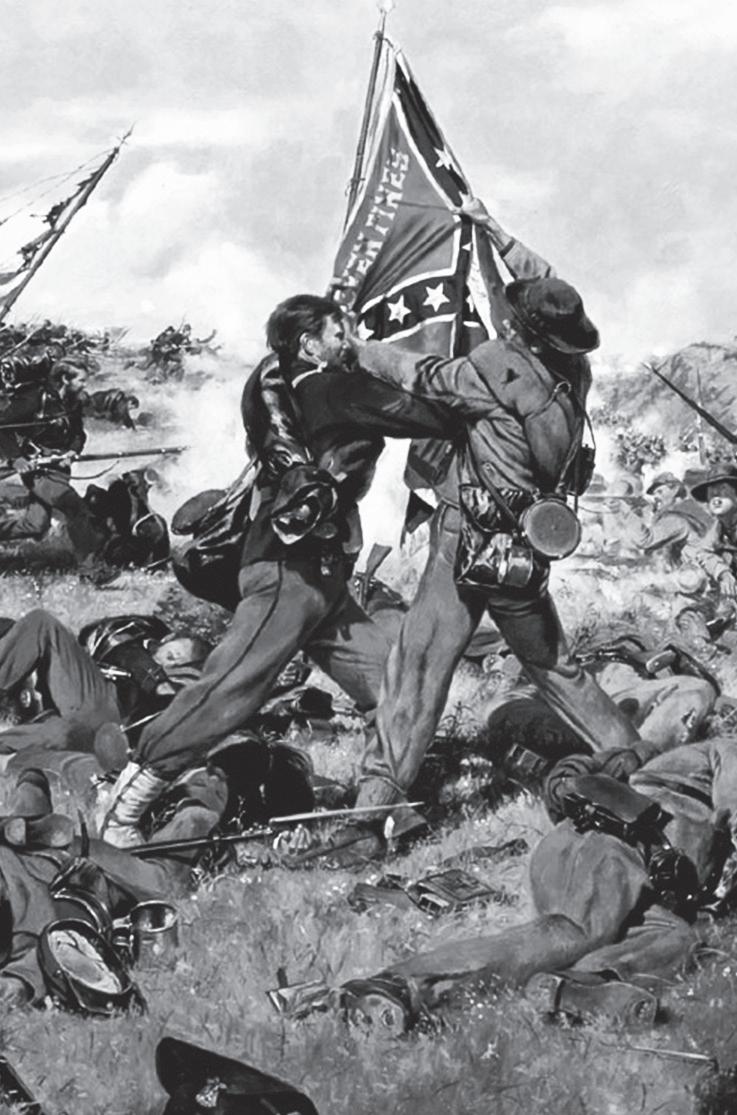




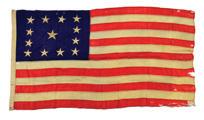





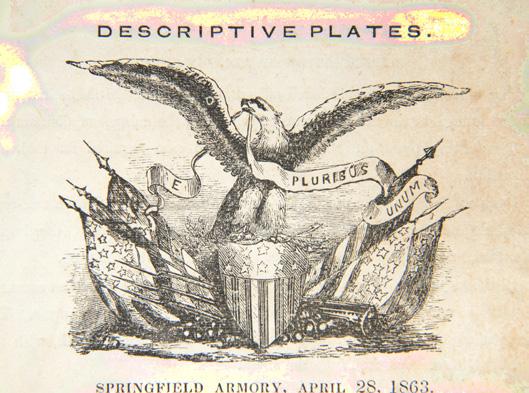

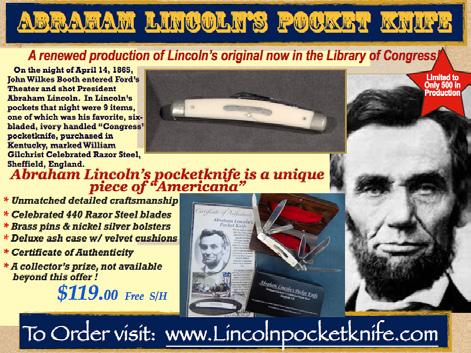






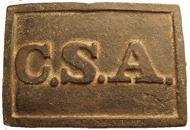

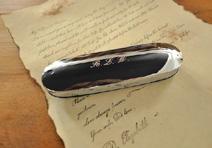







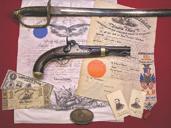


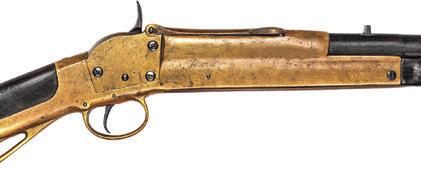







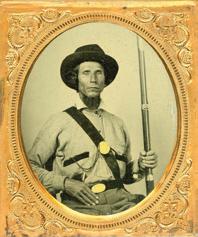

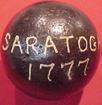


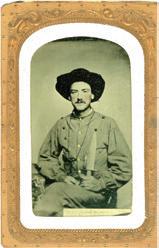








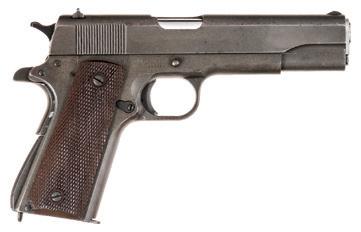













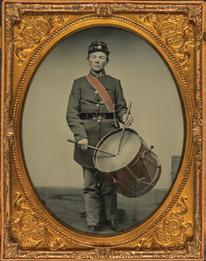

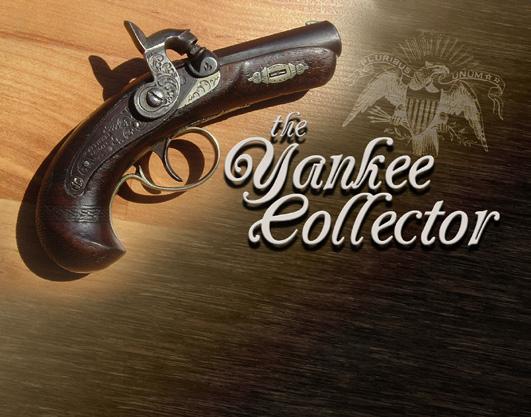



















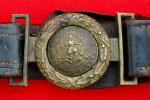



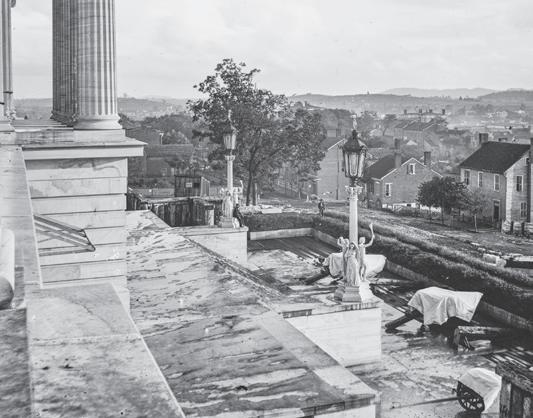








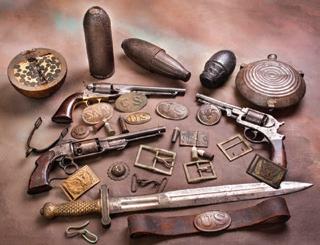
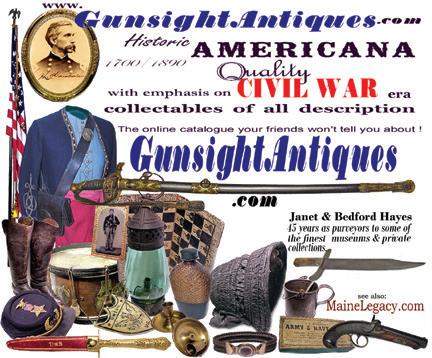










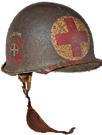

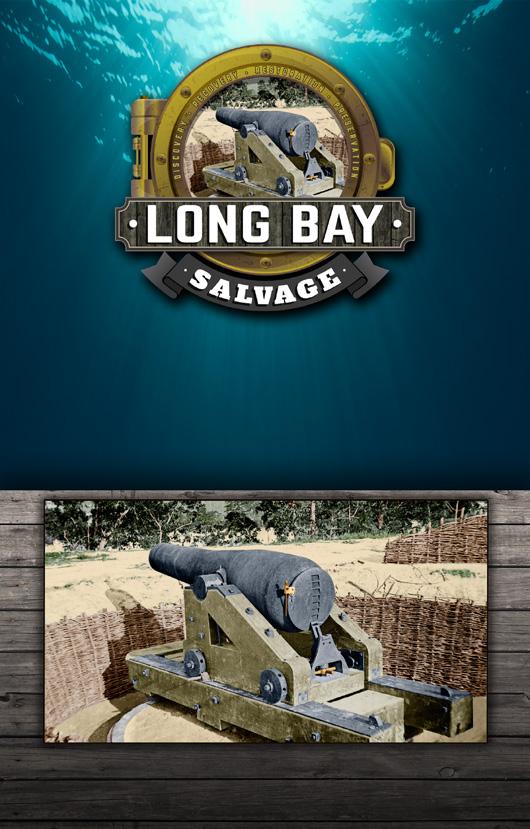



46 CWN August 2020 CivilWarShop.com Offering the Finest Investment Grade Military Memorabilia since 1981 Buy – Sell – Trade Certified Appraisal Services Life Member Company of Military Historians Lynn and Will Gorges, Proprietors 3910 US Hwy. 70 East New Bern, NC 28560 (252) 636-3039 • civilwarshop@gmail.com www.CivilWarShop.com Long Bay Salvage LLC specializes in the recovery and restoration of authentic Civil War Cannon with an emphasis on 10-Inch Columbiads, what has become a rare piece of Civil War history. Long Bay Salvage also works with historical entities (government and private) to recover and conserve large historical artifacts with a specialty in large field and naval artillery pieces. Glenn Dutton 770-351-7565 Rufus Perdue Perdue 843-315-9818 PLEASE CONTACT US FOR MORE INFORMATION www.LongBaySalvage.com Promoters of Quality Shows for Shooters, Collectors, Civil War and Militaria Enthusiasts Military Collectible & Gun & Knife Shows Presents The Finest Mike Kent and Associates, LLC • PO Box 685 • Monroe, GA 30655 (770) 630-7296 • Mike@MKShows.com • www.MKShows.com Northwest Georgia Trade Center 2211 Dug Gap Battle Road Dalton, GA 30720 February 1 & 2, 2020 Chickamauga (Dalton) Civil War Show Williamson County Ag Expo Park 4215 Long Lane Franklin, TN 37064 December 5 & 6, 2020 Middle TN (Franklin) Civil War Show l Shiloh Buying & Selling Authentic Civil War Artifacts 2405 Oak Grove Road Savannah, TN 38372 731-438-3541 ShilohRelics.com History@shilohrelics.com owner Rafael Eledge .com Dealing in the Finest Authentic Militaria Since 1995 with an Emphasis on the American Civil War Pistols, Muskets, Carbines, Rifles, Bayonets, Swords, Uniforms, Headgear, Belt Buckles, Cannon, Buttons, Bullets, Artillery Implements Etc. MidWestCivilWarRelics.com Bowie Knifes, Civil War Swords, Confederate D-guards, Antique Firearms, Dug Relics, Buckles & Belts, Identified Relics, Letters, Documents, Images, Currency, Uniforms, Head Gear & Flags. 3500 Shacklett Rd • Murfreesboro, TN 37129 tom@stonesrivertrading.com • (615) 336-2188 StonesRiverTrading.com Tom Hays Proprietor We carry all types of relics, dug & non-dug, Confederate & Federal. 100% Guaranteed. A strong emphasis on dug relics, but also a full line of non-dug relics of all types. Over 30 years experience with a full time, online store since 1997. We also have a shop located five miles from Stones River National Battlefield that is open by appointment. www.CollegeHillArsenal.com Tim Prince College Hill Arsenal PO Box 178204 Nashville, TN 37217 615-972-2418 Mid West Civil War Relics MidWestCivilWarRelics.com Allen Wandling Phone: 618-789-5751 Email: awandling1@gmail.com Museum Quality Civil War Union & Confederate Artifacts! We handle the Best Antique Bowie Knifes, Civil War Swords, Confederate D-guards, Antique Firearms, Dug Relics, Buckles & Belts, Identified Relics, Letters, Documents, Images, Currency, Uniforms, Head Gear & Flags. Preston Bain Nashville, TN (615) 397-5186 www.NashvilleRelics.com Nashville Civil War Relics “Old times there are not forgotten” Coles Civil War Shop.com Come by and see me at the shop or place an order online. email hmcole2@comcast.net Mac Cole 13119 River’s Bend Blvd. Chester, Va 23836 wk - 804-681-0945 cell-804-314-9940 Hours Mon - Fri 10-5 Sat - 10-3 P.O. Box 342 Thompsons Station, TN 37179 615-585-0115 Email: brubon2@bellsouth.net Franklin Relics www.AmericanRelics.net Allen Phillips 1014 Reservoir St., Suite B Harrisonburg, VA 22801 A P.O. Box 342 Thompsons Station, TN 37179 Email: brubon2@bellsouth.net Franklin Relics Specializing in Accoutrements, Edged Weapons, Firearms and Uniforms FranklinRelics.com Bruce Hohler Proprietor Specializing in Buttons, Buckles, Currency, Hat Devices and other Military Artifacts. www.AmericanRelics.net Allen Phillips 1014 Reservoir St., Suite B Harrisonburg, VA 22801 American Relics Phone: 540-476-1969 Email: americanrelicsnet@gmail.com www.CivilWarBadges.com Everitt Bowles, Owner • 770.926.1132 1036 Washington Avenue Woodstock, Georgia 30188 The Largest Selection of GAR & UCV Hundreds of Memorabilia Items from Rev War through Vietnam Secure & Easy Guaranteed Authenticity of Every Item 8895 Town and Country Circle • Knoxville, TN 37923 Phone: 865-693-3007 info@armyoftennesseerelics.com Civil War Artifacts Nick Periut Proprietor ArmyofTennesseeRelics.com Buying and Selling High Quality Images, Belt Buckles and Plates, Artillery Shells, rare Bullets and Buttons! Richard Gersten (708) 786-8630 PO BOX 31113, CHICAGO, ILLINOIS 60631 www.YankeeCollector.com Specializing in Early Americana, Civil War American Indian, Old West, WW I & II Guns, Swords & Memorabilia www.uniondb.com 34 York St Gettysburg, PA 17325 Phone: 717-334-2350 • Email: bsynnamon@gmail.com Specializing in Authentic Civil War Artifacts The Union DrUmmer Boy A Museum Where You Can Shop! Contact Glenn Dutton at: glennjdutton@aol.com or 770-351-7565 BUYING & SELLING Field & Heavy Artillery Cannon, Shells, Fuses & Etc. Rare Accoutrements Michael Simens HistoricalArms.com Tel: 440-744-9088 mail@HistoricalArms.net The Only Complete Beaumont-Adams CS Naval Rig Michael Simens HistoricalArms.com Tel: 440-744-9088 • mail@HistoricalArms.net Magnificent Swords Georgia Presentation To William J. Hardee. Later Confederate Lieut. General. We Buy, Sell, Authentic And Appraise World-Class Historical Artifacts Fine Antiques & Militaria Military Items 1650-1945 Armor Swords Firearms Bayonets Equipment Accoutrements www.csarms.com PO Box 602 9150 John S. Mosby Hwy. Upperville, Virginia 20185 Shop Phone: 540-592-7273 Email: sophiacsarms@aol.com C.S. Arms, Inc. Specialize in U.S. & British Militaria www.OldSouthAntiques.com Old South Antiques, THE CONFEDERATE Old South Antiques, LLC Hickory Hill Mansion, 9222 Wickham Manor Way, Ashland, VA 23005 CARSON SQUEEGIE JENKINS 321.505.7524 WWW.SQUEEGIE.NET DESIGN SERVICES PRINT MEDIA ILLUSTRATIONS CORPORATE BRANDING PRINT & MAGAZINE ADS LOGO DESIGN TEXTILE/ T-SHIRTS EVENT POSTERS BUSINESS CARDS 3D RENDERINGS MARKETING NEW BUSINESS START-UP PACKAGES AVAILABLE The Historical Shop Margaret & Cary Delery Box 73244 Metairie, LA 70033 Phone: 504-467-2532 c.j.delery@att.net www.historicalshop.com Since 1978 selling rare Americana Historical Shop The e Early American items through the Civil War artifacts, autographs, photography, currency, bonds, historical displays, military items, and more…… P.O. Box 160 • Kingston, TN 37763 Phone: 803-431-1798 Email: vann@veteransattic.com www.VeteransAttic.com Vann Martin United Confederate Veterans, Grand Army of the Republic, Civil War Photographs and other Civil War items. David K. Parks Military Antiques PO Box 180674 Utica, MI 48318-0674 Phone: 586-871-6462 Email: dkpma@comcast.net Offering a large selection of Civil War and Historical Memorabilia ranging from the Revolutionary War to World War (emphasis on the American Civil War). On line catalog regularly offers over 700 items from nearly every category of collecting. www.RelicsOfHistory.com Civil War Military Longarms a Specialty ConfederateArmsCompany.com 1209 Victor II Blvd., Morgan City, La. 70380 Cell: 985-518-1802 • Email: leegray@LHprinting.com Lee Gray Confederate Arms Company PO Box 129 Dover, TN 37058 Buying & Selling: Images Artillery Firearms Dug Relics Edged Weapons Non-dug Artifacts John & Nikki Walsh Fort Donelson Relics FortDonelsonRelics.com Full Line Civil War Artifact Dealer Email: john@fortdonelsonrelics.com vann@veteransattic.com www.VeteransAttic.com United Confederate Veterans, Army of Republic, Civil War Photographs other Civil items. War and Historical Revolutionary War American Civil offers over 700 of collecting. www.RelicsOfHistory.com “Reproduction Antique Spectacles to suit all sights” Authentic reproduction Civil War era eyeglasses to fit your lifestyle. Historically accurate, ophthalmic quality eyeglass frames suitable for reading, distance, bifocals, progressive lenses, sunglasses & nonprescription tinted lenses. Made for full time wear. “Spectacles are most overlooked, most obvious way to spoil an otherwise fine impression.” Thomas Valenza, Optician When you are ready to complete your impression, visit us online for detailed information about our spectacles: www.HistoricEyeWearCompany.com Prices start at $139.95 862.812.4737 Left: Unidentified Union soldier wearing oblong spectacles (Library of Congress) Above Right: First Lieutenant Adam J. Slemmer, defender of Fort Pickens (U.S. Army Heritage & Education Center) The Best Civil War Era Spectacles Buying and Selling original Civil War Confederate & Union Buttons, Belt Buckles, and Accoutrements. NCCivilWarRelics.com PO Box 2122 Morehead City, NC 28557 Phone: 252-671-7770 Email: sales@nccivilwarrelics.com or AGaskins1@ec.rr.com Allen Gaskins North Carolina Civil War Relics Robert Jones • 119 Frances Ave. • Stanhope, NJ 07874 Phone: 973-810-2976 • Email: Bob33rd@optonline.net We sell original Civil War artifacts, both excavated and non-excavated. There is also a selection of mid-19th century antiques. Yankee Rebel Antiques www.YankeeRebelAntiques.com Proprietor, Robert Jones, is the author of seven books on Civil War subjects: The Civil War Canteen Civil War Artillery – A Pictorial Introduction Children at the Battle of Gettysburg –Their Unforgettable Summer The Civil War Canteen Second Edition, Battle of Gettysburg –The Relics, Artifacts & Souvenirs, The Civil War Soldier – His Personal Items, War Canteen – Third Edition He has also written articles for North/South Trader Civil War magazine. Order his books online at http://www.lulu.com/spotlight/civilwarbooks Promoters of Quality Shows for Shooters, Collectors, Civil War and Militaria Enthusiasts Military Collectible & Gun & Knife Shows Mike Kent and Associates, LLC • PO Box 685 Monroe, GA 30655 (770) 630-7296 • Mike@MKShows.com • www.MKShows.com February 1 & 2, 2020 Chickamauga (Dalton) Civil War Show November 14 & 15, 2020 Capital of the Confederacy Civil War Show December 5 & 6, 2020 Middle TN (Franklin) Civil War Show l l Firearms & Militaria Auctioneers or Better! On Expensive Items and Valuable %0 Seller’s Commission The Tradition Continues - New Facility, Same Family and Great Location We are pleased to announce the purchase of the former Auction Facility of World-Renowned Hall-of-Fame Auctioneer James Julia. compounds in the industry with nearly 50,000 square feet of climate controlled and secured space dedicated to the promotion, presentation and handling of fine firearms collections. Our Fall 2019 Firearm Auction generated nearly $5.5 Million in sales for our consignors - Our largest to date! Call our offices to be part of our next Premier Firearms Auction Consignments Now Being Accepted 199 Skowhegan Rd Fairfield, ME 04937 207-453-2114 civilwar@poulinauctions.com Website: poulinauctions.com Stephen Poulin, ME Lic 1115 Presentation Sword of Gettysburg Hero General Alpheus Williams (est. $20,000 30,000) Sold $41,125 Sold $41,125 Rigdon & Ansley Confederate Revolver Carried By Captain Luther M. Clements, Co. F, 41st Alabama (Est. $25,000-35,000) Unique 1864 Sold $7,635 Sold $41,710 Sold $36,425 Confederate Keen-Walker Brass Frame Breech Loading Percussion Carbine (Est. $20,000-30,000) Sold $23,500 Sold $23,500 Fine Cook & Brother Athens Georgia Confederate Percussion Carbine (Est. $20,000-25,000) ROCK ISLAND AUCTION COMPANY REAL ART REAL HISTORY REAL IRON Street West, Rock Island, IL 61201 Exceptional Springfield Armory Rare and Exceptional Double Cased Pair of Early Squareback Factory Engraved Colt 1860 Army Patriotic Lady Liberty Carved Grip, Case and
THE FINEST HISTORICAL ANTIQUE MILITARIA Wallace Markert info@csacquisitions.com 16905 Nash Road • Dewitt, Virginia 23840 804-536-6413 • 804-469-7362 www.csacquisitions.com
$38.50 - 1 year USA Print $48.50 - 1 year USA Print & Digital
- 2 year USA Print $86 - 2 year USA Print & Digital
- 1 year Digital only
Terms and Conditions
The following terms and conditions shall be incorporated by reference into all placement and order for placement of any advertisements in Civil War News by Advertiser and any Agency acting on Advertiser’s behalf. By submitting an order for placement of an advertisement and/or by placing an advertisement, Advertiser and Agency, and each of them, agree to be bound by all of the following terms and conditions:
1. All advertisements are subject to acceptance by Publisher who has the right to refuse any ad submitted for any reason.
2. The advertiser and/or their agency warrant that they have permission and rights to anything contained within the advertisement as to copyrights, trademarks or registrations. Any infringement will be the responsibility of the advertiser or their agency and the advertiser will hold harmless the Publisher for any claims or damages from publishing their advertisement. This includes all attorney fees and judgments.
3. The Publisher will not be held responsible for incorrect placement of the advertisement and will not be responsible for any loss of income or potential profit lost.
4. All orders to place advertisements in the publication are subject to the rate card charges, space units and specifications then in effect, all of which are subject to change and shall be made a part of these terms and conditions.
5. Photographs or images sent for publication must be high resolution, unedited and full size. Phone photographs are discouraged.
6. At the discretion of Civil War News any and all articles will be edited for accuracy, clarity, grammar and punctuation per our style guide.
7. Articles can be emailed as a Word Doc attachment or emailed in the body of the message. Microsoft Word format is preferred. Email articles and photographs: mail@civilwarnews.com
47 August 2020 CWN Advertisers In This Issue: 100 Significant Civil War Photographs: Atlanta 16, 39 100 Significant Civil War Photographs: Charleston 12, 39 American Battlefield Trust 13 American Digger Magazine 13 Ace Pyro LLC 40 Artilleryman Magazine 27 Brian & Maria Green 2 Carolina Antique Arms 12 Casteel Sculptures 36 Civil War Guru 39 C.S. Acquisitions 27 CS Arms 17 Civil War Artillery – The Half Shell Book 16 CWMedals.com, Civil War Recreations 16 Civil War Navy Magazine 31 Civil War News 26 Civil War Shop – Will Gorges 31 College Hill Arsenal – Tim Prince 28 Dell’s Leather Works 16 Dixie Gun Works Inc. 19 Fugawee.com 16 Georgia’s Confederate Monuments – Book 32 Gettysburg Foundation 24 Greg Ton Currency 5 Gunsight Antiques 27 Harpers Ferry Civil War Guns 20 The Horse Soldier 4 James Country Mercantile 21 Jeweler’s Daughter 5 Le Juneau Gallery 5 Mike Brackin 5 Military Images Magazine 21 National Museum of Civil War Medicine 36 North South Skirmish Association 16 Owens and Ramsey Booksellers 40 Panther Lodges 24 The Regimental Quartermaster 13, 19 Richard LaPosta Civil War Books 43 Suppliers to the Confederacy – Book, Craig Barry 18 Ulysses S. Grant impersonator – Curt Fields 41 University of Tennessee Press 20 Events: Baltimore Antique Arms Show 2021 41 Civil War & More Auction 21 MKShows, Mike Kent 3, 33 Morphy’s Auctions 11 Poulin Auctions 48
c c c c c c Charge my: Discover MasterCard Visa NAME ADDRESS ADDRESS CITY STATE ZIP CODE EMAIL
$66
$29.95
Check
Card # Exp. Date Security Code Name on Card New Renewal c Make checks payable to Historical Publications LLC. c c c c Civil War News
12 Issues
Year Subscription/Renewal Form
for digital subscription) USA Subscriptions Only No Canada or International Mail to: Historical Publications LLC 520 Folly Road, Suite 25 PMB 379, Charleston, SC 29412 Deadlines for Advertising or Editorial Submissions is the 20th of each month. Email to ads@civilwarnews.com Subscribe online www.CivilWarNews.com Digital Issues of CWN are available by subscription alone or with print plus CWN archives at CivilWarNews.com PHONE Required 800-777-1862 Trivia Answers 1.
Fisher
Bedford Forrest
Fredericksburg
7.
8.
9.
10.
Payment Enclosed
#
–
Per
(required
Fort
2. Nathan
3. Franklin, Tenn. 4. Elon Farnsworth 5. David G. Farragut 6.
class
Foot Cavalry
Fire Zouaves
Five Forks, Va.
SS Fingal
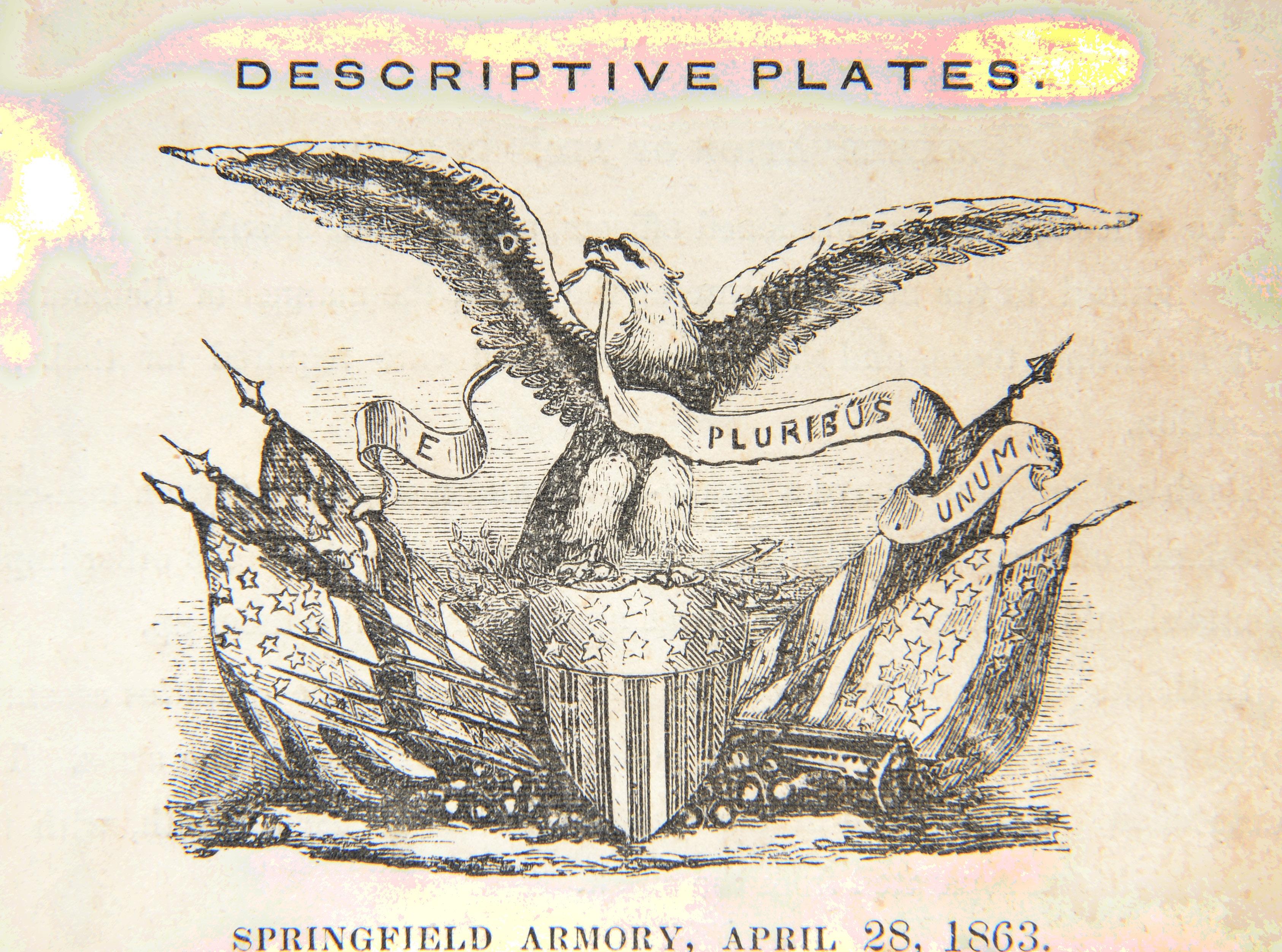








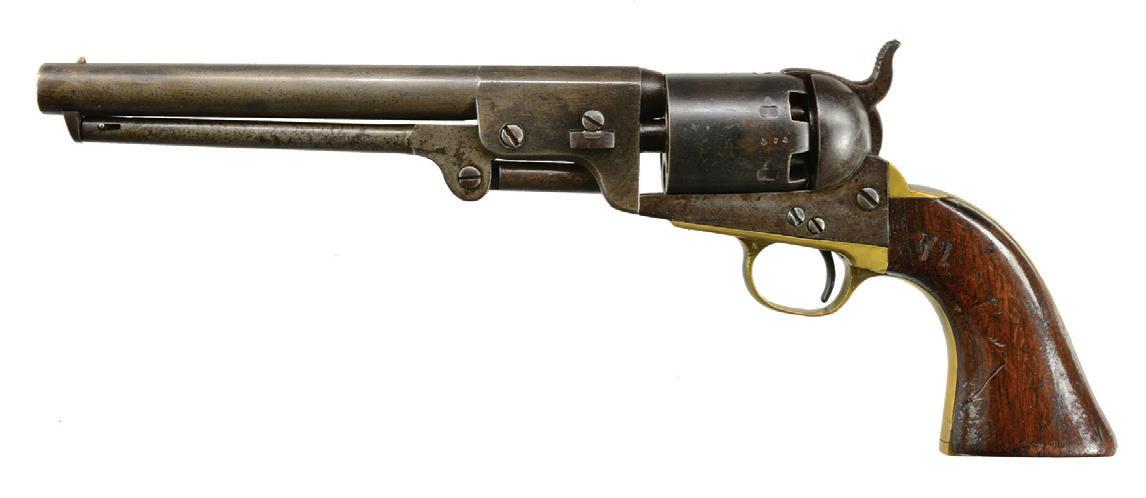


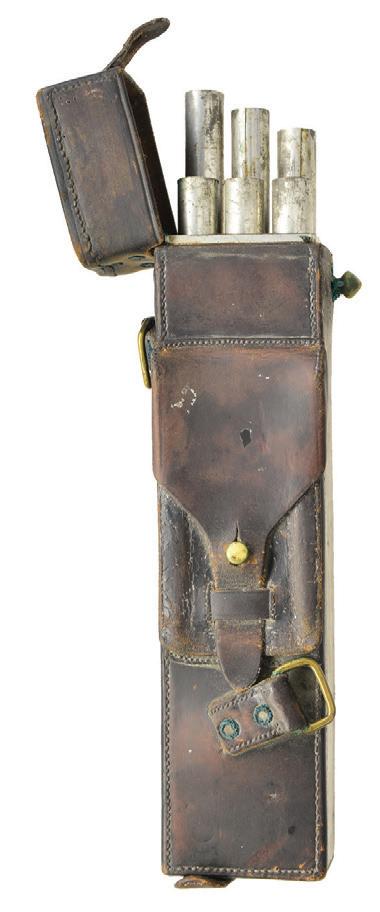
Firearms & Militaria Auctioneers civilwar@poulinauctions.com | poulinauctions.com | 199 Skowhegan Rd | Fairfield, ME 04937 | 207-453-2114 John Sexton Civil War Sales Coordinator Appraisals and Consulting civilwar@poulinauctions.com Magnificent Cased Presentation Sword of Gettysburg Hero General Alpheus Williams (est. $20,000 - 30,000) Stephen Poulin, ME Lic # 1115 Sold $41,710 Sold $41,125 Sold $38,185 Sold $36,425 Sold $23,500 Sold $23,500 Sold $23,500 Unique 1864 Patent Model For The Rare Civil War 6 Tube Blakeslee Cartridge Box (Est. $3,000-5,000) Sold $7,635 Fine Hand Sewn Civil War Era 13 Star Flag (Est. $3,000-5,000) Confederate Bilharz Muzzleloading Carbine (Est. $15,000-20,000) Rare & “As Found” Confederate Keen-Walker Brass Frame Breech Loading Percussion Carbine (Est. $20,000-30,000) 2nd Model Brass Frame Confederate Morse Breech Loading Carbine Made In Greenville, SC (Est. $15,000-20,000) Fine Cook & Brother Athens Georgia Confederate Percussion Carbine (Est. $20,000-25,000) Rare Leech & Rigdon Confederate Revolver (Est. $15,000-18,000) Sold $41,125 Accepting Consignments Call our offices to be part of our next Premier Firearms Auction! Rigdon & Ansley Confederate Revolver Carried By Captain Luther M. Clements, Co. F, 41st Alabama (Est. $25,000-35,000) View www.poulinauctions.com for more information






































 Mike Brackin
Mike Brackin











































































































































































 by Bob Ruegsegger
by Bob Ruegsegger












































 by John A. Punola
by John A. Punola








































































































































